(6th November 2023 Arvada, CO, USA) As industries accelerate into an era defined by nanoscale perfection and micron-level accuracy, for many applications the spotlight falls on the sophisticated configuration of gantries to include advanced features that allow the next level of precision within machine motion control systems. These configurations, once reserved for niche applications, have become the backbone of countless manufacturing processes. From the delicate assembly of semiconductor chips to the precision-driven world of medical diagnostics, getting the motion just right is not merely about quality — it’s about ensuring operational efficiency, reducing costly errors, and, in some sectors, guaranteeing safety. In this precision-focused age, ALIO Industries is leading the way, and has an innate understanding of such configurations, and knows that mastering them isn’t a luxury; it’s an imperative for manufacturers aiming to lead the vanguard of innovation.
A gantry configuration in ultra-precise motion control systems refers to a framework used to dynamically move over a relatively large area or workspace with incredible accuracy. This structure typically comprises linear axes that allow movement in multiple directions — often in the X, Y, and Z planes. Within the realm of ultra-precision, gantry systems are meticulously designed to minimize vibrations, thermal expansions, and other disturbances, ensuring that movements are consistent to the scale of microns or even nanometers, making them essential for tasks like micro-assembly or semiconductor fabrication. Additional rotational (yaw) motion pertains to movement around a vertical axis.
Beyond this traditional addition of further axes, ALIO offers a “Yaw Compliance” option that can be used on its configurable gantry robots contributing to their superior precision and +/- 1.5µm accuracy. The Yaw Compliance option is a virtual rotary axis allowing precise compensation for small angular misalignments that also may be used as an actual rotary axis for small intended angular motions.
Bill Hennessey, President at ALIO says, “There is a reason that customers engage with ALIO as they strive to innovate new manufacturing processes and products. Engaging with a motion control systems supplier like ALIO with a deep understanding of motion challenges is vital due to the inherent demand for precision and accuracy in many applications. Whether in manufacturing, or R&D, accurate multi-dimensional movement is crucial. A supplier well-versed in gantry configurations ensures the system offers consistent and reliable motion. Without such specialized knowledge, the risk of motion discrepancies increases, potentially compromising the application’s success. Also, every application has unique motion requirements, making it imperative to avoid a generic, one-size-fits-all approach. Suppliers like ALIO with in-depth expertise can tailor the design of the motion control system to suit specific application demands. This tailored approach not only enhances system performance but can also offer cost savings by eliminating unnecessary features or over-specifications. An optimized system design further benefits the end user by improving the system’s durability and reducing its maintenance needs over its lifetime.
The rapidly evolving nature of many industries means that machinery and equipment such as ALIO’s must also adapt and evolve. The company’s robust understanding of sophisticated configuration of gantries makes it better positioned to anticipate and adapt to future challenges and trends. This adaptability ensures the supplied motion control systems remain relevant and can be updated or modified as demands change, maximizing their usable lifespan and providing a more substantial return on investment for the end user.
In ultra-precise applications, the specifications of gantries are meticulously adapted to suit each task’s unique demands. The scale and reach of the gantry can differ significantly, with some applications necessitating compact, intricate setups, while others might require larger but equally precise systems. Meanwhile, yaw control can vary in its granularity and accuracy. The degree and precision of yaw adjustments needed can be influenced by the intricacies of the task at hand. Tailoring these configurations ensures that every application can meet its distinct precision benchmarks, and ALIO’s Yaw Compliance option contributes greatly to the exacting precision that can be achieved.
Hennessey concludes, “Working with a motion control supplier that lacks a comprehensive understanding of gantries and the addition of further motion axes can lead to significant challenges. Such oversight can result in systems that fail to deliver the required precision and accuracy, potentially causing production inconsistencies or product defects. The inefficiencies introduced might slow down production speeds, leading to operational delays and increased costs. Furthermore, improperly configured systems could face premature wear and tear, necessitating frequent maintenance or replacements. In critical applications, these shortcomings not only translate to financial losses but can also pose serious safety risks and jeopardize mission-critical tasks.”
(October 25th 2023, Arvada, CO, USA) Cartesian gantries are robotic and motion control systems that operate within a defined three-dimensional space based on the orthogonal X, Y, and Z axes of the Cartesian coordinate system. Utilizing linear motors, precision bearings and state-of-the-art geometric error compensation techniques these gantries enable precise movement along each axis, allowing for straight-line paths in any direction within the system’s defined workspace.
As industries evolve, there’s a push towards miniaturization, increased product complexity, and higher quality standards. In today’s industrial environment, highly precise Cartesian gantries are crucial due to the ever-increasing demand for accuracy, repeatability, and speed in production and manufacturing processes. Their simplistic and modular design allows for easy scaling, adaptability, and high repeatability, making them a popular choice for ultra-precise motion control.
These precise gantries allow for tight tolerances to be achieved in applications ranging from semiconductor manufacturing, 3D printing, and automated assembly lines, to scientific research equipment and medical devices. Additionally, in an era of automation and Industry 4.0, the integration of these accurate systems facilitates more efficient and flexible production lines, enabling quicker adjustments and responses to market demands. Thus, their importance cannot be understated as they directly contribute to increased productivity, reduced waste, and enhanced product quality, solidifying their role in the competitive industrial landscape.
ALIO Industries’ Cartesian gantries offer large work areas and superior positioning, ideal for a range of pick and place applications. The company’s Cartesian robots are built with precision linear guide rails or air bearings for movement across a horizontal plane, programming is simple, and they are adaptable to limited floor space constraints.
Bill Hennessey, President of ALIO Industry says, “In pick and place applications, the large work areas offered by ALIO’s Cartesian gantries offers a significant advantage by enhancing operational flexibility and efficiency. Such an expansive workspace allows the system to access and manipulate a broader array of components simultaneously, streamlining batch processes and enabling faster production cycles. Moreover, it accommodates the handling of larger products or the simultaneous processing of multiple smaller items, effectively increasing throughput. This spatial flexibility also means that the system can be easily reconfigured or adapted to handle diverse product sizes or types without substantial modifications, catering to the ever-changing demands of modern production lines. In essence, a larger work area not only boosts productivity but also ensures that the gantry remains versatile and adaptable to various pick and place requirements.”
ALIO’s combination of components and motion knowhow is the key to its production of Cartesian gantries that fulfil complex customer requirements. These include high performance motors capable of precision movement even with high payloads and mechanisms that avoid crashes (like having the z stage moving upwards/away from the product instead of falling down in cases of power loss). The structure of the machined parts of such a system must offer outstanding stiffness and be rigid to reduce vibrations and guarantee short settling times (again important for precision and overall throughput improving system efficiency).
Hennessey concludes, “ALIO’s Cartesian gantries are also ingeniously engineered to overcome traditional floor space constraints, ensuring optimal performance even in limited areas. A significant attribute of our design philosophy is modularity and efficient use of space. Furthermore, our commitment to precision ensures that every component and subsystem is optimized for compactness while retaining unparalleled accuracy. This means that even in constrained spaces our Cartesian systems can deliver the expected precision and repeatability. This makes them a preferred choice for industries where floor space is at a premium but high-performance motion control is non-negotiable.”
(October 11th 2023, Arvada, CO, USA) ALIO Industries (a Part of Allient) recognises that in the world of medicine and diagnostics, the immediate relevance of digital pathology is indisputable today. As healthcare systems worldwide face increasing demands and challenges, the need for more accurate and efficient diagnostic tools has never been more pressing.
Digital pathology, which involves the digitisation of tissue samples and the application of advanced imaging and analytical techniques, offers a transformative solution. This technology allows pathologists to remotely examine and analyse specimens with unprecedented precision, speeding up diagnosis and facilitating collaboration among experts across the globe. However, to harness the full potential of digital pathology, ultra-precise motion control systems are imperative, and companies like ALIO Industries are at the forefront of providing these critical components.
Bill Hennessey, President of ALIO Industries says, “Digital pathology applications demand ultra-precise motion control systems for several compelling reasons. First and foremost, the microscopic examination of tissue samples requires movements that are accurate down to the sub-micron level. The slightest deviation in motion can compromise image quality and diagnostic accuracy, making ultra-precision an absolute necessity. ALIO’s motion control systems excel in delivering sub-micron precision and repeatability, ensuring that imaging devices can precisely position and capture microscopic details. Furthermore, in the field of digital pathology, environmental factors like vibration and electromagnetic interference can be detrimental to image quality. Motion systems must, therefore, be designed to minimize these disturbances, guaranteeing the clarity and reliability of the images produced.”
The characteristics of successful motion control systems in digital pathology applications go beyond precision. They must be seamlessly integrated into the compact space and workflows pre-determined by the complex imaging system of the instrument. Moreover, durability is paramount, as these systems need to withstand continuous use in demanding laboratory environments. ALIO Industries not only provide ultra-precise motion control but also prioritise these additional features, ensuring their systems enhance the overall efficiency and reliability of digital pathology solutions.
Partnering with a motion control supplier like ALIO Industries is crucial for companies providing instruments for the digital pathology market. The expertise of specialised motion control suppliers can significantly expedite product development cycles while ensuring the highest level of precision and reliability. By collaborating with suppliers that have a proven track record in delivering accurate and repeatable motion systems, digital pathology OEMs can focus their resources on developing cutting-edge imaging and analysis technologies, confident that the critical motion control aspect is in capable hands. This collaborative approach is pivotal in driving innovation and advancing the field of digital pathology, ultimately benefiting patients, clinicians, and researchers by providing faster, more accurate, and reliable diagnostic tools for today’s healthcare challenges.
Hennessey concludes, “In digital pathology applications, achieving precise motion control often entails the utilization of advanced motorized platforms, which are equipped with either linear encoders or piezoelectric actuators. Linear encoders play a pivotal role by providing real-time feedback on position, ensuring the exact movement of specimens and slides. Meanwhile, piezoelectric actuators excel in offering exceptionally fine control, particularly when it comes to focusing and scanning tasks. Additionally, air-bearing stages find widespread use to minimize both friction and vibrations, which are critical factors for maintaining high-quality imaging standards. To further streamline the automation process, motion control solutions in the realm of digital pathology may incorporate robotic arms or loaders for the delicate handling of samples. ALIO’s robotic systems are meticulously engineered to handle specimens and slides with care, minimizing the potential risks of damage or contamination. Furthermore, these comprehensive solutions often seamlessly integrate with imaging devices and software, enabling efficient coordination and facilitating rapid scanning and image acquisition.”
As a proud member of the Digital Pathology Association, ALIO will be present during this year’s Pathology Visions in Orlando, FL from October 29th to October 31st. The company welcomes all attendees to come and discuss any digital pathology applications.
Digital pathology is in the news again today as it continues to drive diagnostic accuracy and facilitates global collaboration among pathologists, ultimately enhancing patient care and advancing medical research as it allows for the digitization of tissue samples. It does this by making it easier to store, share, and analyse medical data remotely. Additionally, it addresses the challenges of workforce shortages and provides opportunities for implementing artificial intelligence algorithms for more efficient and precise disease detection and classification. ALIO Industries is central to innovation in the digital pathology field providing an array of ultra-precise motion control systems that allow companies to continually innovate in this dynamic field.
Ultra-precise motion control systems are pivotal in digital pathology applications, where nanometer-level accuracy is essential for precise specimen manipulation and high-resolution imaging. This accuracy reduces motion-induced artifacts, resulting in higher-quality images critical for accurate diagnosis. Moreover, ultra-precise motion control systems support automation, streamlining workflows, and improving efficiency in digital pathology labs.
Bill Hennessey, President of ALIO Industries says, “Digital pathology machines demand precise motion control capabilities due to the need for nanometer-level accuracy in specimen scanning and imaging. These systems must precisely position microscope stages and imaging components to ensure that high-resolution images of tissue samples are acquired without motion-induced distortions or artifacts. Any inaccuracies in motion control can compromise the quality of digital slides, potentially leading to misdiagnosis or reduced research validity. Additionally, in automated digital pathology workflows, such as slide loading and sample handling, precise motion control is essential to avoid specimen damage, contamination, or misalignment.”
The integration of artificial intelligence (AI) algorithms in digital pathology applications relies heavily on precise motion control. The systems must accurately navigate the specimen slide to capture multiple fields of view for analysis, ensuring consistent and repeatable image acquisition. To achieve these requirements, motion control systems should provide real-time feedback and correction mechanisms to compensate for any deviations, maintain stability, and enable rapid, high-throughput scanning. In essence, the precise motion control demands of digital pathology machines are paramount in achieving accurate diagnoses, reliable research outcomes, and the successful implementation of AI-driven pathology workflows.
Hennessey continues, “Motion control solutions in digital pathology applications often involve advanced motorized stages equipped with linear encoders or piezoelectric actuators. Linear encoders provide real-time position feedback, ensuring precise specimen and slide movement, while piezoelectric actuators offer extremely fine control for focusing and scanning. Additionally, air-bearing stages are commonly used to minimize friction and vibration, crucial for high-quality imaging. To facilitate automation, motion control solutions in digital pathology may include robotic arms or loaders for sample handling. These robotic systems are designed to handle specimens and slides delicately, minimizing the risk of damage or contamination. Moreover, these solutions often integrate with imaging devices and software for seamless coordination, enabling rapid, efficient scanning, and image acquisition.”
Overall, motion control solutions in digital pathology such as those supplied by ALIO Industries to leading OEMs across the world are engineered to meet the demanding requirements of specimen manipulation and imaging, ensuring precise and consistent results critical for accurate diagnoses and efficient research.
Additive manufacturing is disrupting the manufacturing paradigm by fundamentally altering the traditional subtractive process of material removal. Instead of cutting, drilling, molding or machining raw materials, additive manufacturing builds objects layer by layer, directly from digital designs. This approach reduces waste, allows for complex geometries impossible with traditional methods, accelerates prototyping, and customizes production, revolutionizing industries by enabling rapid, efficient, and on-demand creation of intricate parts and products.
As additive manufacturing evolves into a production technology, precision and repeatability become increasingly crucial factors. In prototyping, minor deviations might be acceptable, but in production, consistency and accuracy are paramount. Precise layer-by-layer material deposition ensures that complex geometries are faithfully reproduced, meeting stringent design specifications. Moreover, as industries like aerospace, medical devices, and automotive rely on additive manufacturing for end-use parts, components must meet tight tolerances to ensure safety, performance, and compatibility within larger systems.
Repeatability guarantees that each part manufactured is virtually indistinguishable from the next, essential for assembly line integration and quality control. This consistency minimizes errors, reduces waste, and streamlines production processes. As additive manufacturing gains traction in fields with high-volume manufacturing demands, such as consumer goods and electronics, the ability to consistently replicate intricate and intricate structures amplifies the technology’s viability as a reliable alternative to traditional manufacturing methods.
THE ROLE OF MOTION CONTROL
Ultra-precise motion control systems are integral components within additive manufacturing machines, playing a critical role in achieving the high levels of precision required for producing complex and functional end-use parts. These systems govern the movement of print heads, build platforms, and other critical components with microscopic accuracy, ensuring that material deposition is exact and consistent across each layer of the printed object. By tightly controlling movements and positions, these systems minimize deviations and errors that could compromise the final product’s quality.
In additive manufacturing, precision is essential to create intricate structures, maintain fine tolerances, and achieve optimal surface finishes. Ultra-precise motion control systems contribute to precision by facilitating intricate adjustments, enabling rapid changes in direction and speed, and dynamically responding to real-time feedback from sensors. These systems eliminate the potential for vibrations, oscillations, or jitters that might degrade print quality. Furthermore, they enable additive manufacturing machines to compensate for variations in material properties, environmental conditions, and other factors that could impact the outcome of the printing process.
The seamless coordination of ultra-precise motion control systems with other critical components, such as advanced sensors and real-time monitoring, ensures that each layer of material is deposited with exceptional precision, resulting in complex geometries, functional prototypes, and end-use parts that meet the stringent requirements of industries embracing additive manufacturing for production purposes.
THE MOTION CONTROL RELATIONSHIP
An additive manufacturing machine manufacturer relies heavily on their motion control technology supplier to deliver a range of critical components and capabilities. First and foremost, precision is paramount. The supplier must offer motion control systems capable of nanometer-level precision to ensure that intricate layers of material are deposited with impeccable precision, allowing the creation of complex geometries and intricate details that meet exacting design specifications. This precision guarantees the production of high-quality end-use parts.
Additionally, repeatability is essential for consistent results in additive manufacturing. The motion control technology should provide exceptional repeatability, enabling the production of identical parts across different manufacturing runs. This consistency is crucial for industries like aerospace and medical devices, where quality assurance and regulatory compliance are of highest importance. The supplier must also offer advanced closed-loop feedback systems, integrating sensors and real-time monitoring to ensure that any deviations or errors are promptly detected and corrected during the printing process.
Furthermore, adaptability and scalability are key considerations. The additive manufacturing industry is rapidly evolving, with machines becoming larger, faster, and more sophisticated. The motion control technology supplier must offer solutions that can accommodate various machine sizes and types, seamlessly integrating with evolving printer architectures. This adaptability is essential as manufacturers seek to optimize productivity, reduce downtime, and accommodate new materials and processes. Lastly, collaboration and support are critical aspects. A reliable supplier should offer comprehensive technical support, training, and a partnership mindset, enabling manufacturers to optimize the integration of motion control systems into their additive manufacturing machines, ultimately contributing to the success of their products in the market.
MOTION CONTROL – THE SPECIFICS
Additive manufacturing machines typically employ a combination of linear stages, gantries, rotary stages, and multi-axis systems to control the positioning of print heads, build platforms, and other critical elements.
Linear Stages. High-precision linear stages are a critical component in additive manufacturing machines, facilitating controlled and precise movement along straight paths. These stages employ advanced technologies such as precision linear bearings, ball screws, and linear direct drives to ensure smooth and accurate translation of print heads or build platforms. By maintaining tight tolerances, these stages guide the deposition process with exceptional precision, allowing for consistent layer-by-layer material placement.
In additive manufacturing, accurate layer deposition is vital to achieving the desired object’s geometry and structural integrity. High-precision linear stages play a pivotal role in ensuring that each layer of material is positioned accurately based on the digital design. This level of control minimizes deviations and errors, resulting in printed parts that match the intended specifications. Whether it’s the intricate details of a complex model or the precise alignment of critical features, the capability of high-precision linear stages to enable controlled movement along straight paths significantly contributes to the reliability and quality of additive manufacturing processes.
Gantries. Gantries achieve highly accurate and controlled movements in industrial applications such as additive manufacturing. They serve the critical role of precisely positioning various components, such as print heads, build platforms, or other tools, in a coordinated manner during manufacturing processes. By executing intricate motion paths with minimal deviations, gantries ensures that the deposition of materials or the manipulation of objects follows predetermined trajectories with micron- or sub-micron level precision. This level of control contributes to producing complex and accurate 3D-printed objects, enhancing product quality, dimensional accuracy, and overall manufacturing efficiency.
Rotary Stages. A rotational correction is a common feature within additive manufacturing machines. These stages are designed to rotate objects or components with exceptional accuracy, making them well-suited for applications like continuous 360-degree printing, where cylindrical objects or structures require uniform coverage. Rotary stages allow the print head or material deposition mechanism to apply material around the entire circumference of the object, ensuring even distribution of material and consistent layer deposition.
Furthermore, rotary stages enable precise angular adjustments in additive manufacturing processes. Objects with intricate geometries, overhangs, or complex contours often necessitate controlled rotation to enable the deposition of material at specific angles. Rotary stages provide the necessary flexibility to position the object accurately, allowing the material to be deposited in alignment with the intended design, resulting in high-quality prints with intricate features and precise details. The versatility of rotary stages in enabling both continuous rotation and precise angular adjustments significantly enhances the capabilities of additive manufacturing machines, enabling the production of a wide range of complex parts and components.
Multi-Axis Systems. Multi-axis systems play a pivotal role in enabling complex and intricate movements. These systems involve multiple coordinated axes of motion, allowing for simultaneous control of translation, rotation, and even tilting of components. Multi-axis configurations are particularly important for producing objects with overhangs, undercuts, and complex geometries, as they provide the necessary flexibility to deposit material at various angles and orientations. These systems are crucial in ensuring that the printed structures maintain their integrity and quality throughout the printing process.
Closed Loop Feedback. Closed-loop feedback mechanisms are integral to motion control systems in additive manufacturing machines. These systems incorporate sensors, encoders, and real-time monitoring to continuously measure and correct deviations from the desired positions. By providing immediate feedback to the control system, closed-loop systems minimize errors and inaccuracies, ensuring that the printed objects adhere to precise design specifications. As the additive manufacturing industry advances, motion control systems continue to evolve, integrating advanced technologies such as predictive algorithms, machine learning, and adaptive control strategies to further enhance precision, speed, and overall performance during the printing process.
SUMMARY
Additive manufacturing applications demand ultra-precise motion control solutions like those offered by ALIO Industries due to the intricate layer-by-layer deposition process, necessitating nanometer-level accuracy to ensure high-quality and repeatable results. Moreover, partnership and customization of motion systems are essential for innovating next-generation additive manufacturing machines that push the boundaries of speed, accuracy, and versatility. Collaborative efforts between manufacturers and motion control suppliers enable the integration of tailored solutions, addressing unique challenges and unlocking novel capabilities in 3D printing, ultimately driving the future of the industry and enabling breakthroughs in various sectors.
(29th August 2023, Arvada, CO, USA) ALIO Industries — leading nanometer-level motion control system innovator — is well known for having developed mechanical bearing linear motion systems that can perform at levels that alternative “air” bearing stages struggle to attain. This is down to the company’s focus on 6-D Nano Precision®.
The newly published standard developed by the AMSE (B5.64 standard “Methods for the Performance Evaluation of Single Axis Linear Positioning Systems) seems to finally accept that to accurately characterize the repeatability of such high-end motion systems, a systematic process must be used to characterize the point repeatability of a stage along the entire axis, something ALIO has been advocating for over a decade.
Precision linear motion systems provide highly accurate linear motion along x, y or z axes. They typically consist of a linear guide rail, a carriage or slider, and a drive system. The guide rail provides support and guidance for the carriage, while the drive system creates the force necessary to move the carriage along the rail.
By adding precision ingredients like high resolution encoders, state-of-the-art machining, nano-precise metrology and tuning procedures, these systems can be used in a variety of applications where high accuracy and smooth operation are required, such as in semiconductor manufacturing, precision machining, and optical inspection.
Bill Hennessey, President of ALIO Industries says, “Because of the exacting nature of the applications where linear motion systems are used, it is vital that they can achieve ultra-high levels of repeatable accuracy. This is why ALIO’s linear motion products have been designed and manufactured to have no equal in terms of performance and reliability. The ‘6-D’ in 6-D Nano Precision® refers to the 6 dimensions of motion; linear, straightness, flatness, pitch, yaw and roll. Nano Precision refers to documented proof of performance at or below the +/- 450 nm level. 6-D Nano Precision® means the documented proof of performance over all 6 degrees of freedom of a body in motion at the nanometer level of precision. We are delighted that the new ASME standard recognises the importance of this approach, and it helps differentiate our linear motion systems from those designed and built to the 2-D world of planar repeatability and accuracy.”
All motion systems operate in 3-dimensional space and have errors in 6 degrees of freedom (6-DOF). However, motion systems are often only characterized by performance data of a single or subset of these 6-DOF. This practice leaves several error sources unaccounted for in performance data and specifications. ALIO contends that repeatability performance for metrology inspection and manufacturing systems must be analyzed and specified using a “point repeatability” method that accounts for 6D spatial errors in order to provide true representation of nanometer-precision performance. The ASME B5.64 standard for motion metrology shows that today standards organisations also see its importance.
Hennessey concludes, “The increasing precision of linear motion systems in particular and all motion systems in general requires a new language which transcends the use of terms like ‘precision’ and ‘resolution’ without any degree of qualification. ALIO’s use of Point Precision® and 6-D Nano Precision, and now the newly published ASME standard, redefine the way precision motion systems are measured. All such initiatives or activities in this area are ultimately of enormous benefit for end-users who should be able to specify solutions that can truly achieve what they need in respect of precision and repeatability. ALIO does not build legacy products and is acutely aware of the 6-dimensional errors associated with simple linear motion. As such, we design and manufacture our linear motion stages with these issues in sharp focus with unique manufacturing techniques and leading-edge components tested to NIST traceable nano results.”
All of ALIO’s linear stage product families exhibit world class performance, component choice being dictated by the demands of exacting applications and cost sensitivity.
(Arvada, CO, USA, 15th August 2023) ALIO Industries – an Allient Company — acknowledges the publication of the ASME B5.64 standard “Methods for the Performance Evaluation of Single Axis Linear Positioning Systems” last week as a significant step in the redefinition of measurement of precision in motion systems, something that as a company ALIO has been championing for over a decade.
The ASME standard suggests that when it comes to defining the precision of ultra-precise single axis linear motion systems such as those produced by ALIO, companies should move away from conventional planar methodologies, and towards 6D point precision specifications.
Bill Hennessey, President of ALIO picks up the story, “When analyzing motion control solutions that provide sub-micron and nanometer-level accuracy, ALIO has contended for a number of years that a new language is necessary, and new standards are required to indicate the real levels of precision that different motion control solutions can achieve. So saying, nearly 12 years ago, ALIO trademarked the phrases Point Precision® and 6D Point Precision® to protect its position in the market.
All motion systems operate in 3-dimensional space and have errors in 6 degrees of freedom (6-DOF). However, motion systems are often only characterized by performance data of a single or subset of these 6-DOF. This practice leaves several error sources unaccounted for in performance data and specifications. ALIO has contended for a considerable amount of time that repeatability performance for metrology inspection and manufacturing systems must be analyzed and specified using a “point repeatability” method that accounts for 6D spatial errors in order to provide true representation of nanometer-precision performance. The recent publication of ASME B5.64 shows that standards agencies also see the value behind this methodology.
Historically, specifying repeatability as a single number representing the variation in linear displacement along an axis of travel, i.e. plane repeatability was valid as the repeatability specifications were large enough that other error factors were only a small percentage of the total error and could be ignored. However, this test method makes a critical assumption, namely that the plane only moves in one dimension and the axis is perfectly straight. At the nanometer-level, this assumption is not realistic.
The new ASME standard recognises that in nanometer-level precision systems, ‘other’ errors that were previously ignored in less accurate systems often become equal to or greater contributors to the 6D repeatability performance. At the nanometer-level, the axis of travel should actually be shown as bending and twisting through three-dimensional space and thus plane visualization becomes meaningless as it will tip, tilt, and twist as the stage moves along the axis. The stage moves in 6D space, therefore neglecting these additional error sources can result in a misrepresentation of actual stage repeatability performance.
Each linear (or angular) direction the stage moves (or rotates) in results in a positional error in that direction. That motion, which must not be neglected when nanometer-precision is desired, will have an associated repeatability of that error motion. Each point on a stage mounting surface will move in 3D space as of a result of this error motion in 6-DOF. It is the point repeatability of an infinite number of points attached to a stage that must be characterized by testing and specification data. Thus, each point repeatability will result in a spherical repeatability range.
Hennessey concludes, “ALIO applauds the new ASME standard officially published and made available a few days ago. In our view, this is a very important step towards True Nano® Positioning, allowing customers the ability to choose the best motion system for their applications based on a common standard rather than believing misleading, single dimensional specifications that vary from supplier to supplier. Because ALIO has already been applying these newly published measurement procedures for over a decade, our customers find themselves in the lucky position of not having to worry about the true performance of their products. ALIO will continue to be at the forefront of innovation and progress in the precision positioning industry. The new standard methods for the performance evaluation of single-axis positioning systems can only be the beginning though. Today’s motion systems are more complex, usually consisting of not just one linear axis, but combining multiple axis to 2, 3, 4 or 6 or more degrees of freedom. ALIO is ready to drive these next steps with the ASME and all other contributors to the ASME B5.64 to further improve the transparency and creditability of the precision motion world.”
(25th July 2023, Arvada, CO, USA) Precision motion control systems play a vital role in ensuring high quality and consistency in micro-electronic assembly and testing, particularly when it comes to accurate and repeatable positioning of test probes. ALIO Industries (an Allient Company) is at the forefront of innovation in this area, and is able to provide motion systems that meet the incredibly exacting requirements that are common-place in such applications.
In micro-electronic assembly, the components are incredibly small and delicate, requiring precise placement and alignment. Precision motion control systems, equipped with advanced servo motors and encoders, enable micro-electronic manufacturers to position test probes with micron-level accuracy, reducing the risk of misalignment and potential damage to the sensitive components. This accuracy is critical for verifying the functionality of each individual component and ensuring that they work flawlessly within the intricate circuitry of electronic devices.
In addition, micro-electronic testing demands a high degree of consistency to detect even the slightest defects or variations in performance. Precision motion control systems allow for repeatable positioning of test probes during testing processes, ensuring that each component is examined under identical conditions.
By minimizing positional errors, these systems enable reliable and consistent data collection, reducing the likelihood of false positives or negatives in the testing results. This level of consistency is essential in producing reliable electronic devices, as any deviation or inconsistency in testing could lead to faulty products and costly recalls.
Bill Hennessey, President of ALIO Industries says, “The scale of the components being manipulated when testing and assembling micro electronic devices is regularly on the order of micrometers requiring reliable positioning in the low two-digit nanometers. At such small scales, even the slightest inaccuracies in positioning can lead to faulty connections, misaligned components, or inaccurate test results. At ALIO, we innovate high precision nanometer-level motion solutions that can overcome the challenges of testing and assembling micro-electronic devices by employing advanced technologies and design principles. Our solutions incorporate the most accurate linear motors on the market and high-resolution encoders to achieve nanometer-level positioning accuracy. Ironless linear motors offer precise and fast motion with outstanding responsive control at high bandwidths, ensuring that even the tiniest adjustments are made accurately. High-resolution encoders provide real-time feedback, allowing for closed-loop control and immediate correction of any positioning deviations.”
ALIO’s solutions also integrate sophisticated control algorithms and error compensation techniques to enhance accuracy further. Advanced control algorithms optimize motion trajectories, ensuring smooth and accurate movements. Error compensation techniques identify and correct systematic errors, such as thermal effects or nonlinearities, which can adversely affect positioning accuracy. By combining these technologies, ALIO’s high precision nanometer-level motion solutions can reliably and consistently address the challenges posed by microelectronic assembly and testing at such minuscule scales.
Hennessey continues, “ALIO’s rotary and linear motion systems provide high precision down to the nanometer level; excellent bi-directional repeatability, high levels of precision and accuracy, even after thousands or millions of cycles; fast response time, quickly responding to changes in position requirements, allowing for efficient and rapid testing and assembly processes; and minimal backlash ensuring that positioning remains accurate and consistent, even when changes in direction are required. As such, our precision motion control systems are indispensable tools in micro-electronic assembly and testing, guaranteeing the utmost accuracy and repeatability in positioning test probes and contributing to the overall quality and reliability of electronic products.
ALIO’s team of experts can be contacted today to discuss your specific testing and assembly requirements.
(19th July 2023, Arvada, CO, USA) ALIO Industries (an Allient Company) is at the forefront of innovation in ultra-precise and repeatable motion control systems, and as such is working to address the demands from manufacturers of increasingly complex and smaller and smaller integrated circuits (IC).
As complexity increases and size decreases, IC manufacturers lean more and more heavily on sophisticated metrology tools to validate the quality of finished products. Challenges especially escalate when looking at high volume manufacturing, where metrology tools are indispensable for ensuring quality control, optimizing processes, improving yield rates, enabling real-time monitoring, and keeping pace with technological advancements. They provide comprehensive inspection, precise measurements, and feedback on critical parameters, enabling manufacturers to detect defects, optimize processes, and maintain consistent quality throughout large-scale production. By investing in advanced metrology tools driven by best-in-class motion systems, manufacturers can maximize yield, reduce scrap rates, and proactively address deviations, ultimately ensuring the delivery of high-quality ICs in a competitive market driven by ever-advancing technology.
Bill Hennessey, President of ALIO Industries says, “Manufacturers of production and metrology equipment for small and complex ICs have unique and demanding requirements for ultra-precise motion control. They need motion control systems that offer sub-micron accuracy for precise positioning of tiny components, ensuring proper alignment and connection. High-speed operations are also crucial for efficient production throughput. Multi-axis control is necessary to enable synchronized movements in X, Y, Z, and rotation for accurate placement. These motion control systems must have a compact footprint, be flexible to adapt to different layouts, and provide long-term stability and reliability. Integration with automation is vital to streamline processes and maximize productivity. By meeting these demands, manufacturers can achieve high-quality IC production with improved yields and performance.”
In the fast-paced world of semiconductor manufacturing, metrology tools are part of the secret sauce that ensures perfection, and as such need to be controlled by bleeding edge motion control systems. They measure and inspect critical dimensions, overlay accuracy, and defects in integrated circuits, leaving no room for errors.
Hennessey continues, “With real-time feedback and control, these sophisticated tools empower manufacturers to make precise adjustments on the fly, boosting yields and slashing defects. It’s a game-changer for precision-driven production, where every measurement counts and perfection is the ultimate prize.”
ALIO Industries excels in creating motion control solutions for demanding metrology applications for a number of reasons. Firstly, ALIO’s expertise lies in delivering sub-micron accuracy and precise positioning required for measuring critical dimensions and overlay accuracy in ICs. Secondly, the company’s motion control systems offer multi-axis control and compact designs, catering to the intricate movements and space limitations of complex metrology systems.
Additionally, ALIO’s solutions provide the necessary stability, reliability, and adaptability to optimize processes, improve yields, and seamlessly integrate with automation in high-volume manufacturing environments. The company’s commitment to innovation and its deep understanding of the specific demands of metrology make them a trusted partner in delivering exceptional motion control solutions for these exacting applications, and it has the ability to customize solutions where required.
Hennessey concludes, “One notable example entailed the development of a semiconductor metrology low-profile XY-theta stage featuring a large open aperture. The design challenge involved an open frame stage with a configuration that hindered the implementation of a centered drive mechanism, thereby impeding the attainment of a symmetrical force distribution along the axis. ALIO successfully addressed this issue by creating a 300mm open center XY Nano Metrology stage. This stage exhibits a remarkable performance, characterized by a 3-Sigma, 6-D assessment encompassing parameters such as linear, straightness, flatness, pitch, yaw, and roll. Furthermore, the stage showcases a bi-directional repeatability within the range of less than +/- 250nm.”
ALIO’s team of dedicated engineers remains on hand to discuss your requirements when optimizing in the semiconductor industry.
ALIO Industries, an Allient company, is a leader in producing high-precision motion control systems with ultra-precise point and path positioning performance that is NIST-traceable. The company’s off-the-shelf and customized motion control solutions are the most precise and repeatable in the world, all backed by the industry’s first 3-year warranty. In this article Bill Hennessey, Founder and President of ALIO Industries gives his views on the ever changing and evolving demand for more and more precise motion control solutions, and discusses his and ALIO’s approach to the creation of technology that stimulates innovation across industry.
Q. Can you provide an overview of ALIO and its core focus as an ultra-precise motion control specialist technology supplier?
BH. From day one ALIO’s focus was to push the nanometer envelop using novel ideas from machining to assembly. Personally, I thought nanometer-level motion control was needed as far back as the JDS Uniphase Corporation (JDSU) days in the 1990s when they were designing and manufacturing a variety of products for optical communications networks. The Dense wavelength-division multiplexing (DWDM) optical transmission technology that took over from the JDSU technologies in the 2000s definitely needed nanometer-level motion control. For industries such as this where precision was so vital, quality was also a must as were motion control solutions that were robust industrial products not just devices to be used in a lab. I used my machine tool and industrial robots background to build quality, precise motion control systems that were fit for high volume manufacturing scenarios. At the same time as we applied for the patent for our novel Piezo Hybrid Hexapod, along came Dense Wavelength-Division Multiplexing (DWDM) optical transmission technology, and this industry suddenly did not need as many devices since a fiber could now carry many different channels.
Q. What factors do you believe have contributed to ALIO’s success in the motion control industry?
BH. We stayed the course and never sacrificed our integrity, focus, or reputation for quality by compromising the exacting precision levels that we pioneered. We have lost many orders over the years by telling customers the truth about what they could expect in terms of precision. Customers ending up with inappropriate or sub-optimal motion control solutions does nothing for the reputation of the entire motion control sector, and with this in mind we continue to put honesty in customer dialogue beyond anything else. From this, creating and providing pragmatic solutions that meet customer expectations can follow.
Q. Could you share some examples of how ALIO’s motion control solutions have delivered significant benefits to customers compared to traditional alternatives?
BH. We provide game changing products that are disruptive due their precision and quality across an array of industries and applications. Unfortunately, due to the strategic nature of the motion control solutions that we provide, we are usually unable to give specific details. However, I can tell you that we have customers that not only restrict us from mentioning them, but who ask (or even offer to pay a premium) for us not to place our name on the motion control systems we have supplied them so they can protect their technological advantage.
Q. What are the key application areas that ALIO is currently focused on in terms of providing ultra-precise motion control solutions?
BH. Metrology has always been an ALIO specialty, with the world’s top metrology companies using out products as their internal reference systems, and some as their OEM system. Ultra-fast laser processing, digital pathology, genome sequencing and a lot of semiconductor processing applications represent our key markets today.
Q. Are there any particular industries or sectors where ALIO’s technology has found the most success and impact?
BH. There are many, but in the area of Digital Pathology we perhaps exhibit our prowess most obviously. To ensure accurate and complete tissue sample analysis, high bi-directional repeatability to target small tissue areas is needed in digital pathology applications. ALIO provides monolithic, low-profile, open-center X, Y, Z electromagnetic driven stages for such applications, promoting high speed, high throughput, and low friction in a small footprint, scan times being reduced allowing better pre-scan images. Digital pathology is all about parallel paths or a serpentine motion to capture all the data points. ALIO is novel in that our straightness is superior to all other motion control options for this application. This promotes the compiling of data in one pass impossible if stages cannot move parallel with less than 2-3 micron variation. This also make for more precise data since it does not need to be calculated by 6 sigma algorithms that are necessary to get a result from poor motion performance.
We also excel in areas like 4K and 8K lens assembly, measuring optics for satellites, laser cutting of gems or sapphire, and genome sequencing all of which require exacting precision and / or the requirement to capture data at record speeds.
Q. How does ALIO stay ahead of emerging trends and technology advancements in the field of ultra-precise motion control?
BH. ALIO began focusing on nanometer-level motion control some 21 years ago, so we never stop thinking of the next generation trends and technologies. At this time, I would say that we are a decade in front of the competition. Without giving away too much, we are always looking at ways to measure and assemble new kinematic motion control solutions with novel materials, and this is an area of particular focus at the moment.
Novel materials can exhibit unique properties such as high stiffness, low thermal expansion, and exceptional dimensional stability, allowing for enhanced precision and accuracy in motion control applications. By incorporating these materials into the design of such systems, it becomes possible to minimize unwanted vibrations, reduce friction, and mitigate the effects of thermal fluctuations, thereby improving overall system performance. Furthermore, the introduction of novel materials can enable the development of miniaturized, lightweight systems with improved reliability, responsiveness, and energy efficiency, opening up new possibilities for advanced motion control in fields such as robotics, microscopy, and precision manufacturing.
Q. What is the company’s strategy for staying innovative and continuously improving its motion control solutions?
BH. Continuous improvement for us at ALIO is like breathing. We are always seeking to improve, and we always ensure we have a team of engineers at the top of their game.
Specifically, we promote continuous improvement by fostering a culture of innovation, collaboration, and feedback. We invest in research and development to explore emerging technologies, novel materials, and advanced algorithms that can enhance the precision, accuracy, and performance of our motion control systems. We actively engage with customers and industry experts to gather feedback and insights, allowing us to identify areas for improvement and address specific customer needs. This feedback-driven approach enables us to iterate on our designs, incorporate user-centric features, and refine our manufacturing processes. Additionally, we prioritize ongoing training and development for members of our team, ensuring they stay updated with the latest advancements and can contribute to the continuous improvement efforts.
By embracing this holistic approach, as an ultra-precise motion control solution provider we can remain at the forefront of innovation, consistently delivering state-of-the-art solutions that exceed customer expectations.
Q. Can you provide insights into any ongoing research and development efforts at ALIO aimed at advancing ultra-precise motion control?
BH. The challenge for ALIO is trying as far as possible to mitigate the costs of materials and software etc… that allows our nanometer-level precision motion control systems to operate in scenarios where environmental conditions in industrial settings are not ideal.
Building ultra-precise motion control systems operating in environmental conditions that include thermal deviations and vibrations poses significant challenges. The presence of thermal fluctuations introduces unpredictable dimensional changes in the system, requiring careful thermal management strategies to minimize their impact on positioning accuracy. Vibrations, whether originating from internal or external sources, can disrupt the delicate motion control mechanisms and degrade overall performance.
Addressing these challenges requires a combination of meticulous mechanical design, sophisticated control algorithms, and the use of specialized materials with low thermal expansion and high stiffness to minimize the effects of thermal deviations and vibrations. Additionally, advanced sensing and feedback systems, such as precision accelerometers and encoders, are necessary to continuously monitor and compensate for any disturbances, enabling the system to maintain the desired nanometer-level precision even in challenging environmental conditions.
Q. What steps does ALIO take to ensure that its customers achieve optimal results and maximize the performance of the motion control systems they purchase?
BH. Every machined part and indeed every assembly gets tested and approved before it leaves our facility. Most suppliers test stages not motion systems. But how can a customer be confident in a motion system that hasn’t been tested as solution. It is effectively nothing other than several individually tested stages stacked together, hoping the performance of individual stages have not been compromised in the process. By testing every motion systems before delivery we ensure it works perfectly on day one at the customer’s facility.
We also have a metrology lab that has few equals, and we have developed over the years our Point Precision® approach to motion metrology that has recently been adopted into ASME B5.64 standard for motion metrology.
All motion systems operate in 3-dimensional space and have errors in 6 degrees of freedom (6-DOF). However, motion systems are often only characterized by performance data of a single or subset of these 6-DOF. This practice leaves several error sources unaccounted for in performance data and specifications. ALIO has contended for over 20 years that repeatability performance for metrology inspection and manufacturing systems must be analyzed and specified using a “point repeatability” method that accounts for 6D spatial errors in order to provide true representation of nanometer-precision performance. The ASME B5.64 standard for motion metrology shows that today standards organisations also see its importance.
Q. What do you believe sets ALIO apart from other motion control technology suppliers in terms of its approach, expertise, or customer-centricity?
BH. Well, quite simply we have been doing this for 21 years, and the mission has always been the same, nanometer-level precision and quality . We always think out of the box, which is reflected in the definition of ALIO…. a new and better way!
We have never built a product without a customer application in mind. Where most build standard products, we have developed our portfolio of motion control solutions based on real world applications.
Q. In your opinion, what are the key qualities or factors that customers should consider when selecting a motion control solutions provider, and how does ALIO excel in those areas?
BH. Never take spec sheets from our competition at face value. Many quote “best-case” precision data, not the precision that can be met day in and day out repeatably.
Also, ask about warranty. If it is one year, then run for the hills. Customer application development can take years, so they need support for a long time to get over the learning curve.
In addition, ask your shortlisted supplier if they can prove they have what it takes to meet or exceed your requirements. Point Precision® in the ASME B5.64 standard is one way to make sure the product meets your need for the application. A reliance on old school planar data can be misleading, and in worst case scenarios can kill off projects due to under-performance.
Finally, look for evidence of a state-of-the-art metrology lab, and also a cleanroom for next-level assembly required by and increasing number of applications across industry.
If all of the above can be answered and demonstrated positively then you can only be at our facilities in Arvada. We look forward to working with you!!
ALIO Industries is proud to announce that it has just introduced an ISO Class 8 cleanroom to its Arvada, CO facilities with ISO Class 5 (US FED STD 209E: Class 100) workstations.
The cleanroom has been commissioned due to a substantial increase in demand for cleanroom manufacturing and handling, and the facility is fully equipped to handle vacuum and cleanroom products and requirements.
Peter Lehner, Director of Sales and Marketing at ALIO says, “Most of the demand for cleanroom manufacturing is driven by customers in the semiconductor, micro-electronics, and medical industries. Our new cleanroom not only enables contamination control, ensuring the production environment has minimal airborne particles that could compromise product quality (critical for industries that demand high levels of cleanliness to prevent defects or failures in motion control devices), but it also maintains process consistency by offering controlled conditions. The cleanroom simplifies adherence to industry expectations, standards and regulations, and also instills customer confidence by showcasing our commitment to quality, precision, and customer satisfaction for which ALIO is renowned.”
The cleanroom is another in a series of significant investments undertaken by ALIO which also includes on-going investment in maintaining and optimizing its metrology lab and equipment, allowing the company to guarantee the unique one-of-a-kind nanometer-level precision attainment for which it is world famous.
Bryan McCloskey, Operations Manager at ALIO says, “The continuous investment into lean manufacturing principles, our new cleanroom, and our growing metrology lab demonstrates our commitment to quality, cleanliness, and precision. Customers can trust our consistent and reliable products, innovative approach, adherence to standards, and long-term partnership potential, making them confident in receiving the highest-quality motion control solutions.”
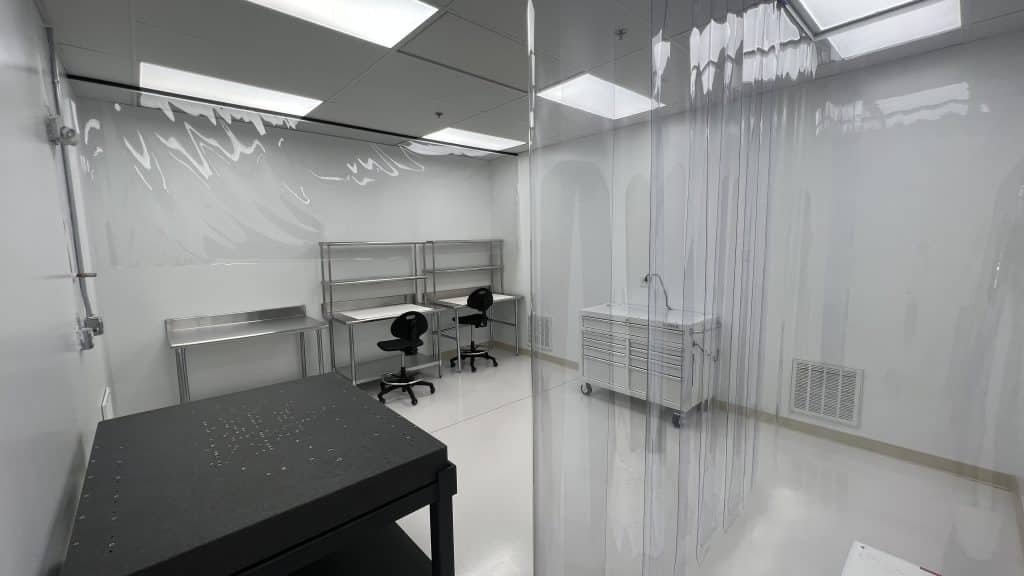
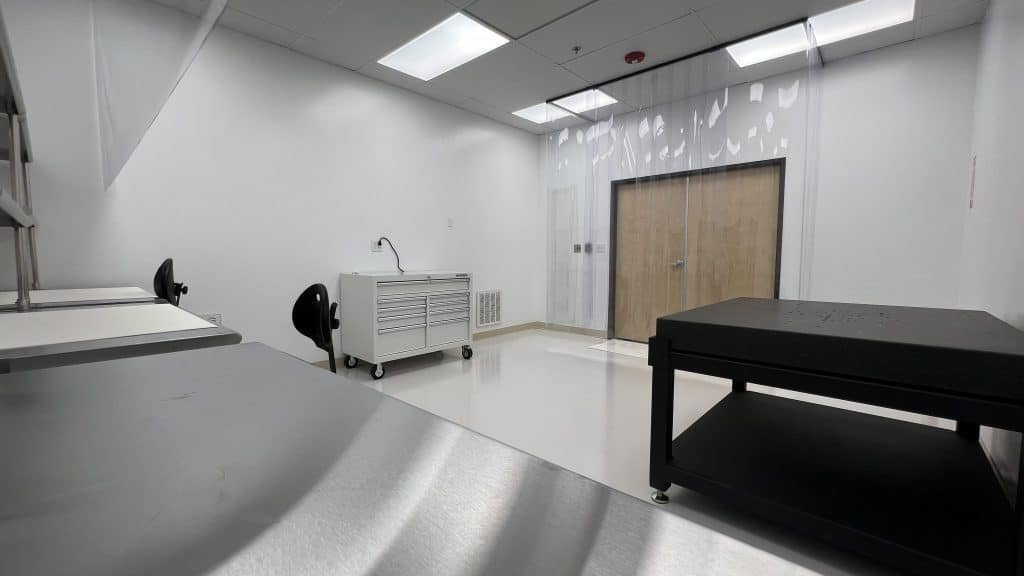
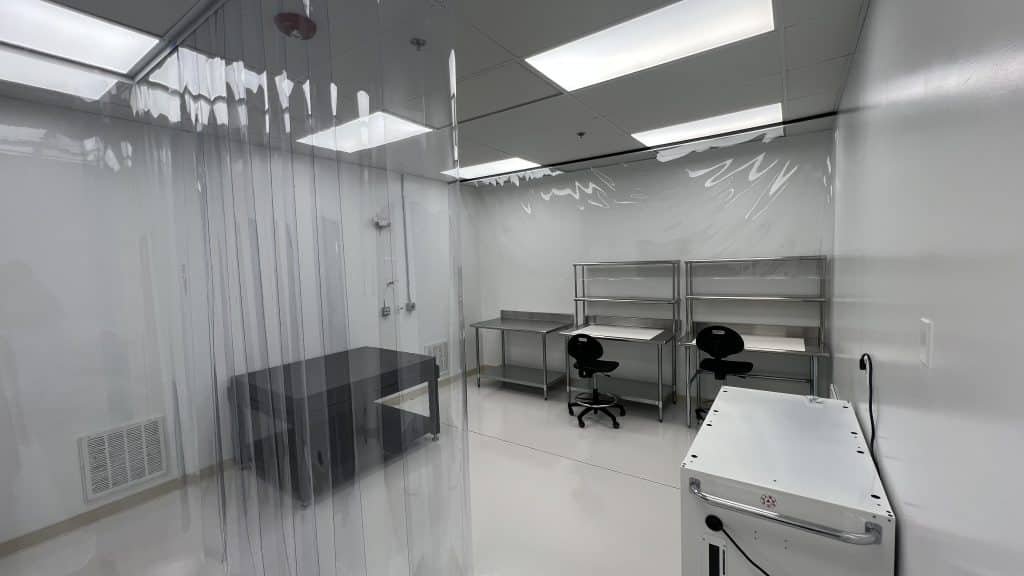
(June 5th 2023, Arvada, CO, USA) Additive manufacturing (AM) is crucial for manufacturers today because it enables the production of highly complex and customized parts that are difficult or impossible to achieve with traditional manufacturing methods. It offers increased design freedom, faster prototyping, reduced material waste, and the ability to create on-demand, decentralized production networks, all of which contribute to enhanced efficiency and competitiveness in the modern manufacturing landscape. AM has long disrupted the prototyping stage of product development, but recent advances in speed of operation, improved materials, and optimization software, now see AM becoming a disruptive force in production scenarios.
High-end, precise motion control systems are critical for the accuracy of additive manufacturing (AM) technologies due to their ability to deliver precise and coordinated movements of components. In AM, layer-by-layer deposition or selective laser sintering/melting requires precise control over the motion of the build platform, printhead, or laser. The accuracy of these movements directly affects the final dimensional accuracy and quality of the printed parts. With the right motion control systems, manufacturers can achieve tight tolerances, ensuring that each layer is accurately positioned and aligned, resulting in precise geometries and dimensional accuracy.
“Furthermore, precise motion control systems play a crucial role in minimizing errors, defects, and inconsistencies in the AM process”, says President of ALIO Industries Bill Hennessey. “Any deviations or inaccuracies in the motion can lead to misalignment, overextrusion, or insufficient material deposition, compromising the integrity and quality of the printed parts. High-end motion control systems offer advanced feedback mechanisms, such as encoders or sensors, that provide real-time position feedback to the control system. This feedback enables closed-loop control, allowing for immediate adjustments and corrections during the printing process, thereby ensuring accurate and consistent deposition of material layer by layer.”
As AM transitions from a prototype to a production technology, the importance of precise motion control solutions increases significantly. In prototyping, the focus is often on creating functional proofs-of-concept or small-scale models, where tolerances and accuracy requirements may be more relaxed. However, as AM evolves into a production technology, the need for precise motion control becomes paramount.
In production-scale AM, there is a higher demand for consistent and repeatable quality across large quantities of parts. Precise motion control ensures that each layer is accurately positioned, minimizing dimensional variations and maintaining the desired geometries throughout the production process. This level of control becomes crucial in achieving tight tolerances and dimensional accuracy, which is essential for meeting the specifications and requirements of end-use parts.
Moreover, precise motion control solutions play a vital role in optimizing production efficiency. As AM is adopted for production applications, speed and productivity become key factors. Precise control over the motion of components allows for optimized path planning, reduced unnecessary movements, and faster deposition rates. This increased efficiency leads to higher throughput and cost-effectiveness in production scenarios. Hennessey concludes, “ALIO Industries serves as a crucial one-stop-shop for all positioning requirements in AM applications, offering a comprehensive range of motion solutions. Our diverse portfolio, including XY-stages, 6D Hybrid Hexapods, gantries, and fully assembled motion solutions, caters to the varied needs of AM practitioners, simplifying the selection and integration process. By providing a single source for positioning components, ALIO streamlines procurement, ensures compatibility, and facilitates technical support, ultimately enhancing operational efficiency and reliability for AM system developers and operators.”
(May 26th 2023, Arvada, CO, USA) The demand for nanometer-capable stages is increasing exponentially as the trend to achieve greater precision and control in metrology and Nano Metrology applications continues.
With the advent of cutting-edge sensor technologies, measurement capabilities have become increasingly sensitive, enabling the detection and characterization of minute features and deviations in samples. To leverage the full potential of these advanced sensors, it is essential to have motion control stages that can move the samples or sensors with extreme precision and stability.
The ability to traverse several hundred millimeters while maintaining nanometer-level accuracy opens up new possibilities for research, quality control, and manufacturing processes that require intricate measurements and fine adjustments. As a result, the development of nanometer-capable stages has become crucial to meet the demands of modern metrology and unlock further advancements in various industries.
Any inaccuracies or errors in the motion can significantly affect the measurement results. Even minor deviations or vibrations during the movement of the sensors can introduce unwanted noise and artifacts, compromising the overall accuracy of the measurements.
“To overcome this challenge, motion systems must be engineered with exceptional precision and stability. They need to be capable of achieving sub-nanometer resolution and maintaining tight tolerances throughout the entire range of motion. By surpassing the accuracy of the sensors, these high-precision motion systems ensure that the measurements obtained are not limited or compromised by the motion itself, enabling researchers and industries to achieve the highest level of measurement accuracy possible,” explains ALIO Industries President Bill Hennessey
For such applications, ALIO provides its vertical Z-stages and monolithic XY bases. ALIO’s Z-stages stands out with their innovative design, offering a vertical solution that is completely linear-based and delivers performance comparable to air-bearing systems.
Hennessey continues, “What sets ALIO’s Z-stage apart is its exceptional precision, surpassing traditional Z-wedge solutions by an order of magnitude. This means that our Z-stage can achieve unparalleled levels of accuracy and stability in vertical positioning applications.”
By eliminating the drawbacks associated with traditional Z-wedge mechanisms, such as non-linearity and mechanical hysteresis, ALIO’s unique design ensures consistent and reliable vertical movement with sub-nanometer resolution, opening up new possibilities for nano-metrology applications and nanotechnology, semiconductor manufacturing, and optics manufacturing, enabling OEMs to achieve levels of performance that were previously unattainable with conventional solutions.
Using a vertical Z-stage on a monolithic XY base allows the customer’s payload to be mounted directly on the top of the stage in-line with the motor, encoder, bearings, and counterbalance, thus minimizing overhanging brackets and greatly reducing potential Abbé errors (optical distortions that occur due to the variation in focal lengths for different wavelengths of light, resulting in color fringing and reduced image sharpness).
ALIO’s XY monolithic stages introduce previously unheard-of straightness and flatness of travel with nanometer precision to reduce measurement uncertainty for metrology OEMs, ensuring more precise and reliable measurement data, which is crucial for quality control, research, and next generation manufacturing processes.
(April 27th 2023, Arvada, CO, USA) Leading nanometer-level precision motion control innovator, ALIO Industries, is meeting the exacting demands of OEMs producing cutting edge 3D metrology tools in what is a dynamic and ever more competitive sector as industry demands more and more accurate metrology solutions.
Market-leading metrology tools rely on high-quality sensors and encoders to provide accurate measurements of objects or surfaces. However, the performance of these components is intrinsically tied to the underlying motion system that positions and moves the measurement tools. The motion system must be at least as good, if not an order of magnitude better, than the sensors and encoders to ensure the required accuracy.
“There are several reasons for this. The motion system is responsible for the precise positioning and movement of the sensors and encoders during the measurement process,” explains Bill Hennessey, Founder and President of ALIO Industries. “Any errors in the motion system, such as mechanical backlash, hysteresis, or non-linearity, can introduce inaccuracies in the measurements, regardless of the quality of the sensors and encoders. By ensuring that the motion system is of equal or superior quality, these errors can be minimized, allowing the high-performance sensors and encoders to operate at their full potential.”
A stable and precise motion system is also essential for maintaining the position and orientation of the sensors and encoders during measurements. Any vibrations, drift, or fluctuations in the motion system can affect the accuracy of the readings. The chosen motion system should provide the necessary stability and precision to prevent such issues, ensuring that the sensors and encoders maintain their required accuracy.
The motion system’s resolution also directly impacts the measurements obtained by the sensors and encoders. If the motion system’s resolution is lower than that of the sensors and encoders, the overall accuracy of the metrology tool will be limited by the motion system. Therefore, it is essential to have a motion system with equal or higher resolution to fully utilize the capabilities of high-quality sensors and encoders.
In many 3D metrology applications, multiple sensors and encoders need to work in tandem, requiring precise synchronization between their movements. A high-quality motion system ensures that the various components can be accurately synchronized, allowing the metrology tool to provide reliable and consistent measurements.
The speed and responsiveness of the motion system are also critical factors in achieving the required accuracy. The motion system should move the sensors and encoders quickly and smoothly, without introducing errors or delays in the measurements. This enables the metrology tool to maintain its accuracy even when measuring large or complex objects.
As metrology tools evolve and improve, the demand for higher accuracy and precision will continue to grow. By using a motion system that is an order of magnitude better than the current sensors and encoders, manufacturers can ensure that their metrology tools are future-proof and capable of accommodating new technologies and advancements. “For such applications, ALIO provides near air-bearing performance crossed roller bearing XY Nano Metrology® stages with up to 450mm travel range,” explains Hennessey. “These stages use DC Servo linear motors with unmatched motion performance with 3-Sigma, 6-D (linear, straightness, flatness, pitch, yaw and roll) and bi-directional repeatability of less than +/- 250nm. In other words, the volumetric bi-directional repeatability of any XY point is within a sphere of 500nm or less.”
Near air-bearing performance crossed roller bearing XY Nano Metrology® stages are well suited as motion control solutions from compact 2D systems to large Field of View (FOV) 3D metrology tools due to their high precision, accuracy, repeatability, stability, large travel range, low maintenance, compact design, and adaptability. These characteristics make them an ideal choice for various industrial and scientific applications where high-performance motion control is required. Contact ALIO today to see how the company is keeping up with the demands of the metrology sector for ever more precise and unerringly accurate motion control solutions.
(April 18th 2023, Arvada, CO, USA) Accurate motion control is crucial in manufacturing medical and clinical devices like diagnostic imaging machines and video endoscopes. Even the slightest deviation from specifications can make a device less effective or even hazardous. To ensure the highest quality and safety standards, manufacturers must invest in precise and dependable motion control technology. This guarantees optimal results for patients using their products.
ALIO provides the AngularesTM Hybrid Hexapod® for such applications, which accommodates large XY movement to shift the instrument from process step to process step, there being 6 axis movement at every process step without the need of manually moving the instrument or using an additional robot to handle components. The AngularesTM exhibits low friction, low particle generation, is easy to access and clean, and maintains the highest precision. Highly flexible programming enables 4K (and beyond) image quality even using the tiniest and angled endoscopes thanks to the unique ranges of the system.
Bill Hennessey, President of ALIO says, “The 60-degree tip/tilt travel of the AngularesTM Hybrid Hexapod® is by far the most angular travel range available from any 6-Degree-Of-Freedom (6-DOF) positioner on the market and offers the same unmatched positioning performance found in any of ALIO’s full-line of Hybrid Hexapod systems. The AngularesTM features precision crossed roller bearing guides, optical incremental or absolute encoder feedback on all axes, linear motor and/or servo ball screw drives, unlimited programmable tool center point locations and coordinate offsets, and zero backlash on all axes. The design makes the AngularesTM capable of unlimited XY travel, Z travel for 62 mm which can be increased to 208 mm using other tripod models, tip/tilt travel of 60 degrees (+/- 30 degrees) with continuous 360 degree Theta-Z, XYZ bidirectional repeatability of less than +/- 0.6 arc-seconds, velocity up to 100 mm/second XY and Z, and less than 10 nanometers linear and 0.1 arc-seconds angular minimum incremental motion.”
The AngularesTM is part of the Hybrid Hexapod family of motion control systems produced by ALIO, the Hybrid Hexapod itself being developed to address the inherent performance limitations of conventional hexapods. ALIO’s patented 6-DOF design seamlessly blends and takes advantage of the strengths of serial and parallel kinematic structures while avoiding their weaknesses. The Hybrid Hexapod offers far greater functional versatility, nanometer-level accuracy, repeatability, and superior 6-DOF trajectories than is possible with any traditional hexapod or stacked stage configuration.
Hennessey continues, “Standard hexapods satisfactorily service applications where micron motion tolerances are required, but as the demand for nanometer requirements expands, standard hexapods struggle. This is because there are performance limitations inherent in all ‘conventional’ hexapod designs. They operate within 3-dimensional space, and have errors in all 6 DOF. However, hexapod motion systems have typically only been characterized by performance data of a single degree of freedom. This practice leaves error sources unaccounted for in several degrees of freedom, especially in the areas of flatness and straightness, which are critical precision needs at the nanometer-level required in many medical and clinical devices.”
The unique design of the Hybrid Hexapod® is comprised of a parallel kinematic tripod to deliver Z plane and tip/tilt motion. This tripod is integrated with a monolithic serial kinematic stage for XY planar motion. A rotary stage integrated into the top of the tripod (or beneath depending on application needs) provides 360- degree continuous (Theta-Z) rotation. In this hybrid design, individual axes can be customized to provide XY travel ranges from millimeters to virtually unlimited ranges while maintaining nanometer-levels of precision. Novel forward and inverse controller kinematics provide an unlimited number of programmable tool center point locations plus unmatched path precision and performance.
The 60 degree tip/tilt travel of the AngularesTM Hybrid Hexapod®, by far the most angular travel range available from any 6-DOF positioner on the market, in addition to providing an ideal motion control system for an array of medical and clinical device applications is also perfectly suited for aspheric and freeform optical metrology, silicon photonics packaging and probing, laser micro processing (non-planar substrates and taper control), wafer metrology, camera module alignment and assembly, sensor/image stabilization testing, and optical element and fiber alignment.
(March 28th, 2023, Arvada, CO, USA) Genome sequencing is a powerful tool that can help unlock many secrets about both the natural world and the human body. As the demand for faster, more accurate genome sequencing increases, so does the need for ultra-precise motion control systems which are critical for ensuring that the sequencing process is as efficient and accurate as possible.
Ultra-precise motion control systems provide the high levels of accuracy and speed required for genome sequencing applications. By using these systems, genome sequencing can be performed more quickly and with greater accuracy than ever before. This is essential for ensuring that the results of genome sequencing are as accurate and reliable as possible.
Bill Hennessey says, “Motion control systems are driving the field of genome sequencing, which is bedevilled by high cost and low throughput issues, and the problem of handling massive data sets. Automation is a particularly challenging element in the complex instrumentation used, but has played a vital role in genome sequencing, from the development of automated DNA sequencing machines to the use of robotic systems for sample preparation. Automation has helped to speed up the process of genome sequencing and has made it possible to sequence larger genomes more accurately and cost-effectively.
ALIO promotes increased throughput, reduced run time, and lower costs per run coupled with high quality and repeatable imaging by creating a smoother, continuous scan process using a monolithic XY stage and a low friction vertical Z-stage for focusing.
Z focusing can compensate for both variation in the sample and the flatness variation of the XY stage. The ideal technology for achieving the optimum move and settle time is a linear motor stage with a magnetic counterbalance. The linear motor allows for maximum acceleration and deceleration and provides exceptional position stability.
For genome sequencing, where even minor variations in the stage velocity or drift of the trigger clock can cause poor imaging, ALIO is renowned for providing market-leading motion control solutions.
Hennessey continues, “At ALIO we are aware that motion control systems are critical enabling technologies for genome sequencing applications because they allow for precise and accurate movements of the sequencing equipment. This is essential for ensuring that the sequencing process is performed correctly and producing accurate results. They provide accuracy and precision to the process by ensuring that samples are handled correctly and efficiently. Additionally, larger travel ranges allow more samples in the system at one time, and this means the system requires less opening, which reduces the chance of contamination and reduces down times. By utilizing ALIO’s advanced motion control technologies, researchers can achieve significant cost savings while delivering reliable results with greater precision than ever before.”
The future of genome sequencing is incredibly exciting and to a large extent is driven by ever-more sophisticated DNA sequencing technologies. ALIO remains focused on ensuring that the motion control systems it develops for genome sequencing are consistently rapid, accurate and affordable. In this way, the company is proud to help scientists unlock previously hidden secrets about the genetic code of life on Earth, the biology of disease, and the development of new treatments and diagnostic tests.

Digital pathology instruments are important tools in modern medicine, allowing for the digitization of slides and images, which can be stored, shared, and analyzed more easily than with traditional microscopes.
Digital pathology offers a number of patient and efficiency benefits. For patients — due to high throughput and high speed — it reduces waiting times, provides more precise diagnosis, and can obviously stimulate faster treatment with all this implies in terms of better clinical outcomes.
In terms of efficiency, the nature of the process also enhances the quality of the pathology work-flow. Digital pathology is more accurate and quicker than microscopy, prior case data can be speedily accessed, and data storage allows for long-term predictive analytics. In addition, the sophisticated nature of digital pathology instruments means the ability to offer live zoom and multiple angle views, and the ability to measure multiple areas of interest. All this improves productivity in the short-and long-term.
Digital pathology is driven by ultra-accurate and repeatable motion control systems, and ALIO Industries is proudly providing next-generation motion control solutions to the sector thereby advancing the speed and accuracy of imaging machines.
Bill Hennessey, President ALIO Industries says, “Our stages are perfect for the high-speed, high-quality scanning or imaging necessary for digital pathology. Offering solutions bespoke to the respective instrument’s architecture, we ensure that the final digital pathology instrument occupies minimal space in any laboratory or clinic situation. When scanning slides under a static microscope or camera, an XY(Z) motion control stage shifts the slides to capture images. For this to be effective, image capture must take place quickly and accurately meaning a motion control solution with smoothness (ensuring high resolution images), flatness (ensuring proper z-axis focus), and straightness (reducing overlap between scanning passes while increasing productivity).”
The ability of ALIO stages to move straighter than any other stage on the market means that they allow the production of data with higher resolution and accuracy than from any other motion control supplier. The company offers numerous off-the-shelf options but stages are also customizable, meaning that ALIO can work in partnership with digital pathology providers at the design stage of process development, achieving the most efficient motion control solutions for specific customer applications.
Hennessey continues, “To ensure accurate and complete tissue sample analysis, high bi-directional repeatability to target small tissue areas is needed. ALIO provides monolithic, low-profile, open-center X, Y, Z electromagnetic driven stages for such applications, promoting high speed, high throughput, and low friction in a small footprint, scan times being reduced allowing better pre-scan images. Digital pathology is all about parallel paths or a serpentine motion to capture all the data points. ALIO is novel in that our straightness is superior to all other motion control options for this application. This promotes the compiling of data in one pass impossible if stages cannot move parallel with less than 2-3 micron variation. This also make for more precise data since it does not need to be calculated by 6 sigma algorithms that are necessary to get a result from poor motion performance. “
The future of digital pathology is very exciting. As more pathologists adopt this technology, ALIO will continue to innovative new motion control solutions that make digital pathology machines even more efficient and effective.
Laser inscription is a rapidly growing field and an important component of many industrial production processes. In order to achieve the most precise results, repeatably precise motion control systems are essential. These systems provide the exact positioning accuracy and speed needed to keep up with the demands of high-volume and high-precision laser inscription applications. However, not all motion control systems are created equal.
Having recognized that most laser marking systems are restricted to operating in two-dimensions, and can therefore only scan on the and x and y axes (and in addition also lack the ability to process materials that have a high hardness of low ignition point) ALIO created a range of multi-dimensional motion control systems ideal for demanding inscription applications.
Bill Hennessey, President of ALIO Industries says, “There are several drawbacks to using a laser inscription motion control system that only works in two dimensions. First, the system is limited in the types of objects it can engrave or cut. Basically, it can only add inscriptions to surfaces facing the marking system, so objects with complex shapes or raised surfaces cannot be engraved with the precision and therefore the quality needed by many customers. Second, 2D systems are also limited in the height of features they can engrave or cut. In addition, 2D systems are also limited in the accuracy of the engraving, as the laser beam is not always able to follow the contours of an object accurately, so the inscription may not be precise.”
A particular and important application is the inscription of diamonds. Without causing any damage, a micro-laser beam is used to etch a microscopic inscription on the girdle of diamonds. The often complex shapes of diamonds mean that 2D inscription machines struggle to provide neat engravings. The need for a 3D or 3D+ solution that is at the same time speedy, precise and repeatable is obvious. Such a solution would also after initial capital outlay save money by reducing the potential for scrap and through improved inscription quality reduce the need for costly post-processing.
There are many reasons why 3D and 3D+ motion control systems are superior for laser inscription applications. For one, they allow for more precise and accurate laser beam positioning, using as they do a three-dimensional axes of movement, which means that the laser beam can be positioned more precisely on the surface of the material being inscribed.
Another reason is that they offer a greater degree of flexibility in terms of the size and shape of the inscribed area, there being no limitations, as the laser beam can be moved freely in three-dimensional space. This allows for much larger and more complex inscribed shapes and designs.
Finally, they also offer a higher degree of speed and efficiency in terms of inscription. With a high quality 3D or 3D+ motion control system the motion profile is optimized promoting straight parallel movements, and ‘real’ corners rather than curves.
Hennessey concludes, “To overcome the limitations of traditional 2D inscription machines, ALIO has developed compact x, y, z motion control systems, gimbal systems with up to 5 axis, and Hybrid Hexapods® that exhibit smooth travel, high stiffness, and low dither which all enhance the clarity and versatility of the inscription. Our compact x,y,z motion control systems are designed to provide high performance and precise positioning capabilities in a small footprint. Gimbals and Hybrid Hexapods® are meant to maximize flexibility, and improve quality on complex forms and hidden spots. These systems utilize precision motors for each axis of travel, providing high thrust force and low inertia for rapid acceleration and deceleration. Integrated position feedback sensors ensure precise positioning and repeatability, while programmable motion controllers allow for custom movement profiles to be created. They are ideally suited to laser inscription applications where fast and precise motion control is required in a limited space.”
The motion control sector is crowded with solutions for an array of applications across industry, and it is sometimes difficult for a non-motion control expert to navigate the plethora of information and data sheets that lay claim to describing the ideal customer solution. When looking at the area of ultra-precise (sub-micron to nanometer-levels of accuracy) the number of players is reduced, but it is probably fair to argue that the amount of information supporting claims of precision are even greater (and to a large extent more difficult to understand.)
It is undoubtedly the fact that this forest of information, claims, and counter-claims can be confusing for customers, and this confusion can lead to the purchase of motion control solutions which are either over-engineered and more expensive than some applications require, or more likely unable to achieve the required level of precision repeatably to satisfy the demands of manufacturers working in exacting industry niches.
This situation is unsatisfactory for customers and vendors alike, and there is a need for some degree of clarity that helps customers to partner with the best vendor for their specific applications and requirements.
At ALIO Industries, working at the nanometer-level of precision, a significant step towards providing this clarity was recently introduced as we launched our on-line product configurator. Through the configurator, customers can put in headline application requirements, and are then presented with viable solutions. So if users know the direction of motion required; the basic product type (i.e. linear motion, z-lift vertical stages etc.); application specific needs (i.e. smooth continuous movement, step and settle etc.); open center or closed; travel range; maximum weight of payload; level of bi-directional repeatability; and the environment the application is to be used in (ambient, cleanroom, or vacuum); the product configurator will display ALIO’s relevant options with each application requirement displayed graded best fit, good fit, or just fit. This is a major step forward for customers looking to specify motion control options.
But in addition to such tools, it is important that customers know what it is that they should ask of motion control suppliers before they are short-listed to avoid the waste of time and resource of first entering into lengthy consultation with a supplier that does not fit in with key criteria, and second — and most detrimental — actually investing in a motion control solution that is not optimal for the requirements of a specific application.
Bald statements about accuracy can on occasions obscure enormous differences between the capabilities of vendors in terms of repeatability, and motion control solutions being fit for purpose. Starting from the premise that if a good motion control solution is expensive, a bad one (with all this implies in terms of time delays and costs of re-investment in a suitable motion control solution) is REALLY expensive, in this article, I attempt to arm manufacturers with the questions that they need to ask to ensure that the motion control solution option chosen is right first time and up to the job. These questions should ideally focus on not just capabilities but also values.
This may seem like an odd question to ask a motion control technology provider, but it does actually get to the heart of the difference between some vendors. Most vendors sell off-the-shelf solutions and leave their customers to align them with their specific applications. In a way, this demotes motion control to a necessary evil, a link in a process chain that is expensive and complicated. But when your vendor provides truly cutting-edge sub-micron or nanometer-level accurate and repeatable motion control solutions, it elevates motion control from a necessary evil to an enabling technology. If a vendor provides the best-in-class, most accurate, and most repeatable motion control solutions on the market, they will be able to push the boundaries of what customers may see as possible, and will therefore promote the ability to manufacture innovative, bleeding-edge products that stimulate competitiveness. Try and assess your short-listed vendor’s view of motion control. Do they see obstacles and problems, or opportunities and solutions?
The range of applications for which precision motion control solutions are needed is vast, and in many instances off-the-shelf solutions are not the answer. To be able to customize motion control solutions, it is vital that your chosen vendor is in full control of every step of the production process as it is only through this intimate knowledge of the construction of stages that vendors will be able to adapt them optimally. When working in a world where sub-micron and nanometer-levels of accuracy are the norm, it is also preferable that motion control products are manufactured in one facility. Ask your vendor whether they have design, machining, metrology, manufacturing, and assembly under one roof. In other words, what steps of the manufacturing process are insourced or kept in-house to ensure consistently high quality while maintaining necessary flexibility. If the aspiration is to produce optimal end-use motion systems, that aspiration needs to be reflected in the manufacture of each component of the finished system. The cross collaboration between product development teams is important when trying to produce reliable and repeatable ultra-precise motion control solutions, and vertical integration is disproportionately important as the demands for accuracy move from micron-level to sub-micron and nanometer-level precision.
The sign of a cutting-edge motion controlsupplier, and one that will be able to fulfil your requirements with future-proof solutions, is evidence of innovative solutions that redefine the motion control market, where motion system developers think out of the box. Here you should be looking for signs of next-generation “blue ocean” technologies, not variations of legacy traditional motion control technologies. This is like the difference between vendors selling hexapods and a company like ALIO selling next-generation Hybrid Hexapods, which overcomes process limitations in traditional hexapods, and exhibits orders-of-magnitude improvements in precision, path performance, speed, stiffness, and larger work envelope. Nanometer-level repeatable motion control is achieved by pushing the envelope, not tweaking old technologies to squeeze out ever decreasing increases in accuracy. Check out your vendor’s portfolio of products, the customized solutions they have provided, and the level of innovation that is evident in creating new solutions and their ability to understand and apply their expertise to stimulate innovation in your application. Also, check out the warranty that your vendor is willing to extend. This is a sure-fire way of understanding the level or confidence they have in their own solutions.
Pinning down motion control vendors over statements of precision can be a minefield. Ultimately, claims on sub-micron and nanometer-level precision is meaningless unless the precision is achieved repeatably. Vendors that may struggle to achieve repeatable precision in motion control may publish “typical specifications” and “guaranteed specifications”. Typical specifications will show what “could” be possible and are often more precise than the precision levels that can be guaranteed. This can be extremely confusing for customers. Aware of such issues, ALIO Industries, talks in terms of Point Precision referencing performance specifications to a point in space at the single digit micron or nanometer level, and NIST has now produced the ASME B5.64 standard “Methods for the Performance Evaluation of Single Axis Linear Positioning Systems” which advocatesa new method for defining the precision of advanced motion control solutions similar to suggestions made by ALIO Industries moving away from conventional planar methodologies. It is important that customers interrogate precision claims diligently before a making motion control technology purchase in order to specify a solution that can repeatably achieve the levels of precision required.
It is likely that your application will be best suited if vendors sell you motion control “solutions” not just “products”. The key is to be able to customize motion control solutions to specific customer applications in order to optimize outcomes. When working in the area of sub-micron and nanometer-level motion control, your chosen vendor should be able to demonstrate extensive experience working at these levels of precision, and should preferably be entirely focussed on ultra-precise solutions. A vendor should be able to prove its credentials and demonstrate that it has provided a significant number of best-in-class, efficient, and cost-effective sub-micron and nanometer-level motion control solutions for an array of different industry applications. Ask your chosen vendor for evidence. All claims made should be able to be substantiated.
For success when the requirement is for sub-micron and nanometer-levels of repeatable motion control, there is much to be said to work with a vendor that places an emphasis on strategic partnership in product development. This will increase your confidence in achieving your challenging motion control and manufacturing goals in a timely, efficient, and cost-effective way. Key is early-stage engagement with your chosen vendor, and a willingness for the vendor to truly become embedded in the development of your end-use products and associated motion control solutions. Wherever possible, standard off-the shelf solutions should be found that fulfil the requirements of customer applications, but your chosen vendor should also be able to customize solutions when necessary to fulfil special application requirements. Seek evidence that your short-listed vendor sees the importance of full partnership, collaboration, and engagement as a way of providing quality, speedy, and cost-effective outcomes.
It is surely true to say that the key driver behind the competencies of any company is its team, so you need to drill into the experience and technical know-how. When your requirement is for sub-micron and nanometer-level motion control, you need to make sure that your vendor has a team with a dedicated focus that will translate into innovative and cutting-edge motion control solutions. Much of this is about the culture you will see in a vendor company. Assess whether you detect a “can do” attitude and whether your vendor seems to nurture a collaborative environment. But above all see if you can feel a passion running through your vendor’s team. If the passion is there, honesty and integrity will often follow, and with that will come trust. And it is ultimately trust that you need to bottom out when choosing a vendor. You need to trust that the motion control solution that you buy fits your requirements, and this is comes down to the team ethos that runs through all inter-connected departments in the company.
Precision motion control plays a crucial role in optics testing and assembly by ensuring precise and accurate movement of optical components during the testing and assembly process. This helps to achieve high accuracy and repeatability in testing results and ensures proper alignment and positioning of components for optimal performance in assembled optical systems. ALIO Industries’ precision motion control systems provide precise and controlled movement of optical components in X, Y, Z dimensions, and rotation, allowing for precise manipulation and measurement of optical elements.
Bill Hennessey, President of ALIO Industries says, “Camera array modules, translational OIS, telescopic integrated lenses for miniature cameras (used in everyday products like cell phone cameras and drones) all consist of various lenses. The industry trend is towards higher resolution 4K and 8K lenses in smaller and smaller areas, requiring increased precision in all 6 motion axes to achieve these combined objectives. Precise positioning of each lens is crucial for sharp, distortion-free images. As all lenses have different diameters, a highly flexible system with multiple tool-center points is needed allowing the various components to be handled precisely and reliable, thereby cutting down tool costs, production time, and scrap. For such applications, ALIO has developed the MINI Hybrid Hexapod® which is ideal for automated lens and camera alignment/bonding to CCD arrays. Any application requiring 6-degrees of freedom positioning with nanometer/arc-sec levels of incremental motion and repeatability is a good fit for this motion control system where product sensor resolution improvements are driving the need for higher precision.”
The MINI Hybrid Hexapod® developed by ALIO Industries is a precision motion control solution that combines the stability and accuracy of a traditional hexapod with the agility and flexibility of a gantry system. This makes it a suitable solution for optical testing and assembly, where precise positioning and alignment of optical components is required.
The MINI Hybrid Hexapod® provides high accuracy and stability, fast and precise motion, and flexible positioning, making it a versatile tool for a variety of applications.
Currently the smallest of ALIO’s Hybrid Hexapod® line, the MINI is compact but still provides a 54,000 mm2 working volume (60x60x15mm). With the flexibility to scale tripod, rotary and monolithic XY, customers can size the MINI to their required working volume. Brakes, gear reduction, ball screw drive, and linear motor drive are some of the options to match the performance to specific applications.
The MINI Hybrid Hexapod® is ideal for automated lens alignment or bonding processes. It has been helpful in building camera array modules, translational OIS, and telescopic integrated lenses for miniature cameras used in every-day products like cell phone cameras and drones. Any application requiring six degrees of freedom (6-DOF) positioning with nanometer/arc-sec levels of incremental motion and repeatability is a good fit for this product. ALIO Industries is a manufacturer of precision motion systems and custom automation solutions. In addition to the MINI Hybrid Hexapod® the company offers a range of off-the-shelf solutions for optical component testing and assembly, and can even provide custom solutions for specific requirements and applications.
At the upcoming Photonics West exhibition January 31st to February 2nd in San Francisco, leading nanometer-precision motion control innovator ALIO Industries will be showcasing its capabilities for exacting photonic and optical fiber alignment applications on booth 4842.
A glance at any industry vertical will show the increased use of LEDs and laser, optical glass, detectors and image sensors, lenses, prisms, optical filters, gratings, and optical fibers. There is also a growing demand for the adoption of silicon photonic chips using light signals rather than electricity.
In the production of systems based on photonic chips, accurate and repeatable optical fiber aligment and fixation are key. Indeed for any precision devices using optical components associated manufacturing processes — which may include the alignment and attachment of free-space optics, the attachment of pigtails, fiber arrays, and waveguides coupled to various types of light source, and the assembly and testing of hybrid opto-electronic devices and high-power laser diodes — represent cutting-edge, high-precision production systems that utilize advanced automation approaches.
Bill Hennesey, President of ALIO Industries says, “For applications such as the alignment of optical fibers or optical devices it is vitally important that motion is controlled in tip and tilt as well as in X, Y, and Z axes. Modular system architectures are required, so that exploratory, proof-of-process development — as well as high-volume manufacturing requirements and anything in-between — are addressable. ALIO’s hybrid planar and point-precision motion system design is two orders of magnitude more precise than any competitive solution. They are perfect for the accurate, repeatable, and reliable positioning of tiny components over millions of cycles if one of the main considerations is the fast positioning of multi-axis systems with advanced functionalities like multiple tool center points/center points of rotation, maximized usable space, and fast active alignment. In addition, our Hybrid Hexapod® combining a precision monolithic XY stage, tripod, and continuous rotation theta-Z axis and boasting less than 100 nm 3-dimensional 6-axis point precision repeatability is a game changer when considering mission critical positioning applications.”
ALIO Industries is unique in being able to provide nanometer-precise motion control systems for optical fiber alignment which requires positioning on 6 axes. Most alternative hexapod solutions on the market can only achieve micron-level precision repeatably, but the unique design of ALIO’s Hybrid Hexapod® exhibits much higher performance and renders traditional hexapod kinematics obsolete, with orders-of-magnitude improvements in precision, path performance, speed, stiffness and a larger work envelope with virtually unlimited XY travel, and fully programmable tool-center point locations. Its nanometer-level precision makes the Hybrid Hexapod an essential technology for mission critical photonic applications.
Hennessey continues, “For manufacturers working on ultra-precise photonics applications, ALIO’s nanometer-precise hybrid planar and Hybrid Hexapod® motion control solutions are true enabling technologies. The Hybrid Hexapod®, for example, due to the use of high-dynamic non-contact linear motors, can achieve velocities from microns per second to hundreds of millimetres per second; 1-2 orders of magnitude better bi-directional repeatability when compared with conventional hexapods; nanometer level step sizes; no backlash; no hysteresis; smoother, straighter, flatter motion; and a mean time between failures of over 80,000 hours! The Hybrid Hexapod® technology allows for the provision of documented proof of performance over all 6DOF of a body in motion at the nanometer level of precision. As such it is unique, and explains why ALIO is now working with leading blue-chip OEMs in the photonics sector which are innovating and achieving successes previously unattainable.” Come and visit the ALIO team at Photonics West and see how we can tailor motion control solutions to match your exacting applications.
In general — and indeed perhaps exacerbated by the disruption caused by the recent pandemic — manufacturers need automated processes to boost productivity and speed products to market in order to remain competitive. Production machinery also needs to be ultra-reliable and operate at the required capacity. At the heart of such automated processes is reliable and repeatable motion control which is critical for keeping production lines operating optimally, and in turn reducing lost time due to manual intervention.
ALIO Industries has been at the vanguard of innovation in nanometer-level precision motion control solutions for over 20 years, and is a specialist in the area of development of motion control systems for industrial automation and manufacturing. The company advocates that designers when specifying motion control for their specific applications, do not feel forced to choose the least expensive solution for the application as it exists today, but choose a system that operates optimally as application requirements change and evolve over time.
Peter Lehner, Sales & Marketing Director at ALIO says, “When specifying a motion control solution for exacting industrial manufacturing applications, beyond an analysis of the specific functionality of a particular system, it is also of vital importance to analyse how an application is likely to develop in the medium to long-term (i.e what new functionality or sub-systems will be required over time) and, for example, what space constraints that may dictate system architecture and component choice. A snap decision when specifying a motion control solution may be costly later in the product development process. There are some common mistakes. First, and most common, a motion control solution is specified without enough focus on the end application. Often, the motion control system is selected first, either from a supplier that is familiar, or one that seems to have all the latest bells and whistles. Choosing the motion control system first can lead to the use of components not ideal for the end application, and workarounds to get a system to work correctly which increases development time and costs. Also, without an eye on the future, a hastily chosen motion control system will limit new functionality, and while choosing the least expensive solution may seem prudent in the short term, in the medium to long-term it can severely impact ROI.”
ALIO Industries has developed a sophisticated product configurator on its website to allow customers to put in headline application requirements, and be presented with viable motion control solutions which cover present and future application requirements. The product configurator allows ALIO customers the ability to specify the basic motion control requirements that are available in the standard ALIO portfolio, and to apply ALIO’s support and experience to optimize the motion control recipe ensuring a perfect application specific fit. So if users know the direction of motion required; the basic product type (i.e. linear motion, z-lift vertical stages etc.); application specific needs (i.e. smooth continuous movement, step and settle etc.); open center or closed; travel range; maximum weight of payload; level of bi-directional repeatability; and the environment the application is to be used in (ambient, cleanroom, or vacuum); the product configurator will display ALIO’s relevant options.
Lehner concludes, “Our product configurator (coupled with our unrivalled expertise in the area of nanometer-level precision motion control), means that we fully understand that achieving competitive advantage in exacting specialized industrial manufacturing scenarios requires the use of the right motion control tools. Take a look at the production of top-notch motors using electromagnetic components. In such a scenario, an efficient coil with a high fill factor minimizes not only the amount of material and volume required for a given linear motor, wound electromagnetic component, or sub-component, but simultaneously improves the heat conductivity of the winding. Instant in-process, sub-micron corrections of the product during manufacture (such as during the winding process for an electromagnetic motor) help to optimize components and drive innovation. In ultra-high-end industries like this, it is vital to use the best quality motion control products available, and to have available highly-customizable products and processes. ALIO’s precision linear X, linear Z and rotary stages enable specialized manufacturing as a fully integrated, value-adding feature that utilizes advanced systems at a competitive cost point allowing practical customization and an overall increase in product quality.”
ALIO Industries (an Allient company) has a 20-year plus history working at the vanguard of nanometer-level precision motion control, which makes it a highly intuitive player in the sector. The company’s history is characterized by the introduction of bleeding edge and innovative nanometer precision motion control innovations, and founder Bill Hennessey is driven by the goal of providing motion control solutions that stimulate product innovation and cater for the most demanding applications in the market.
In keeping with this goal, ALIO is today proud to announce the launch of a new website which contextualizes ALIO’s numerous motion control solutions within the industrial sectors and applications where they are most used and most appropriate. In addition, the company also launches its new product configurator, which allows users to enter key application-specific requirements and then be presented with motion control solutions that perfectly match these requirements.
Peter Lehner, Director of Sales & Marketing at ALIO says, “After a lot of time and effort we are pleased to launch our new product configurator which is at the heart of our new website. The overarching goal of all the web development work we have just undertaken, and the introduction of the product configurator, is to put our customers at the heart of what we do. We are the motion control experts in the room, and while our customers have a view on what they may need in terms of motion solutions, the information and functionality on our website has to be geared to our customers. Using the analogy of a car, customers need to know it will get them from A to B, they do not need to know in intricate detail how. The same with precision motion control. Our highly intuitive product configurator allows customers to put in headline application requirements, and be presented with viable solutions. So if users know the direction of motion required; the basic product type (i.e. linear motion, z-lift vertical stages etc.); application specific needs (i.e. smooth continuous movement, step and settle etc.); open center or closed; travel range; maximum weight of payload; level of bi-directional repeatability; and the environment the application is to be used in (ambient, cleanroom, or vacuum); the product configurator will display ALIO’s relevant options with each application requirement displayed graded best fit, good fit, or just fit. This is a major step forward for customers looking to specify motion control options, and we invite anyone with an interest to try it today.”
ALIO offers what is often described as a “high-end boutique-like service” from its world-class facilities in Colorado, USA. While providing an extensive range of off- the-shelf products — including Hexapod robotic systems, air bearing systems, and linear and rotary nano-precision systems (with both mechanical and air bearings guides) — the company also customizes solutions, using its experience to create innovative cutting-edge motion control systems for specific customer applications. Due to the modularity of ALIO’s systems, not everything needs to be designed from scratch, and the experience of the ALIO team coupled with this modular design concept means fast and reliable adaptations can be made to suit the specifics of particular applications
To achieve the precision and quality that its customers demand, ALIO makes everything under one roof in its state-of-the-art advanced machine shop, using cutting-edge technologies in controlled environments to ensure the production of optimized motion control solutions. ALIO has 100%-part verification which is unique in the motion control industry.
With design, machining, metrology, manufacturing, and assembly teams all working together, ALIO nurtures cross-company collaboration every day. This allows the company to be flexible and nimble as we work with its customers to provide the ultimate in high quality ultra-precise solutions. Lehner concludes, “Where other companies see obstacles and problems, ALIO sees opportunities and solutions, and this attitude is what led to the creation of the product configurator. Precision motion control is inherently complicated, and creating motion control systems able to achieve nanometer-level tolerances repeatably is difficult, which is why there are so few companies capable of achieving it. But customers are only interested in whether a solution is fit for purpose, can achieve the tolerances required, at a cost that fits budget. This is where the product configurator is so powerful, as it presents viable options without the user having to have an in-depth understanding of motion contol, but also gives users the ability to play around with the requirement for different attributes to see best-fit solutions. Effectively through our new pragmatically presented website and product configurator we are lighting up the area of motion control, and by so doing illuminating the path for customers to speedily select optimized motion control solutions.”
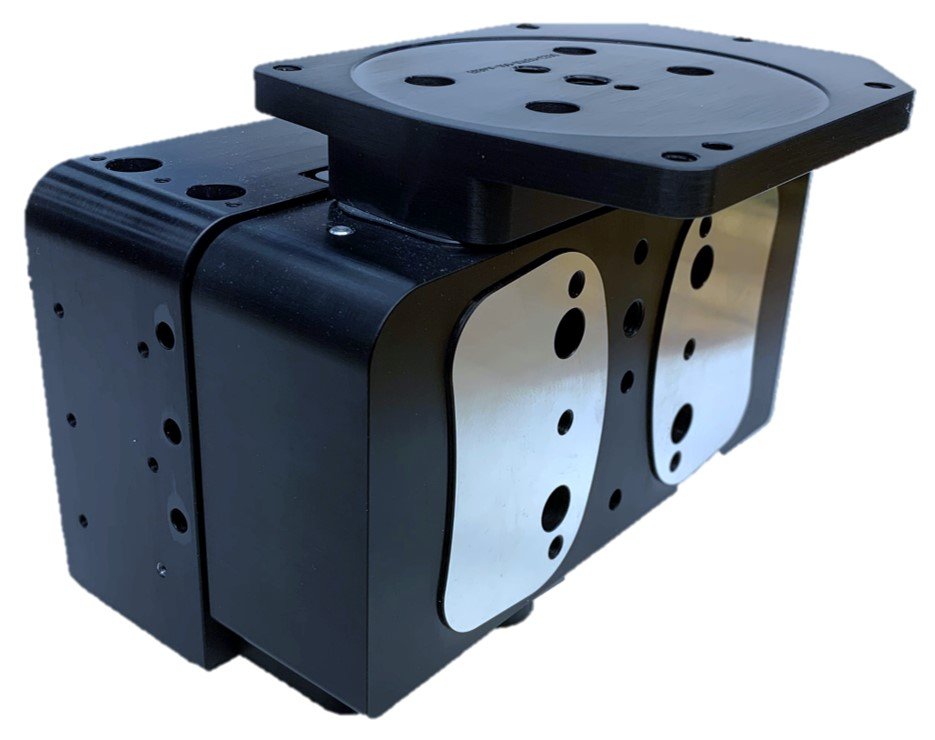
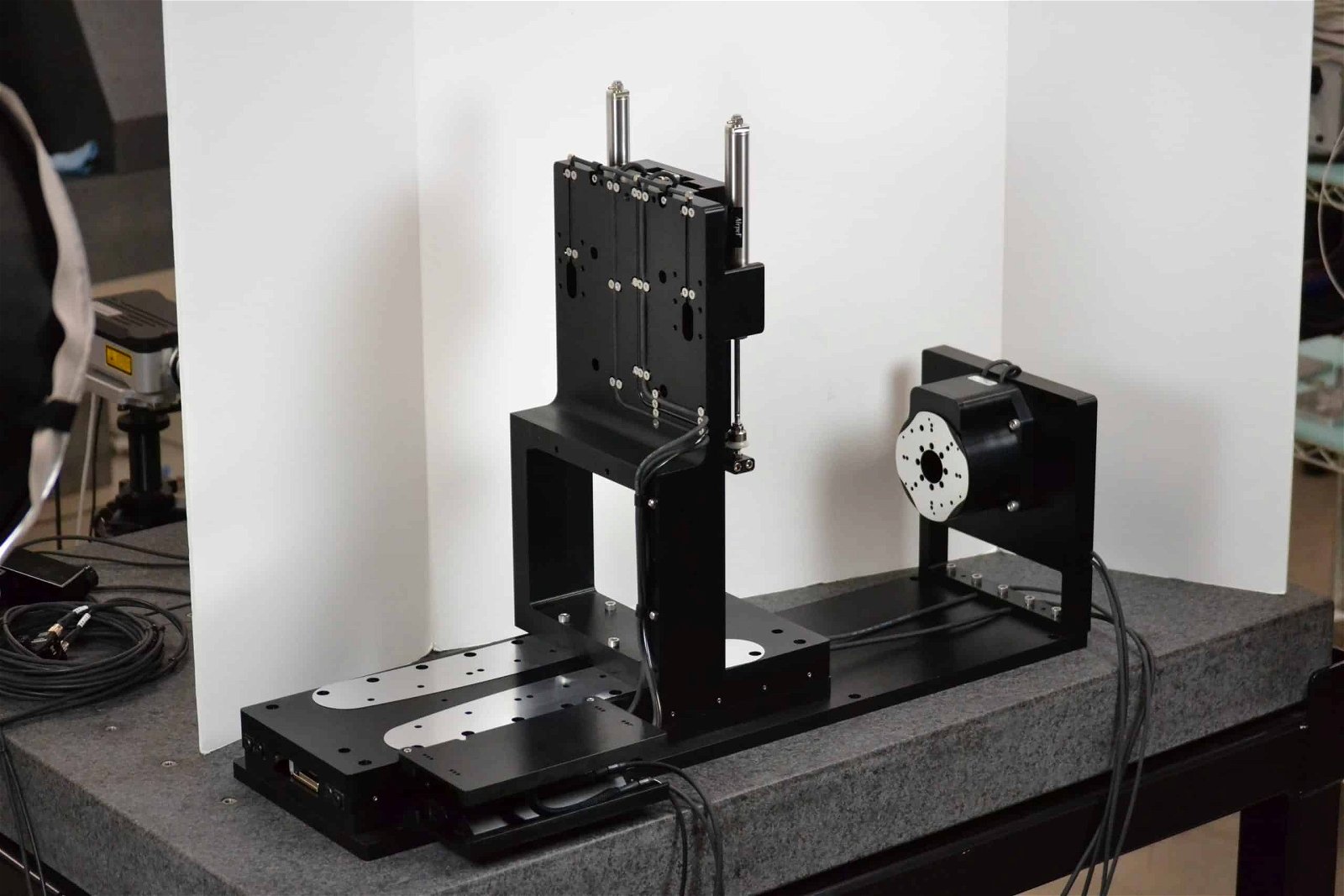
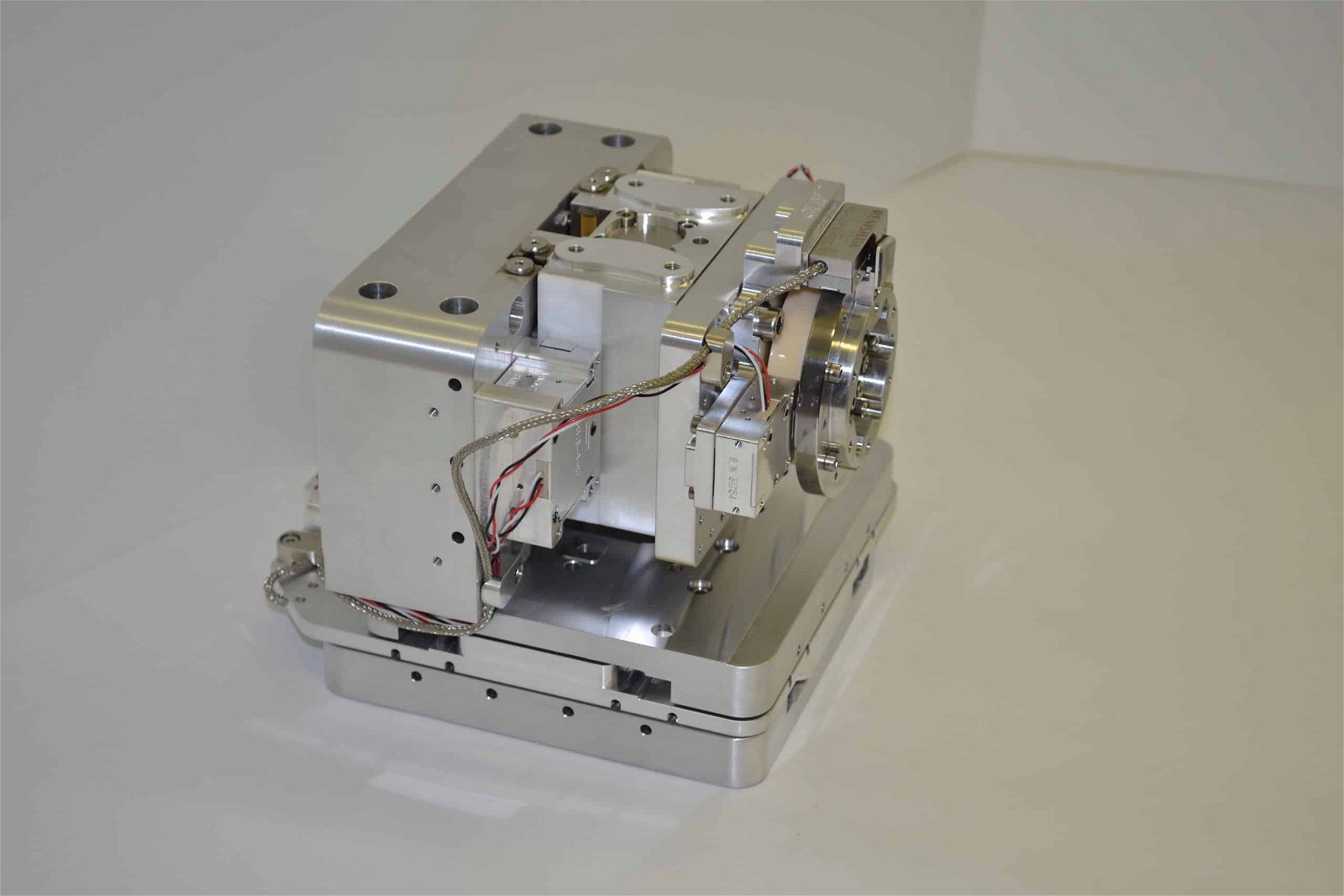
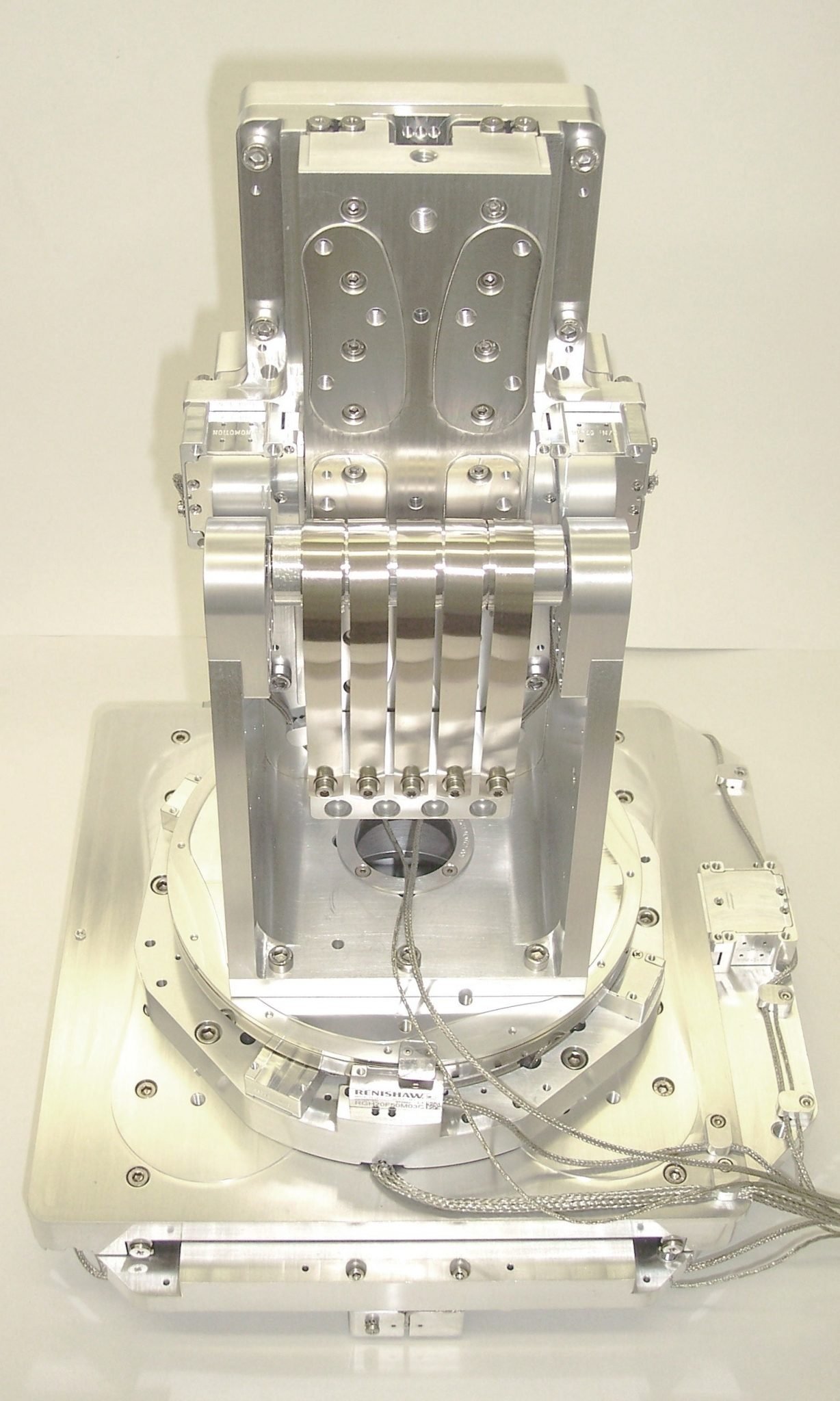
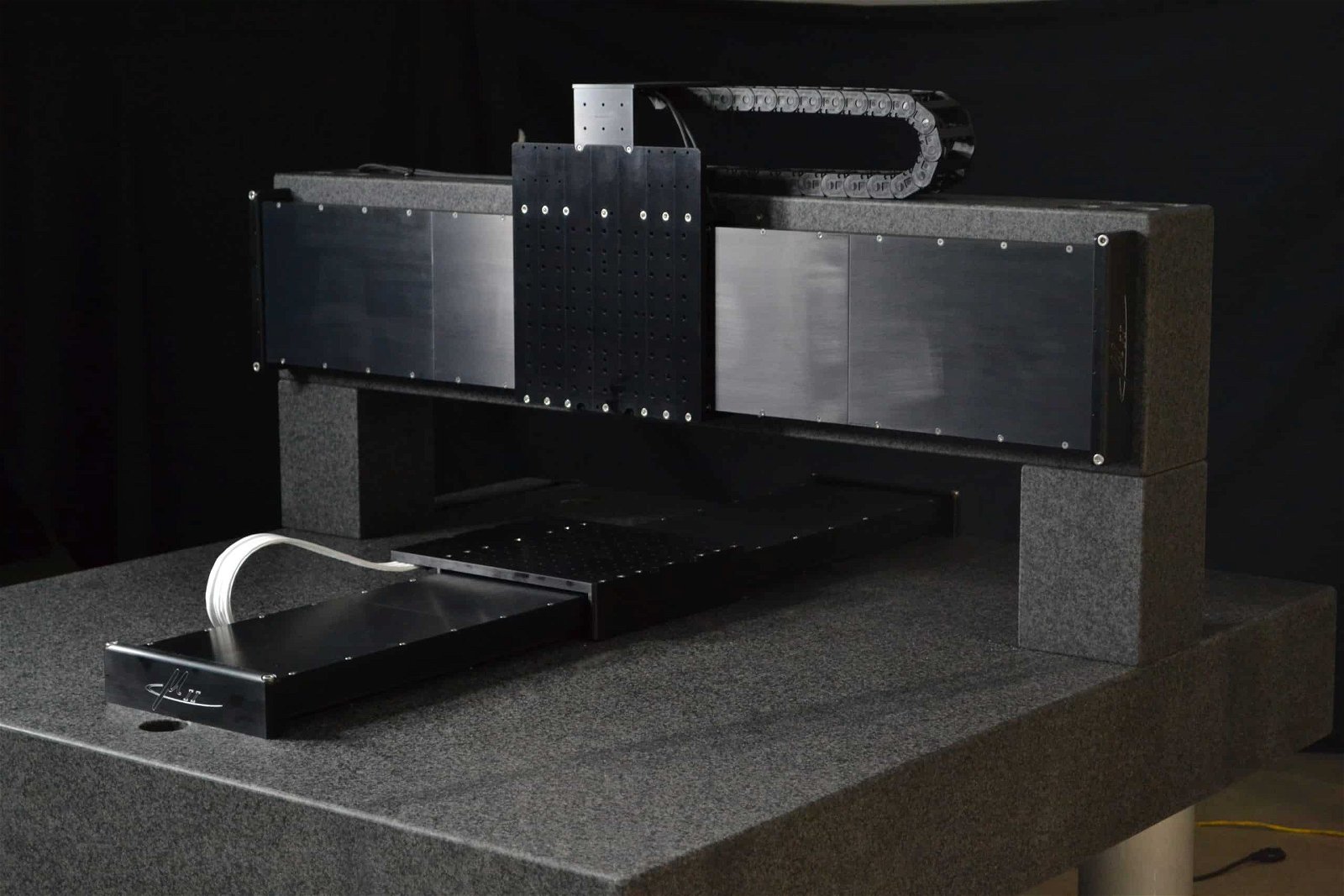
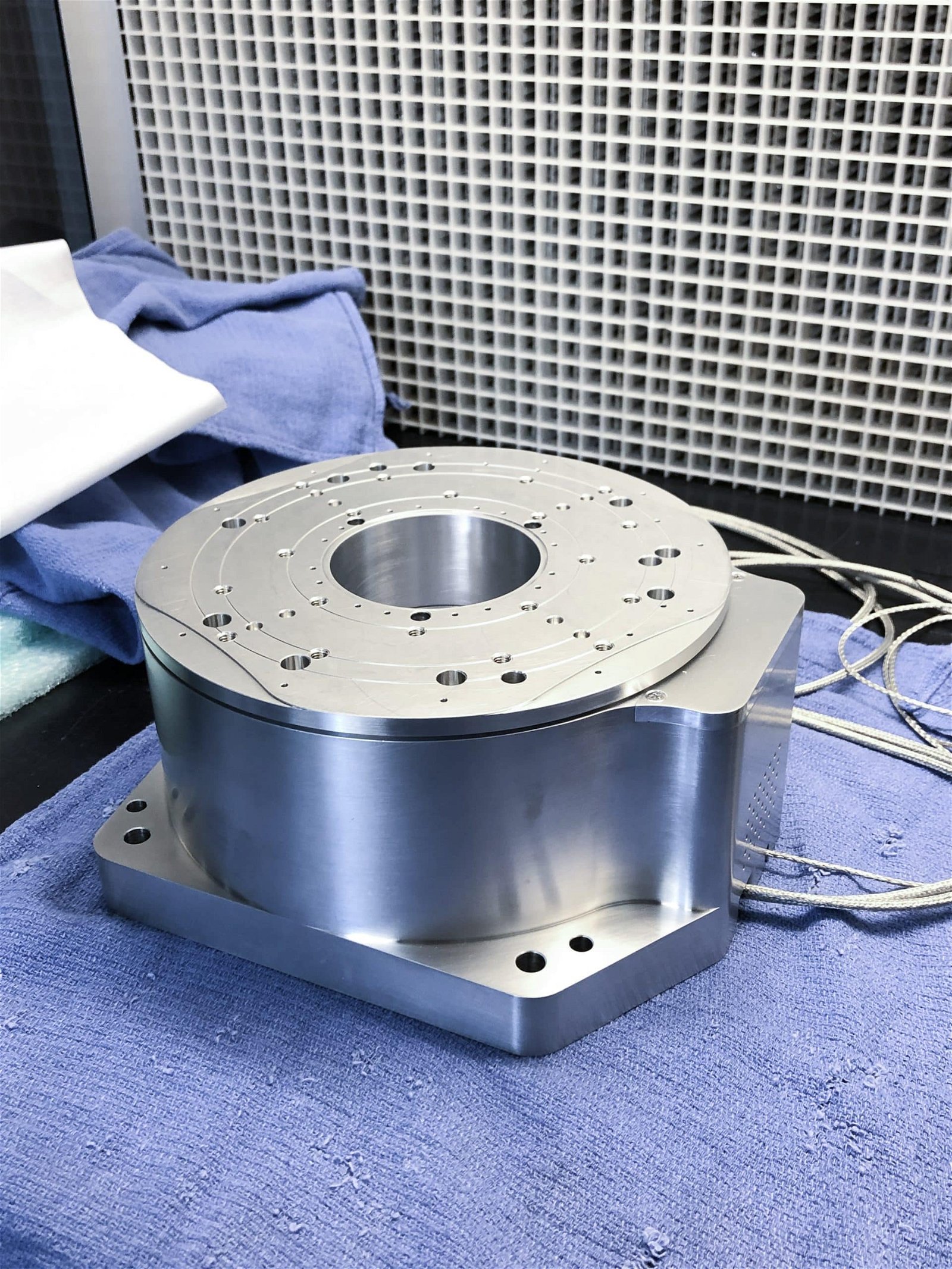
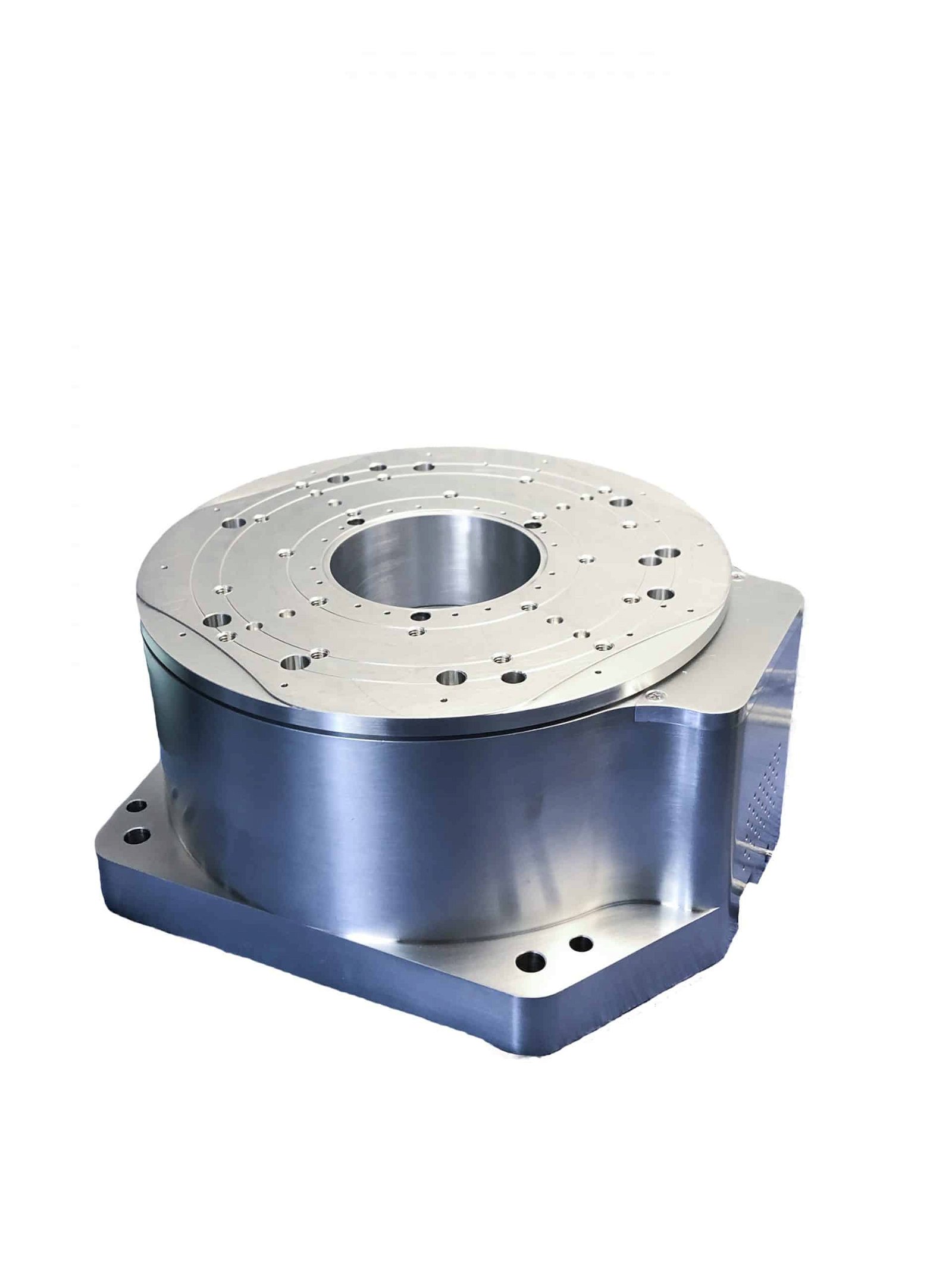
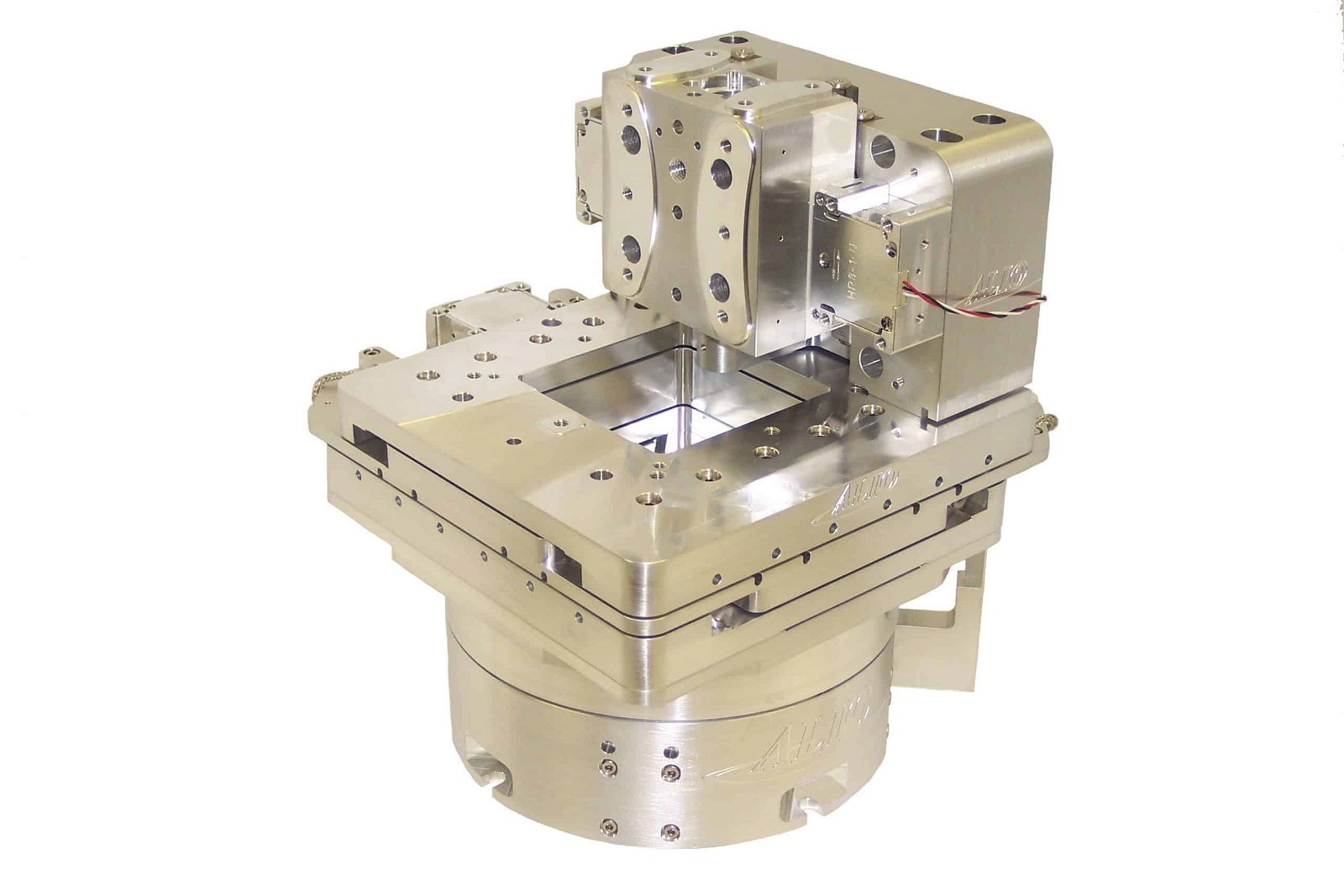
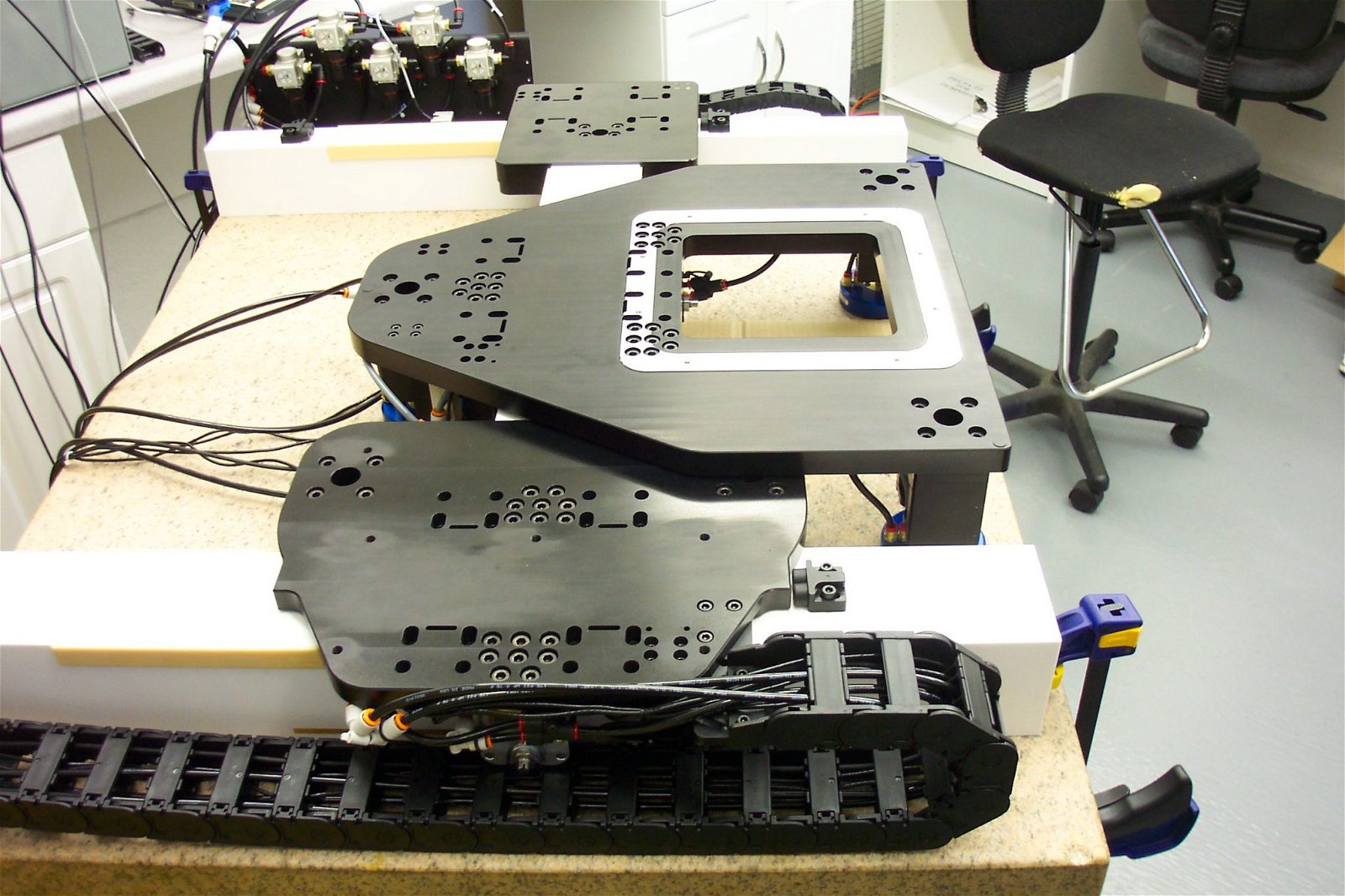
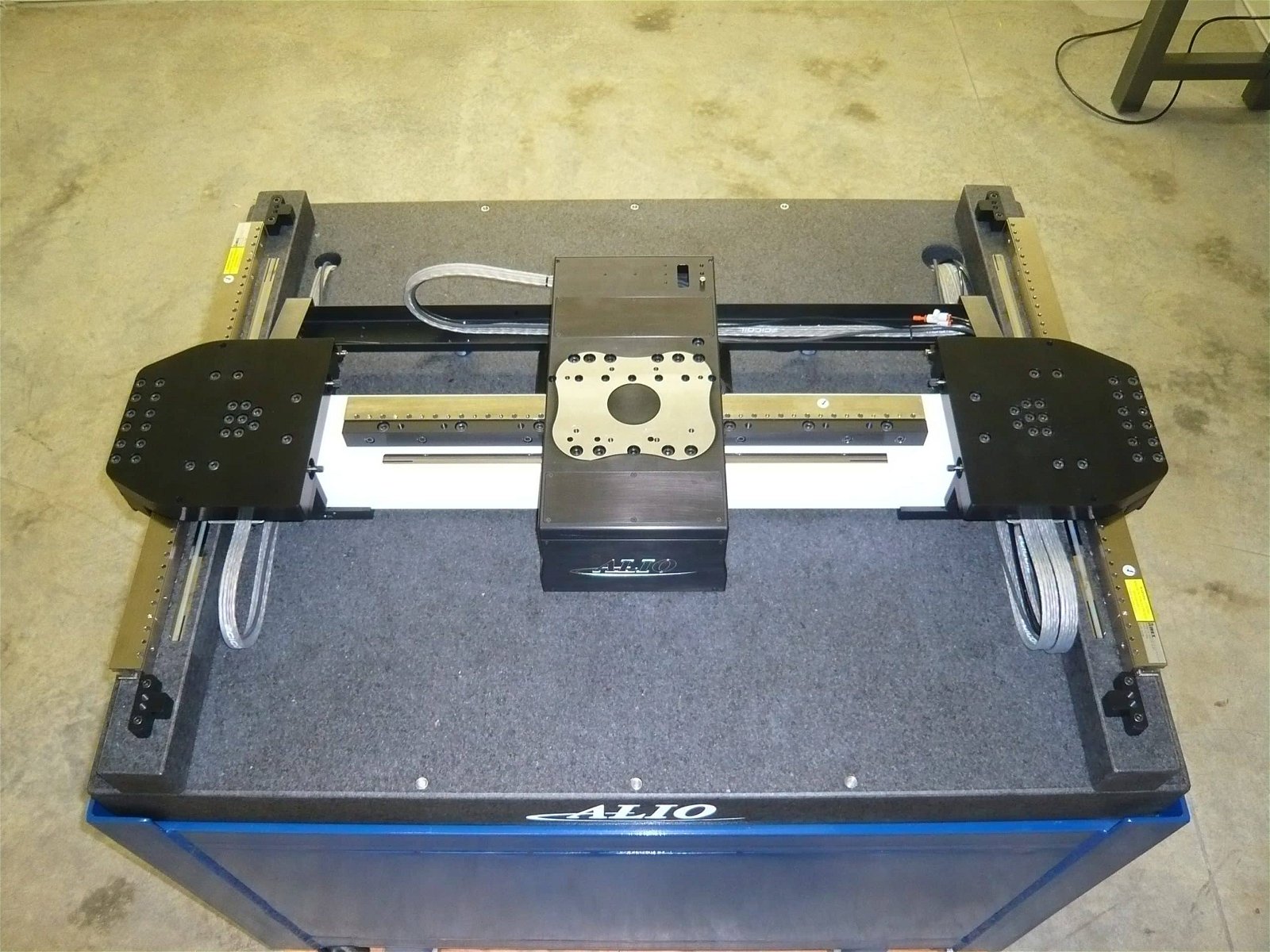
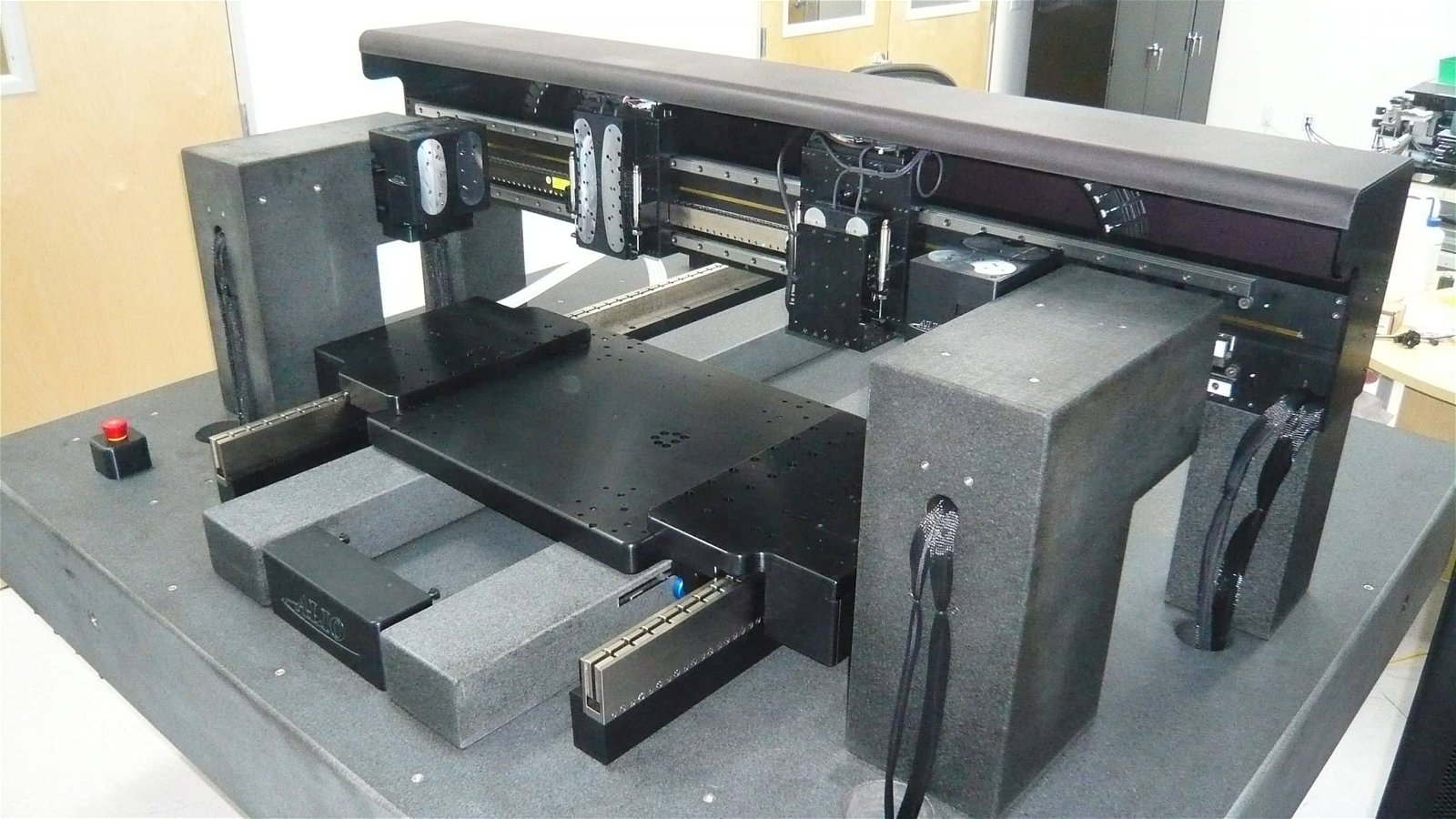
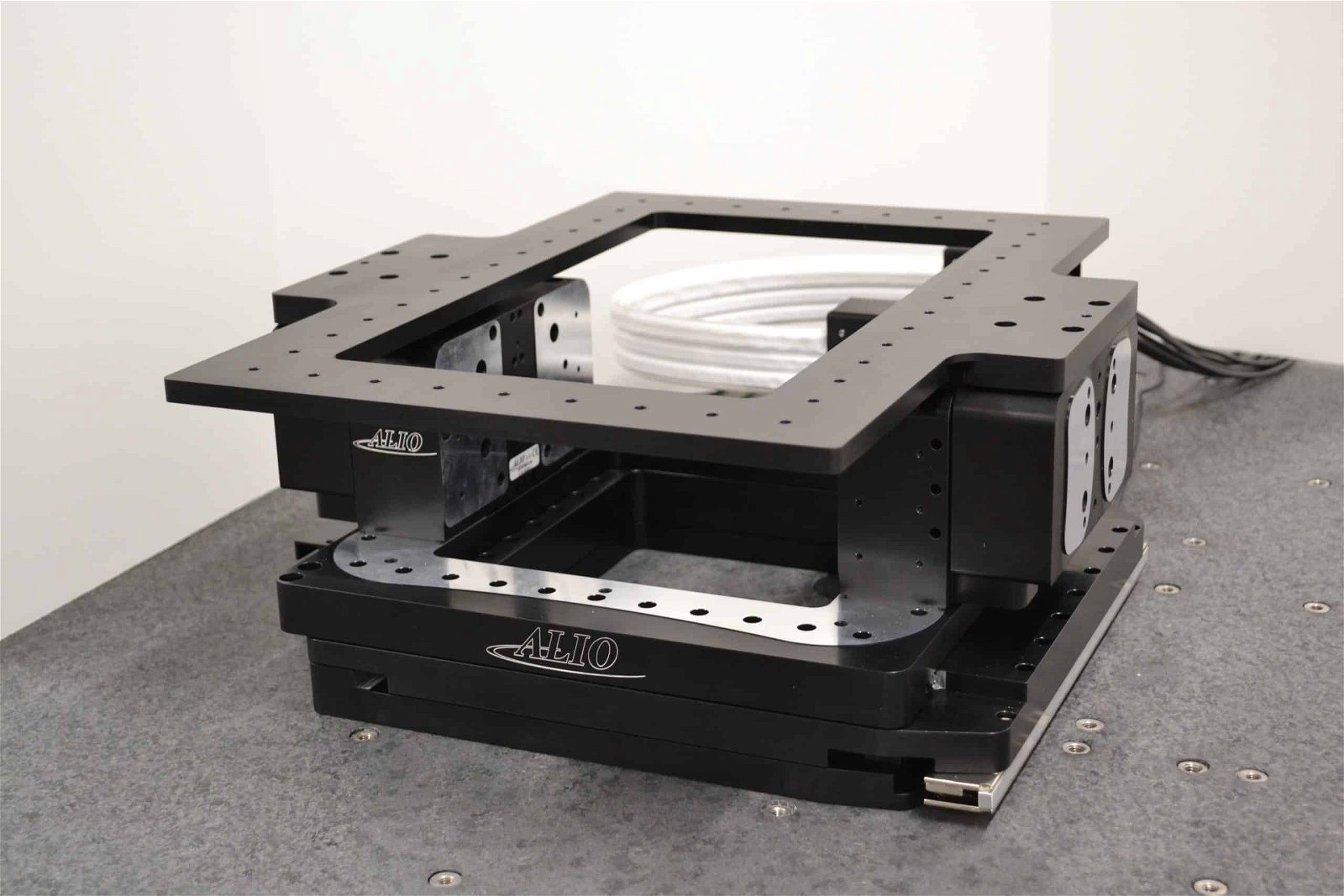
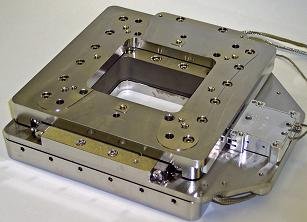
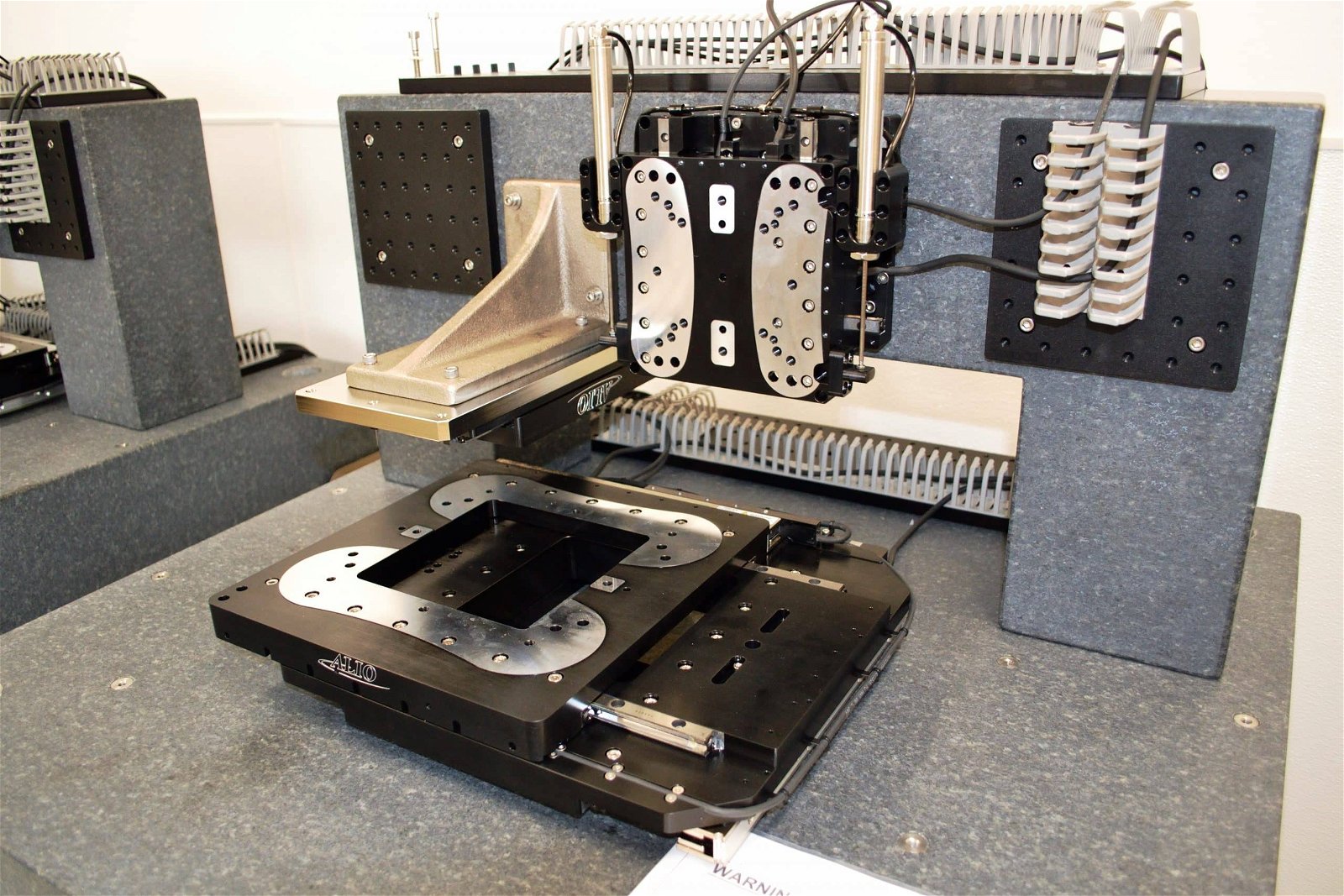
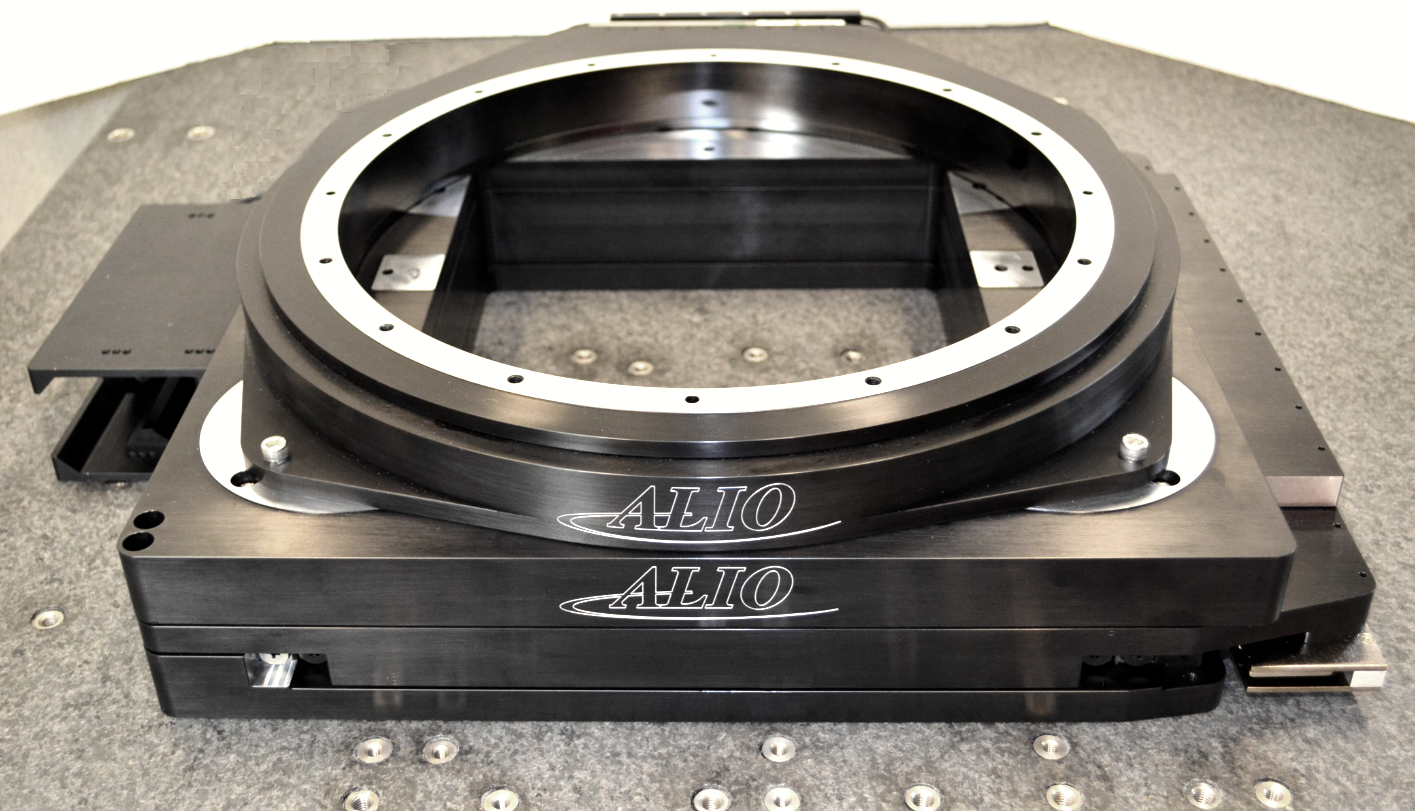
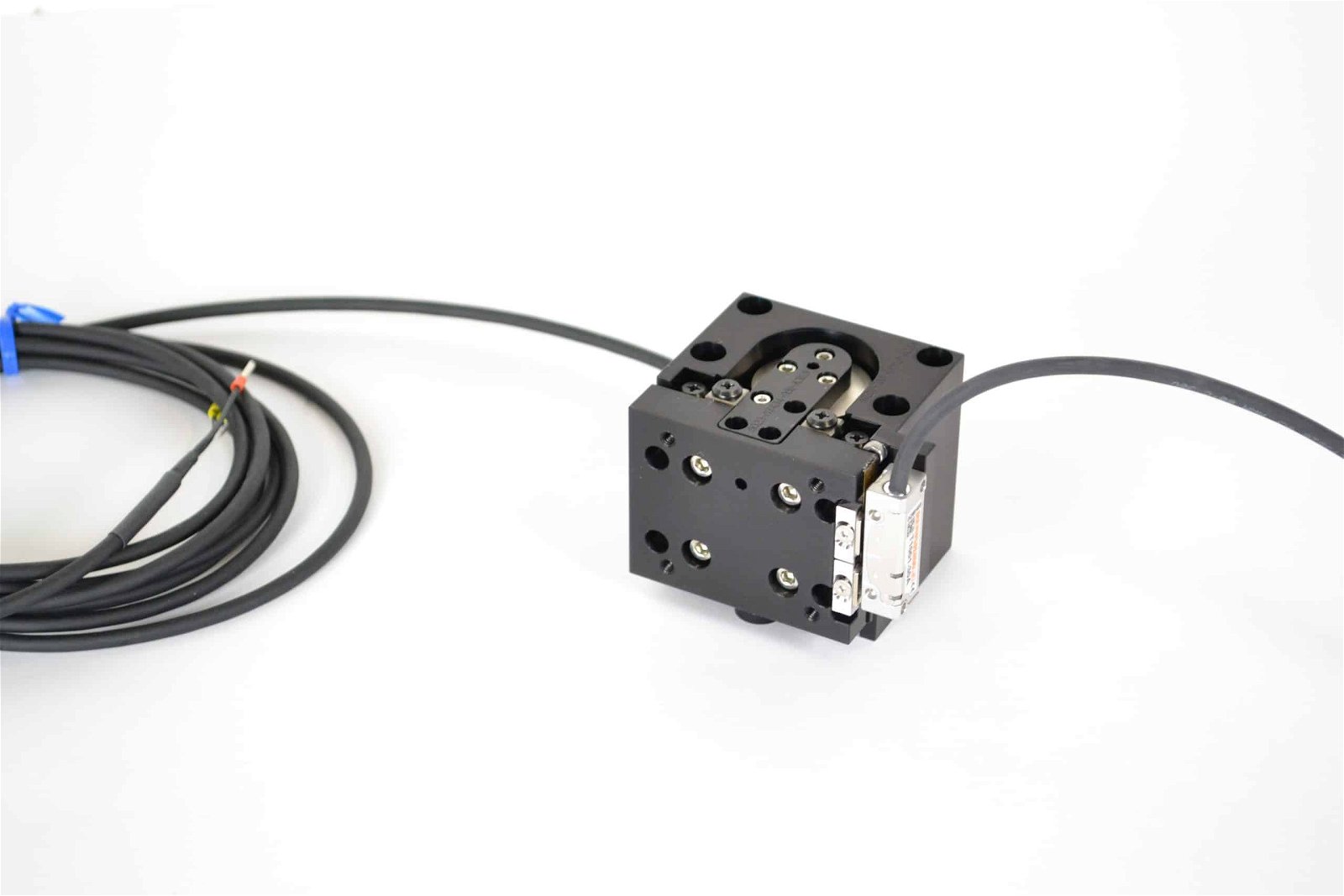
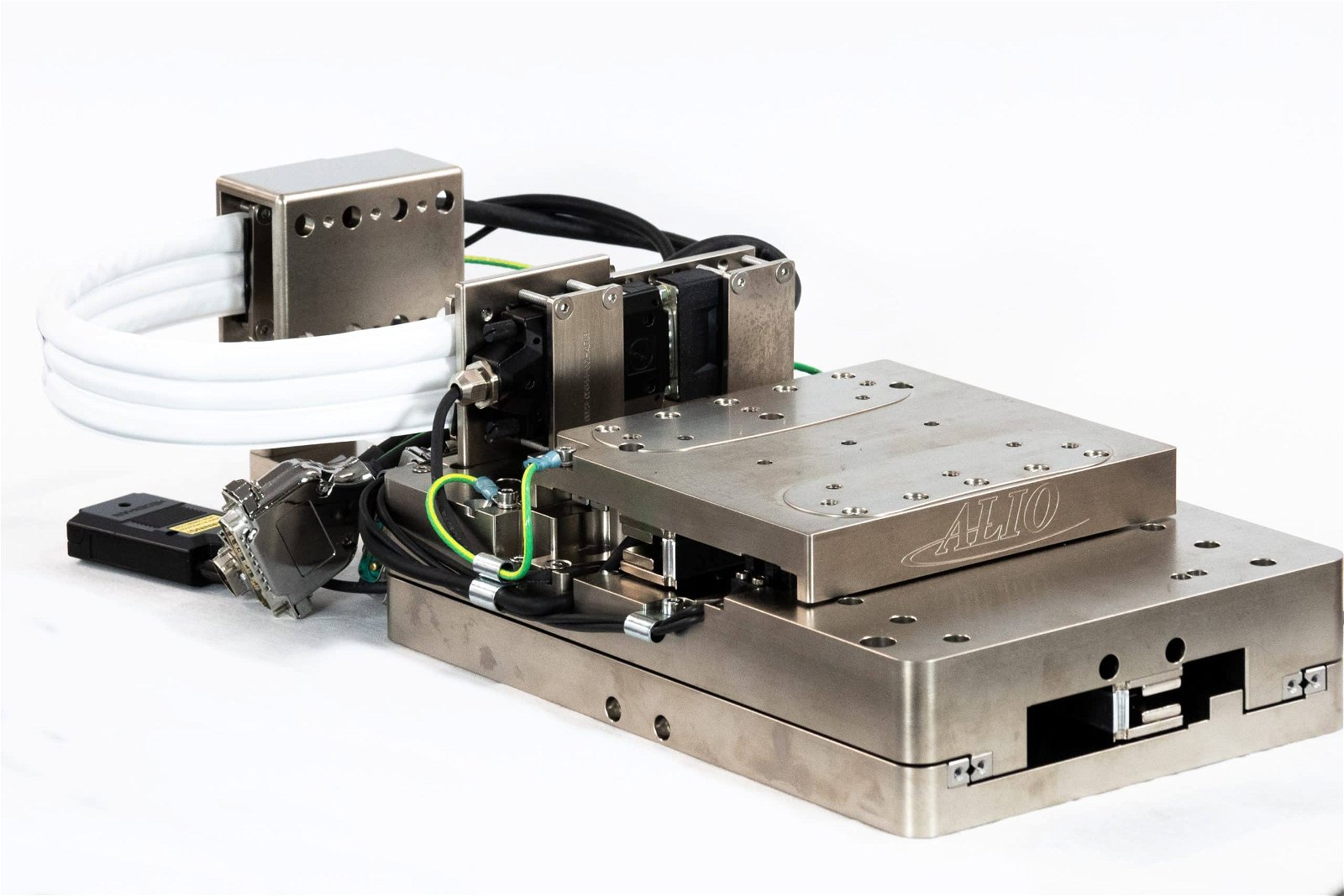
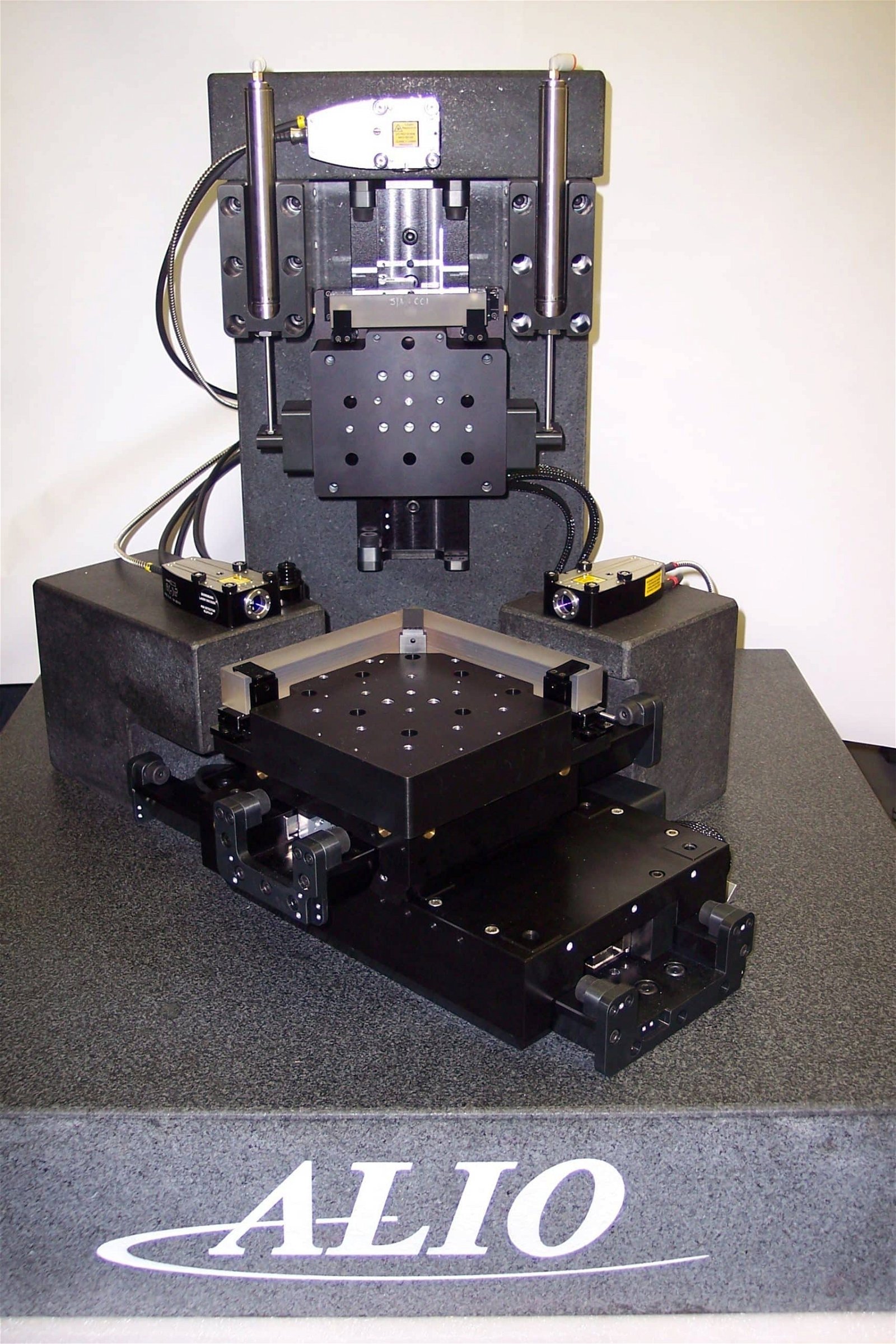
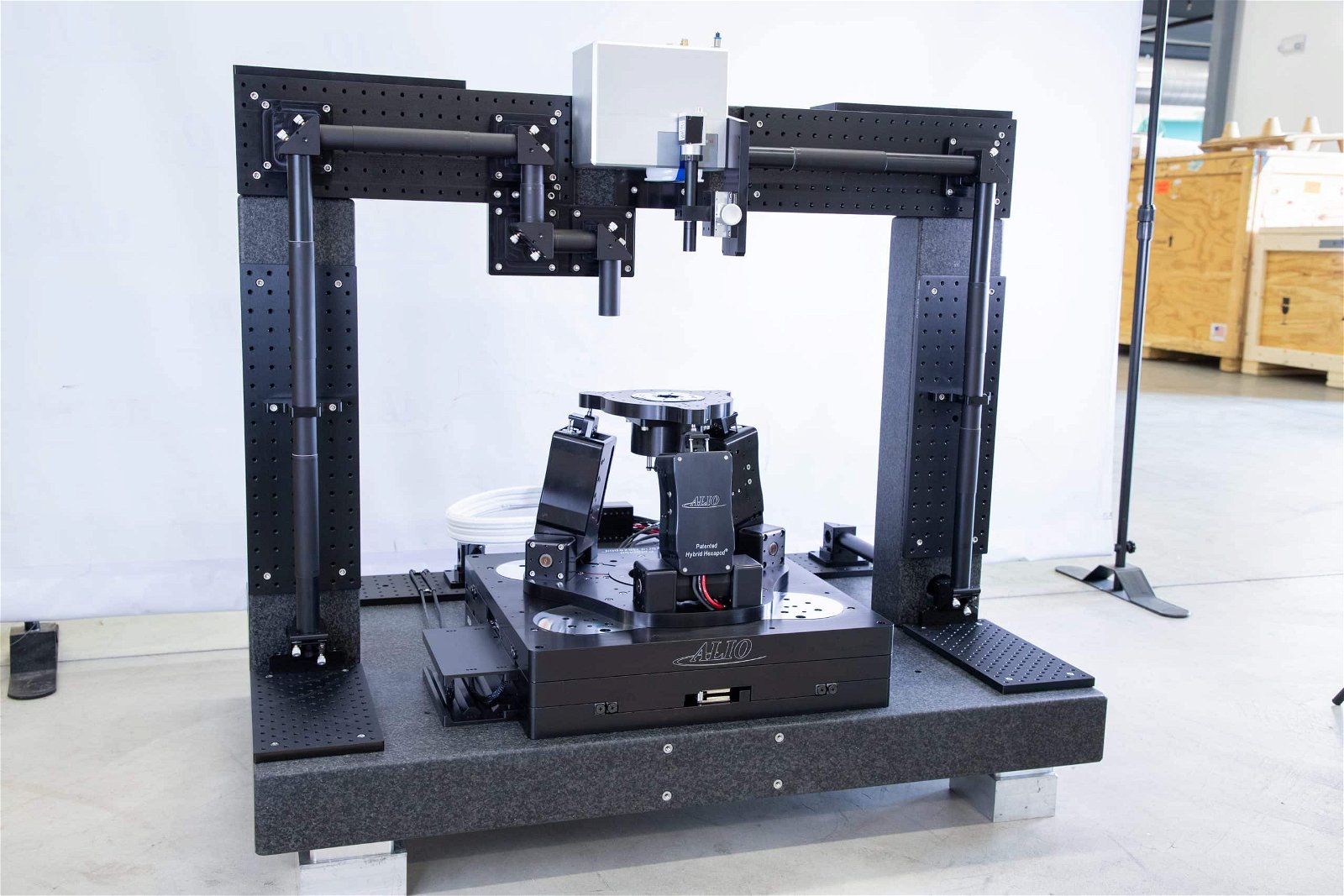
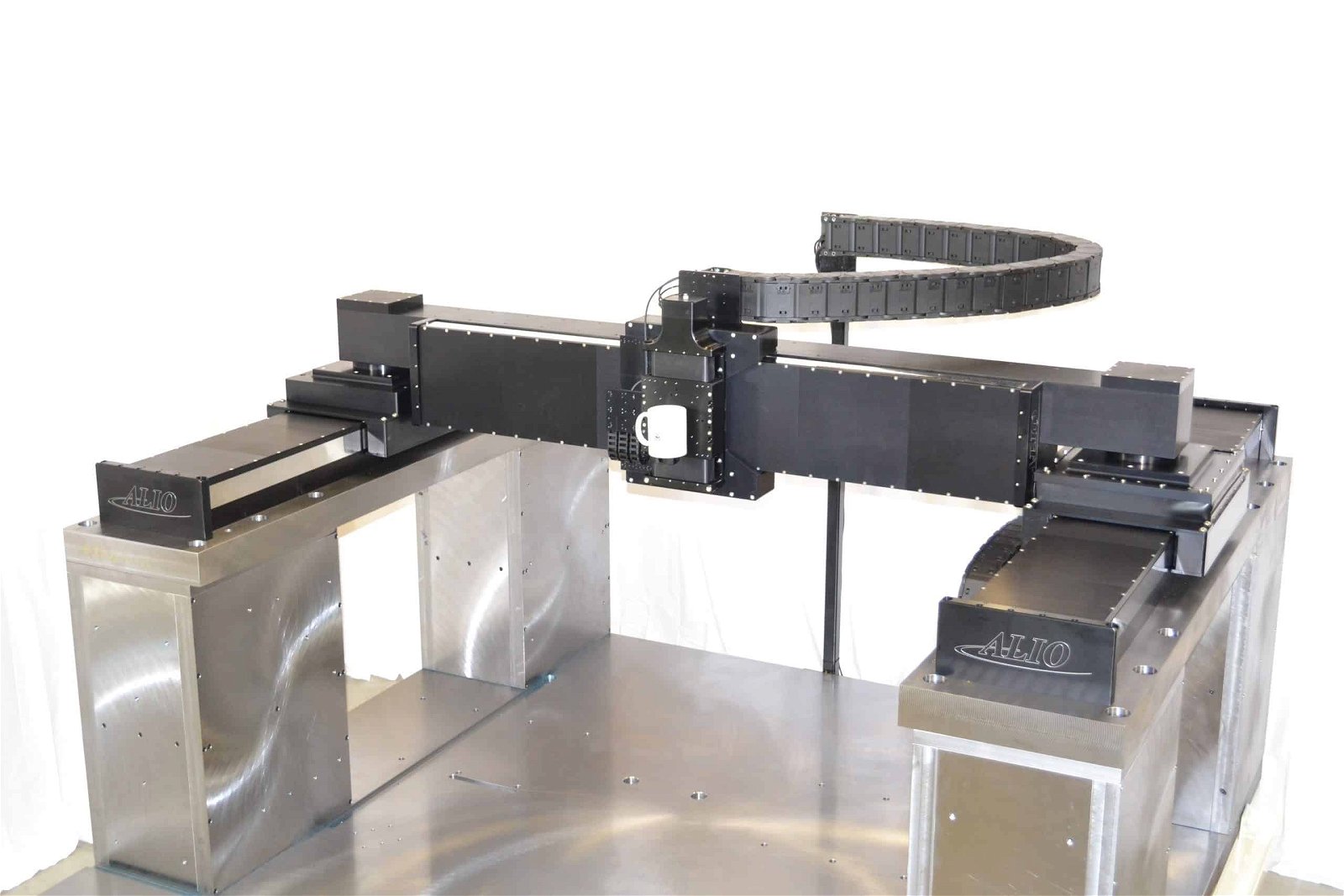
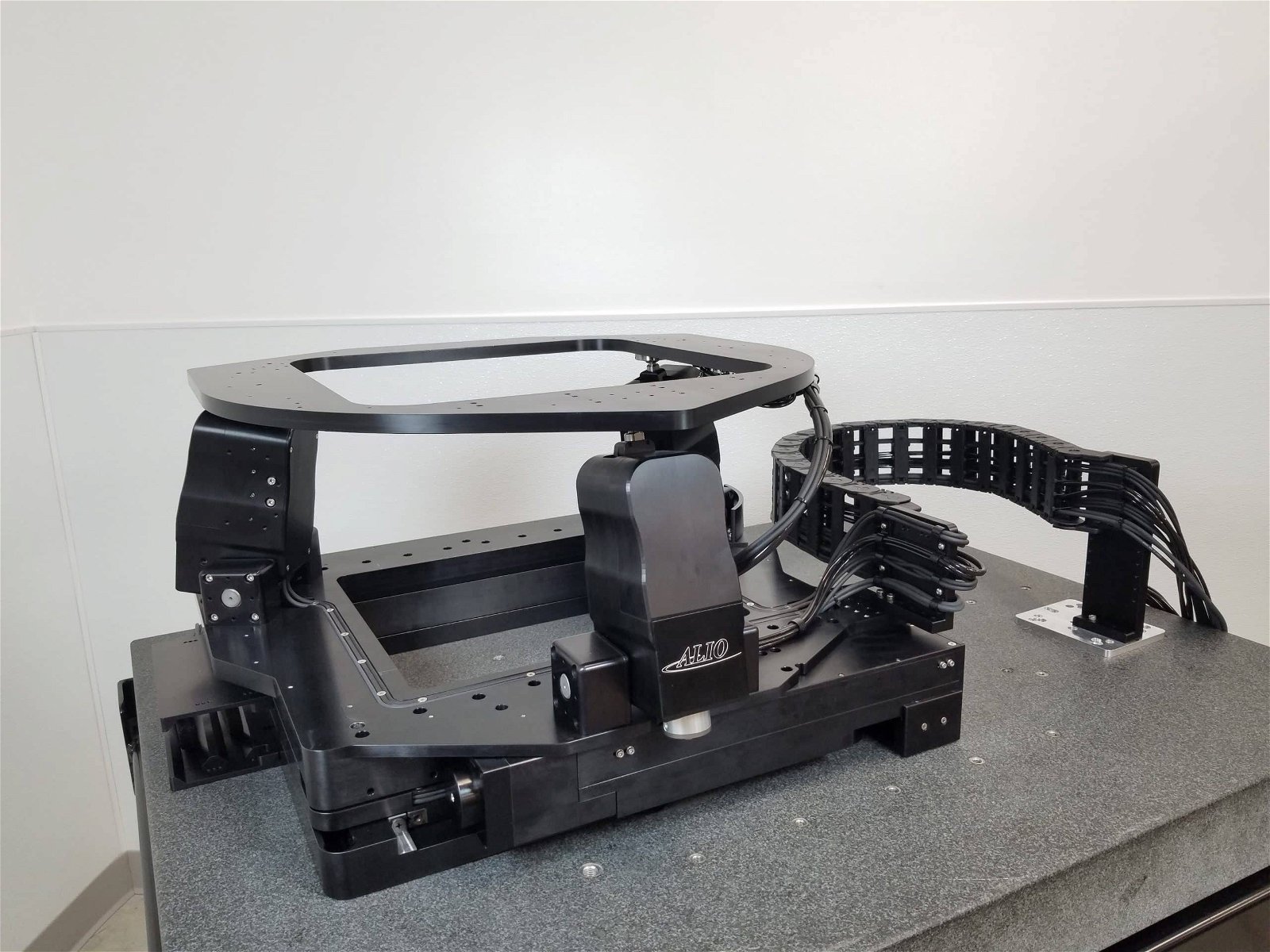
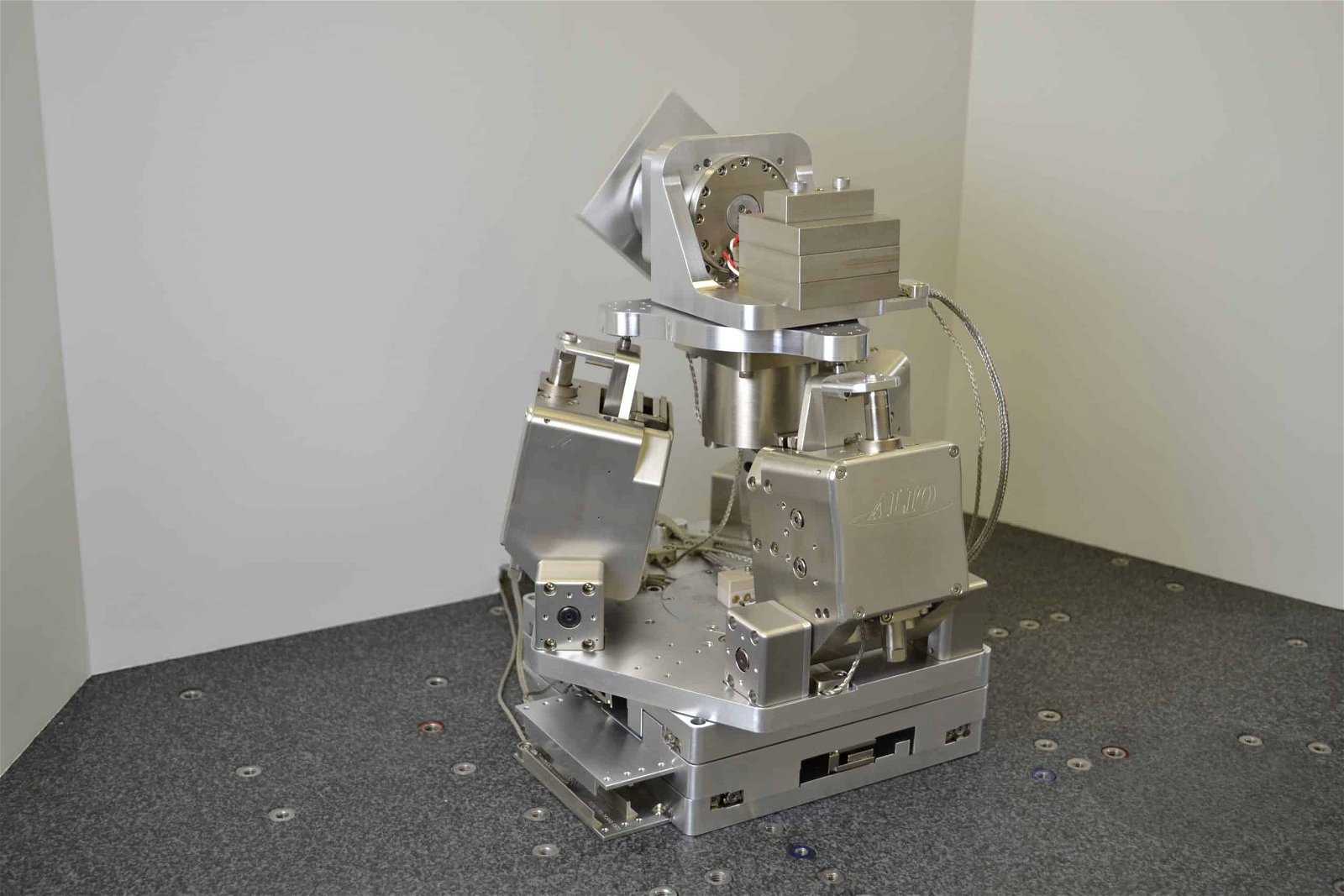
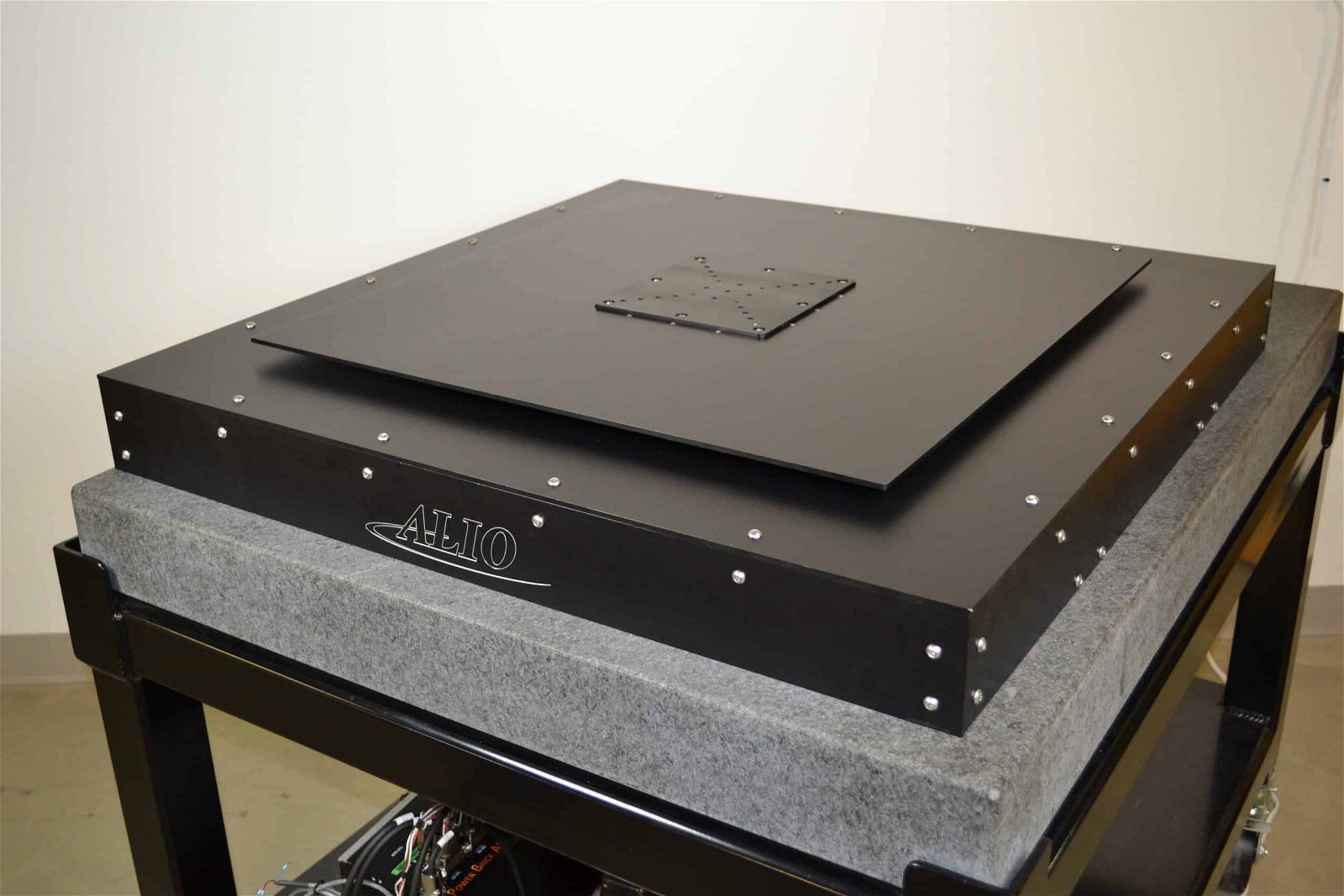
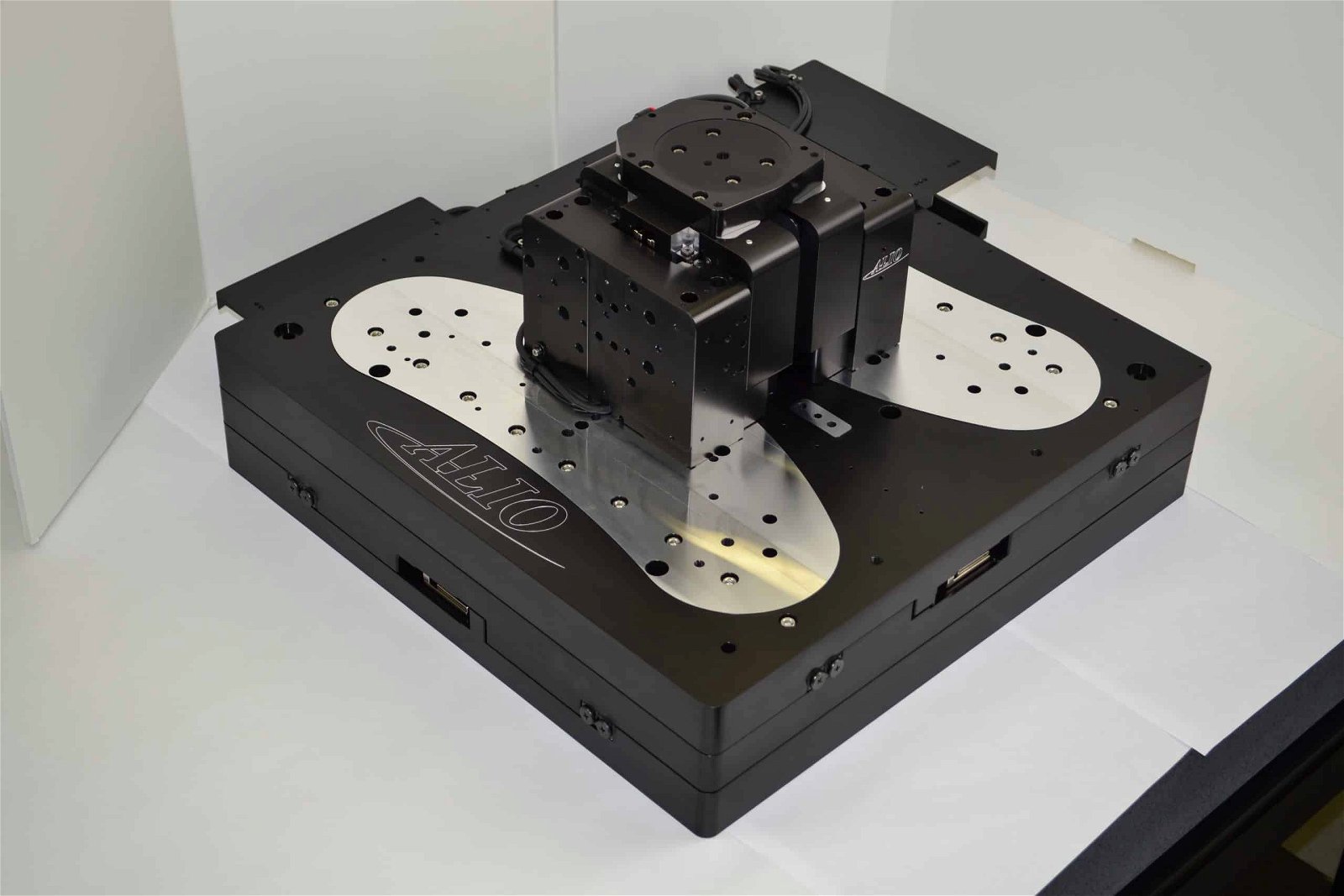
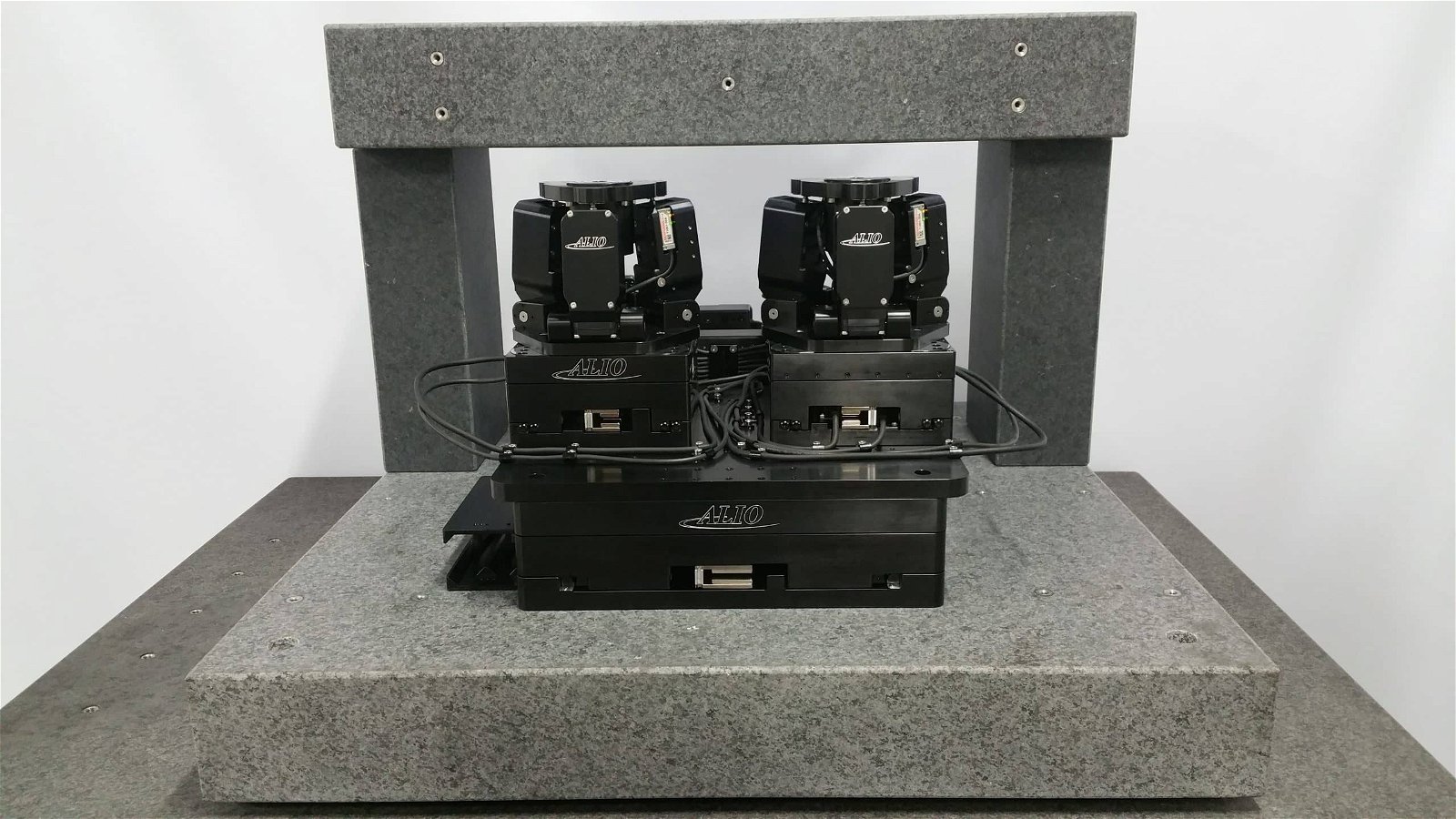
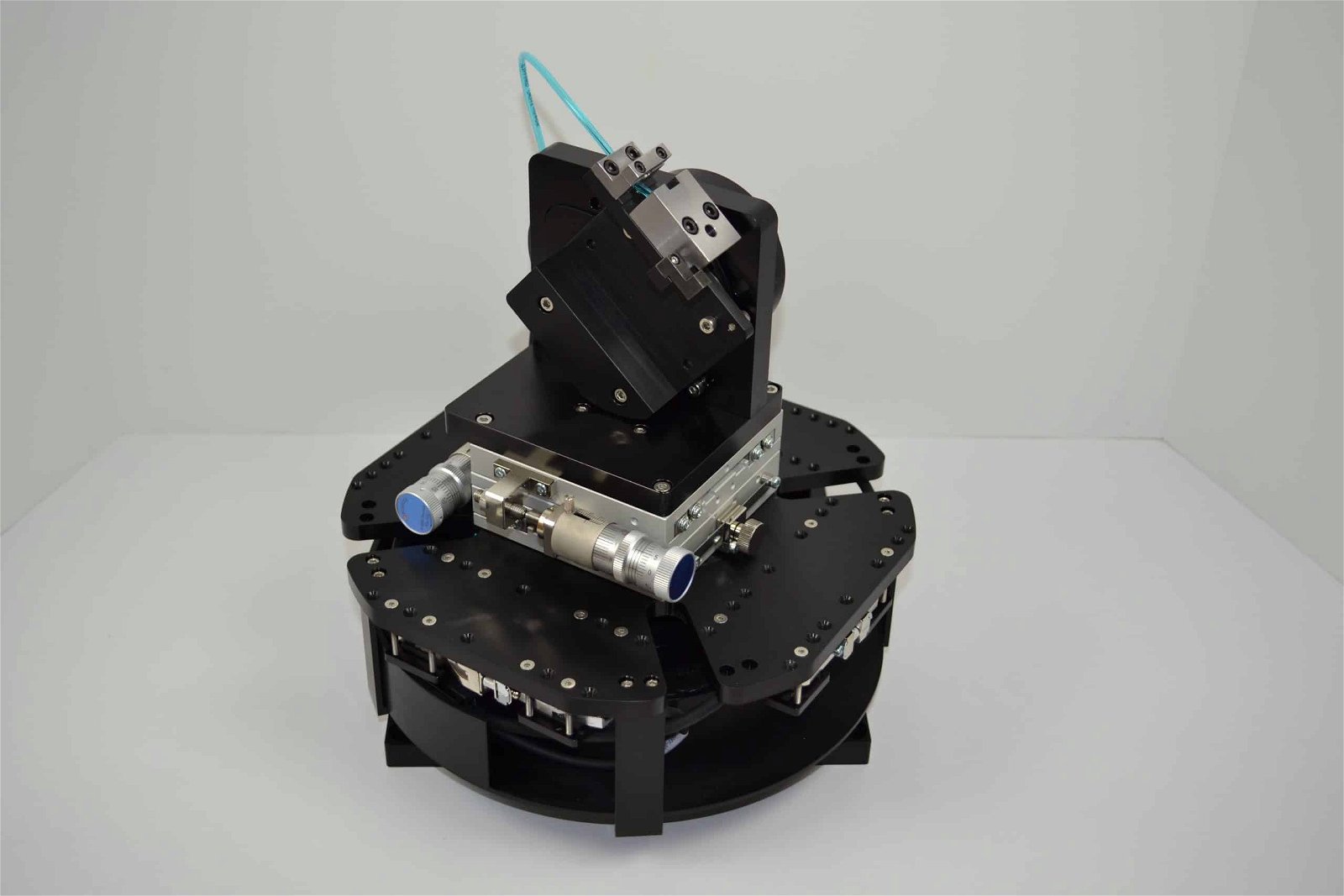
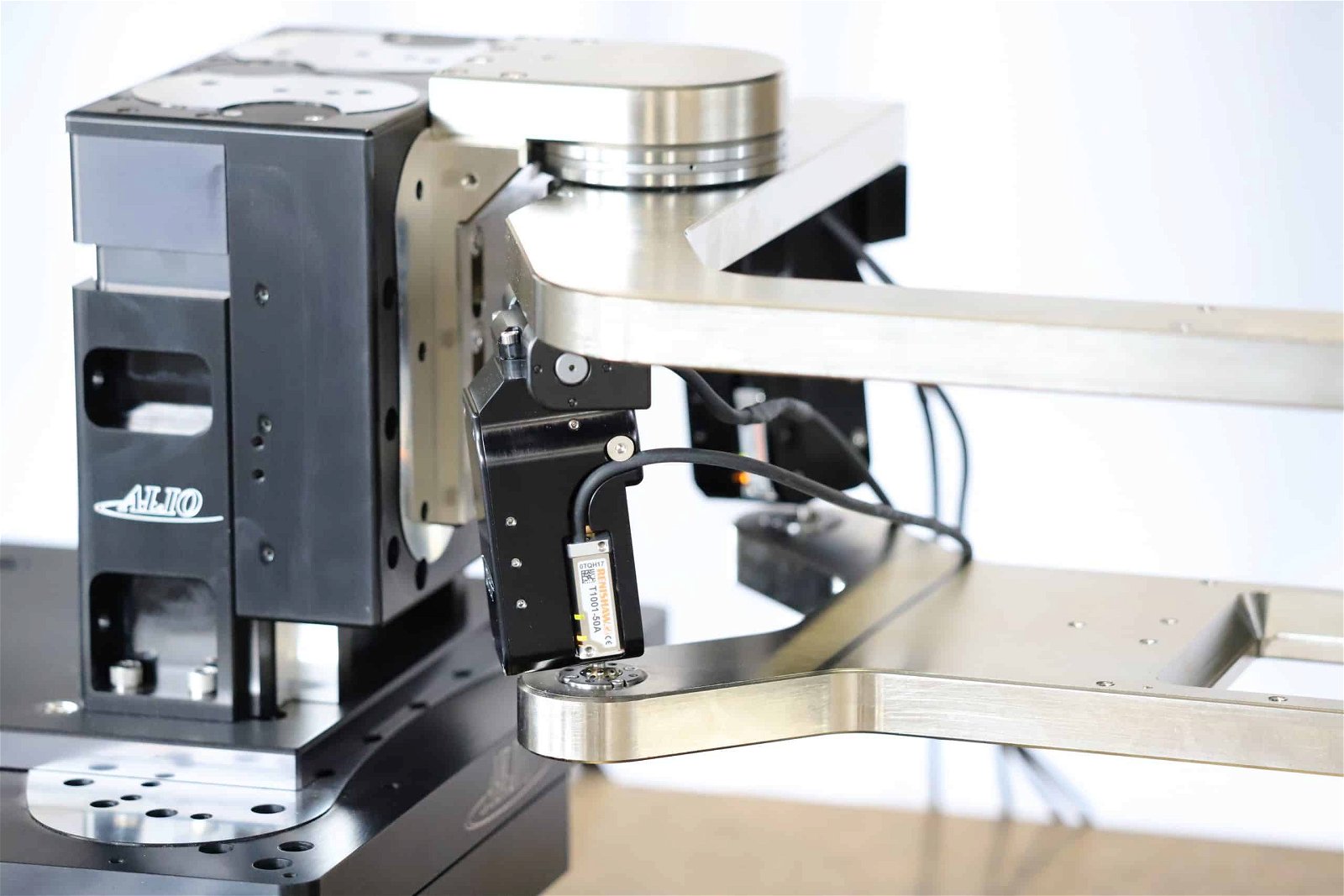
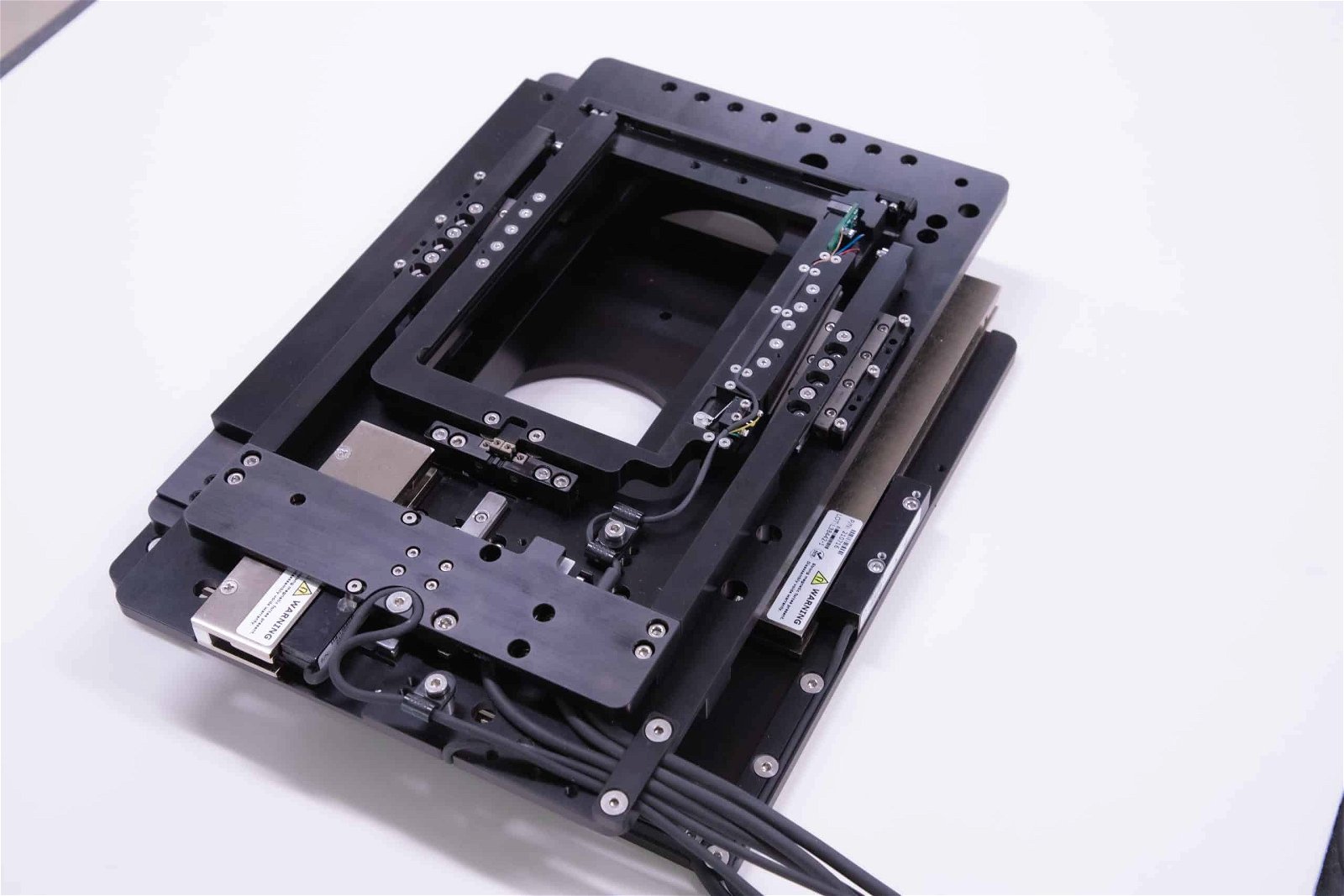
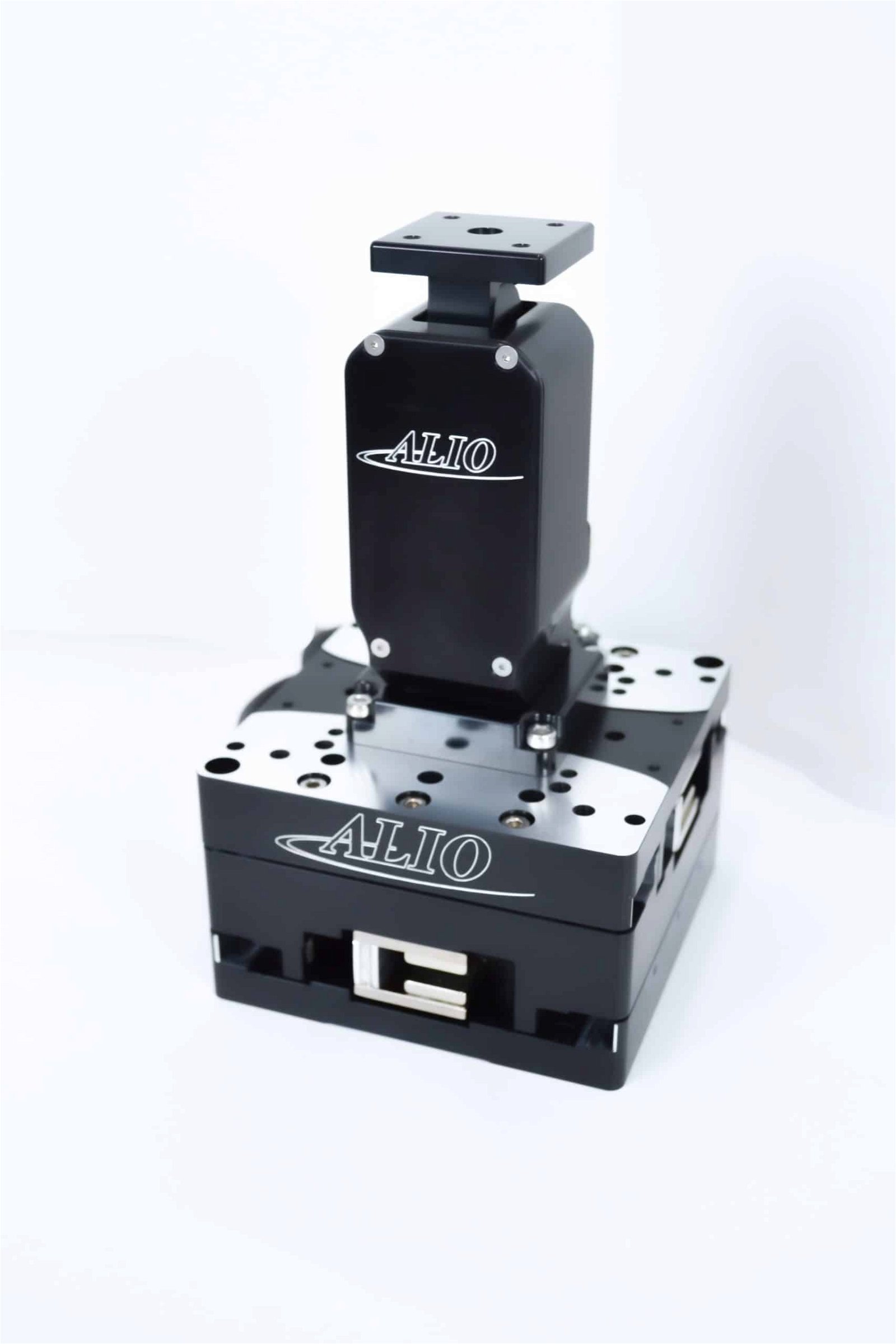
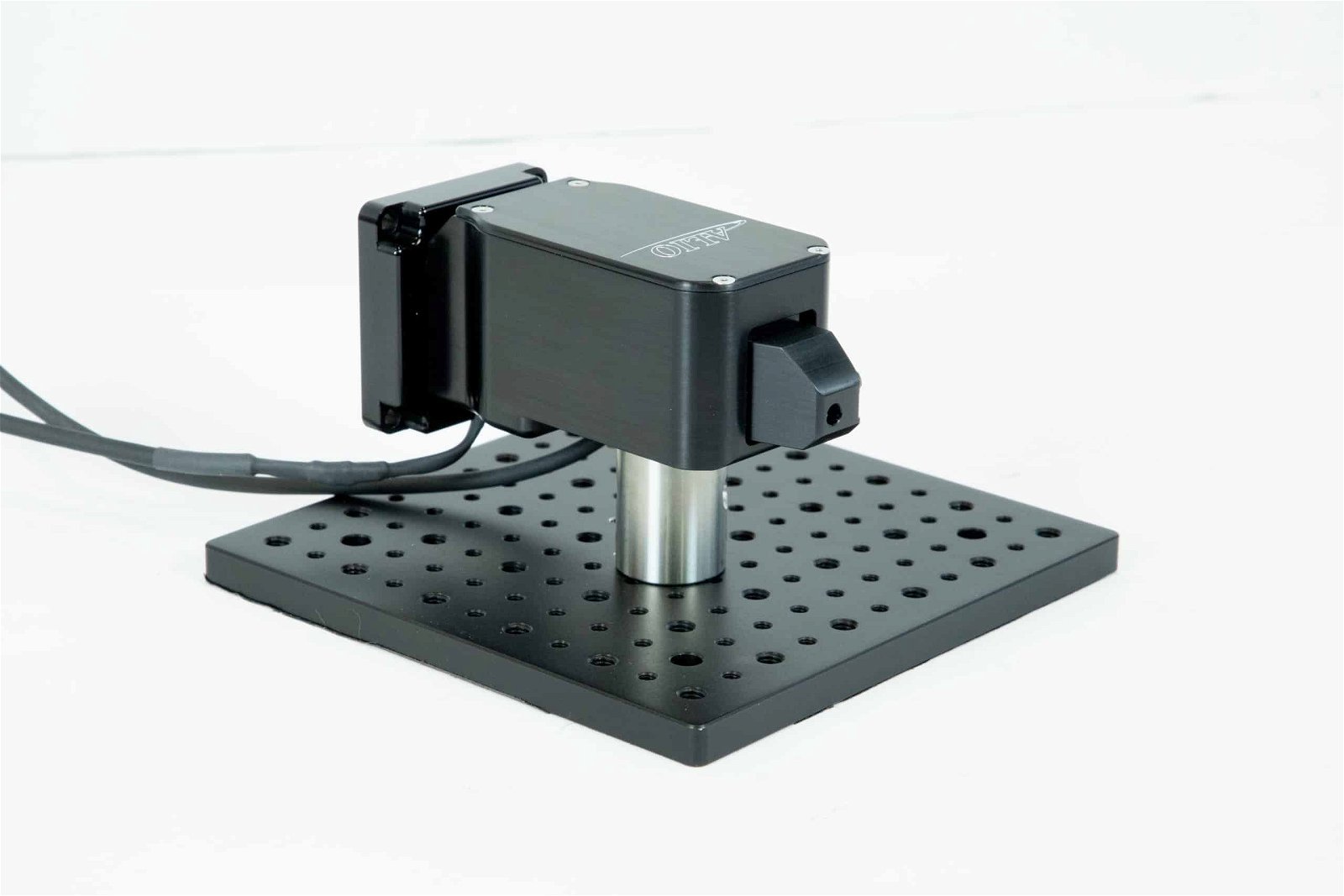
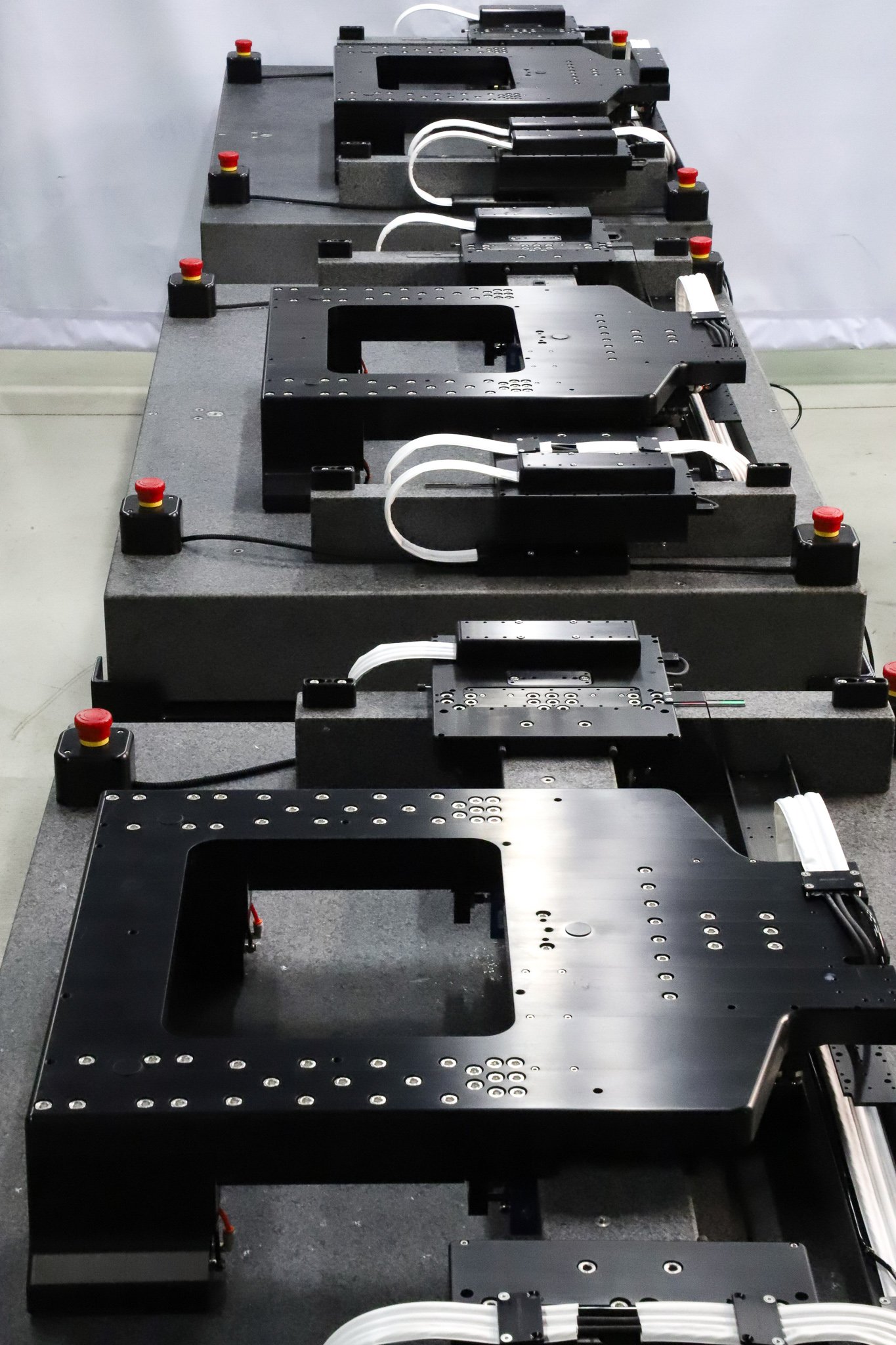
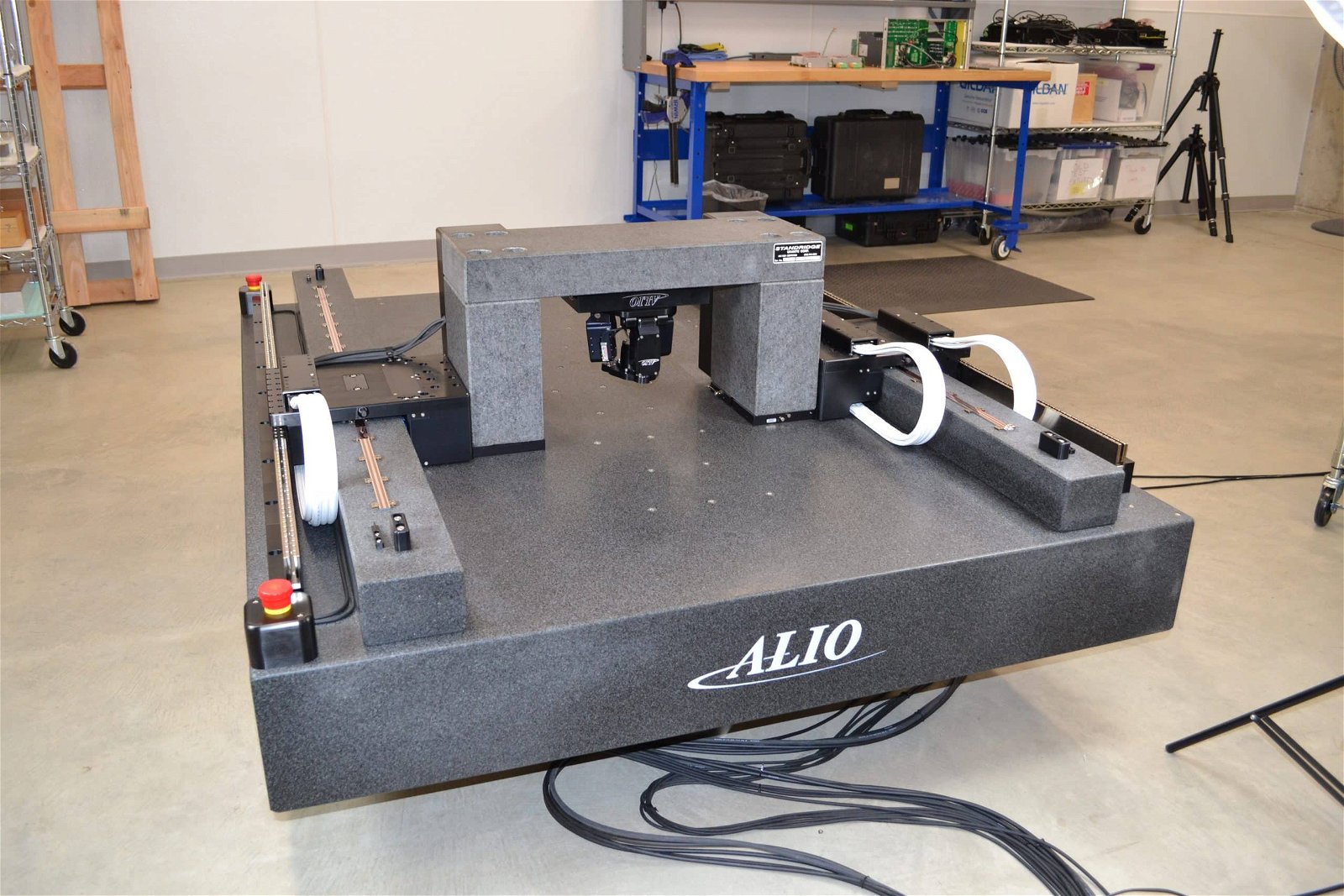
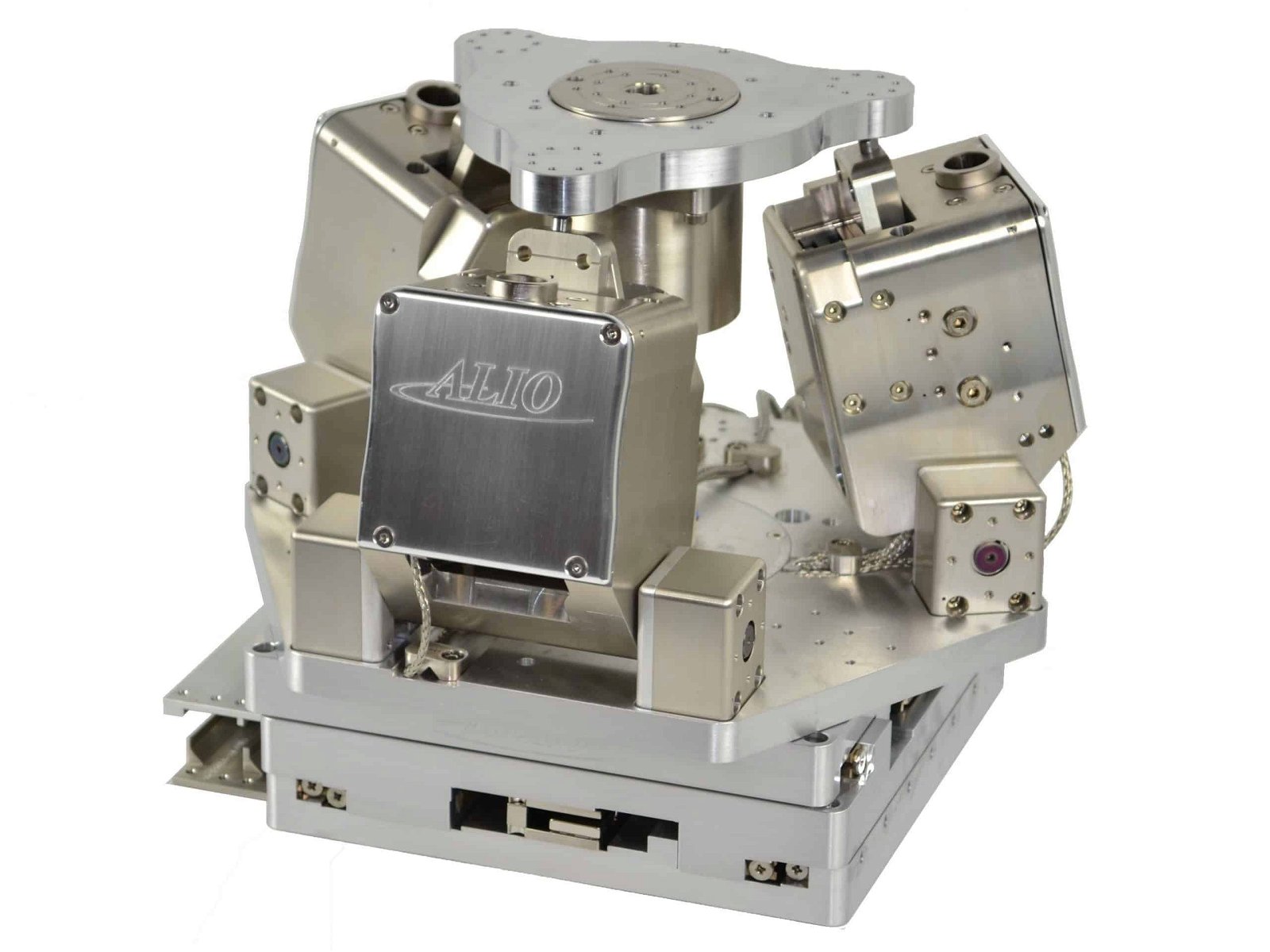
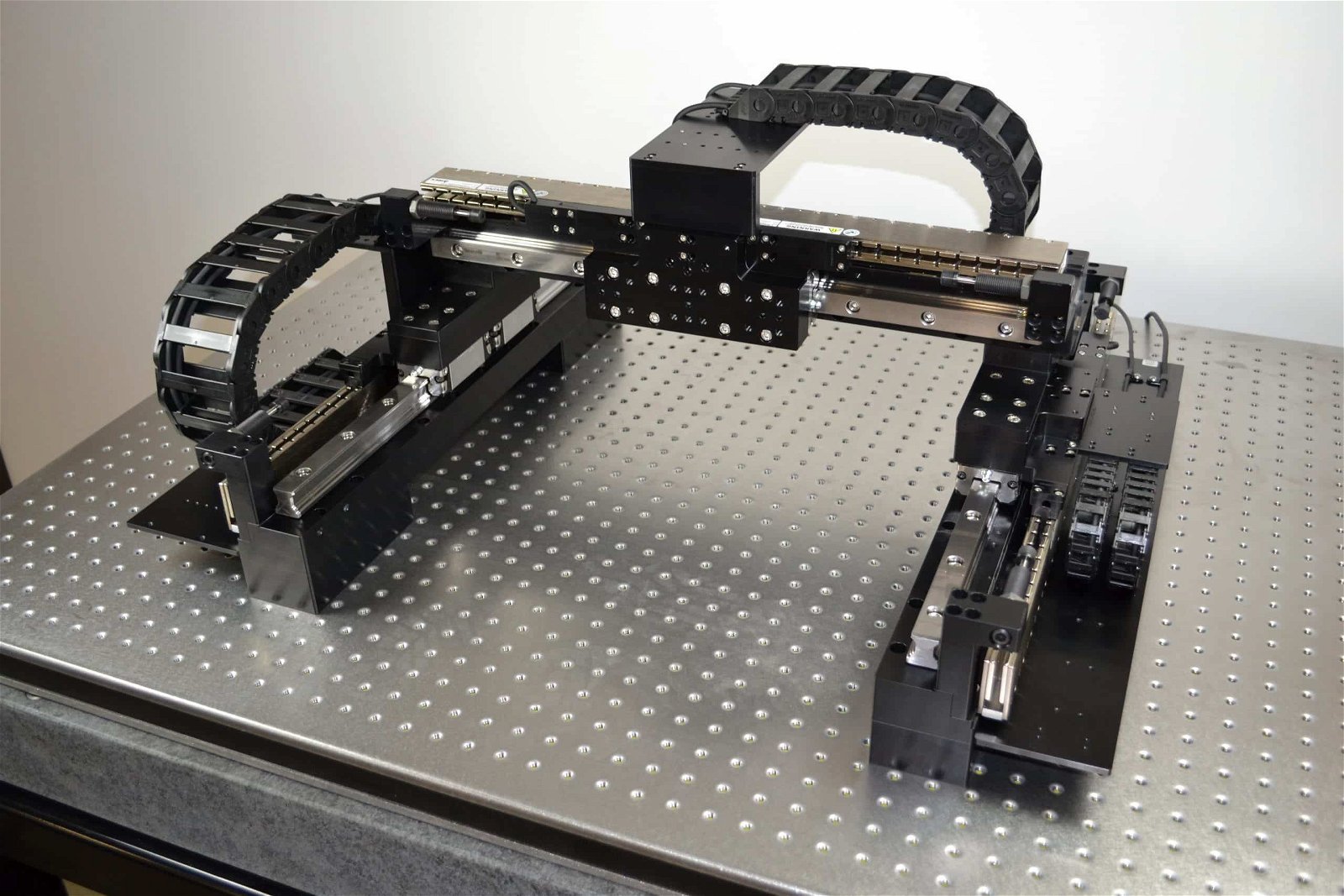
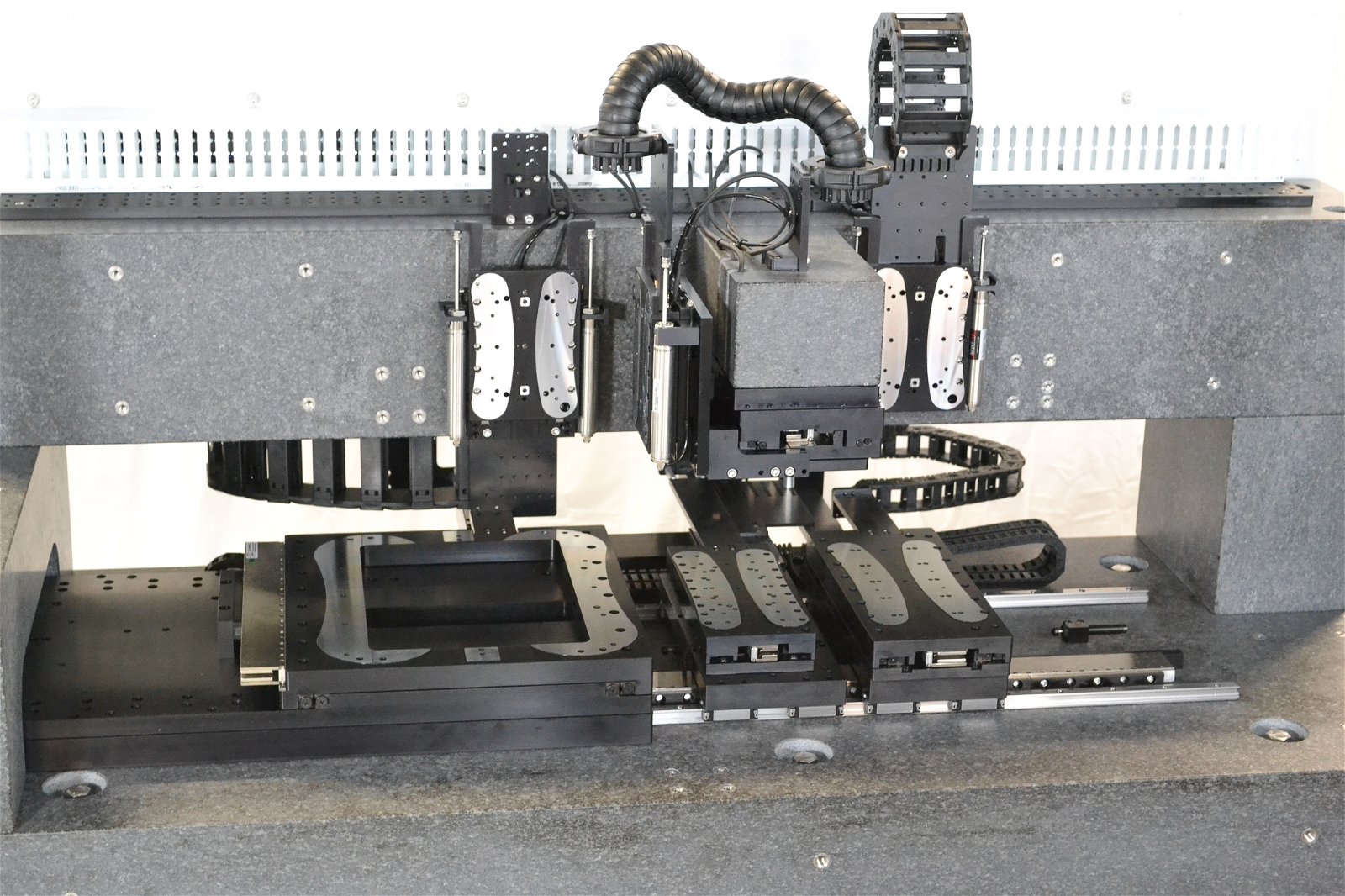
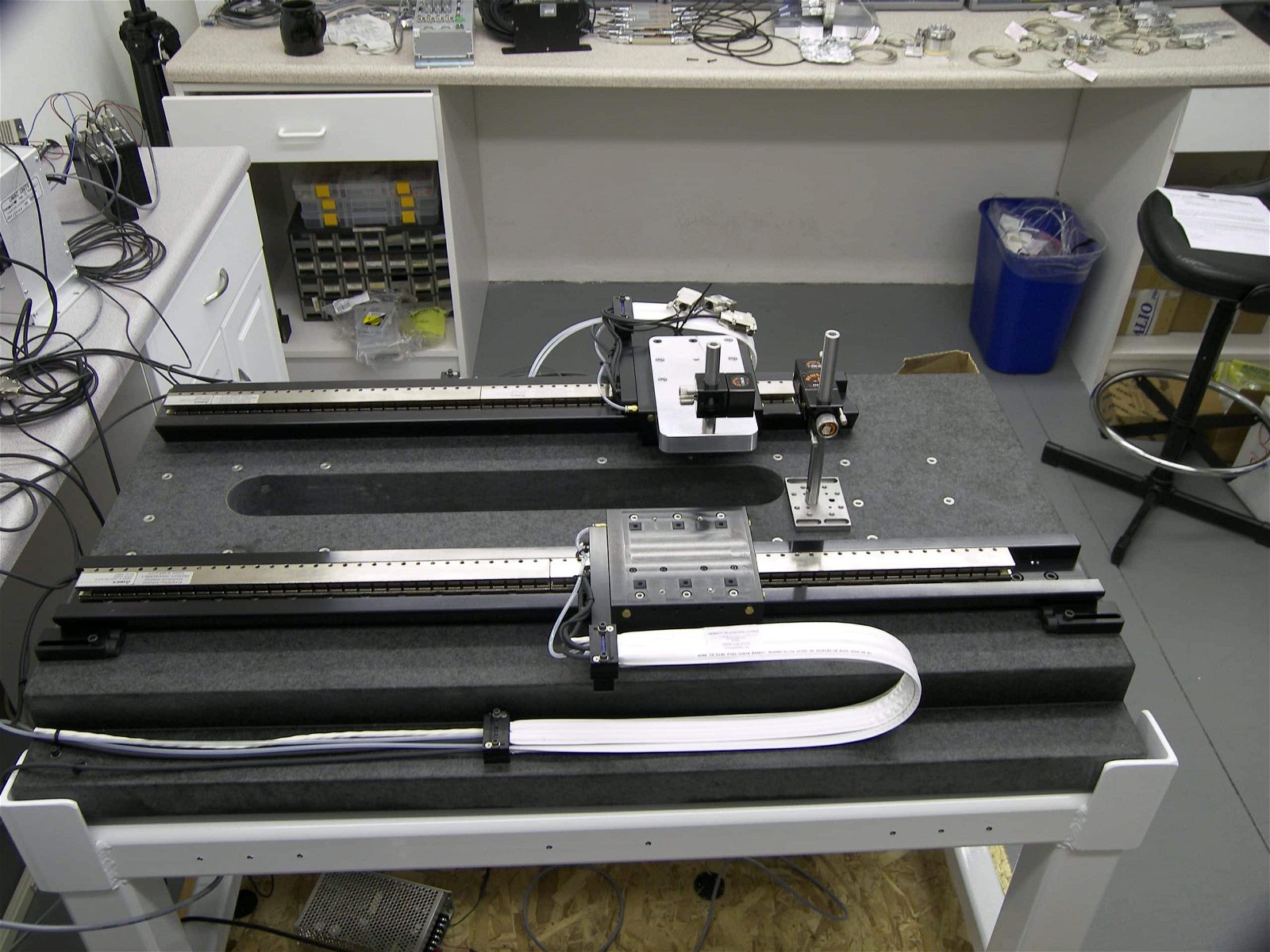
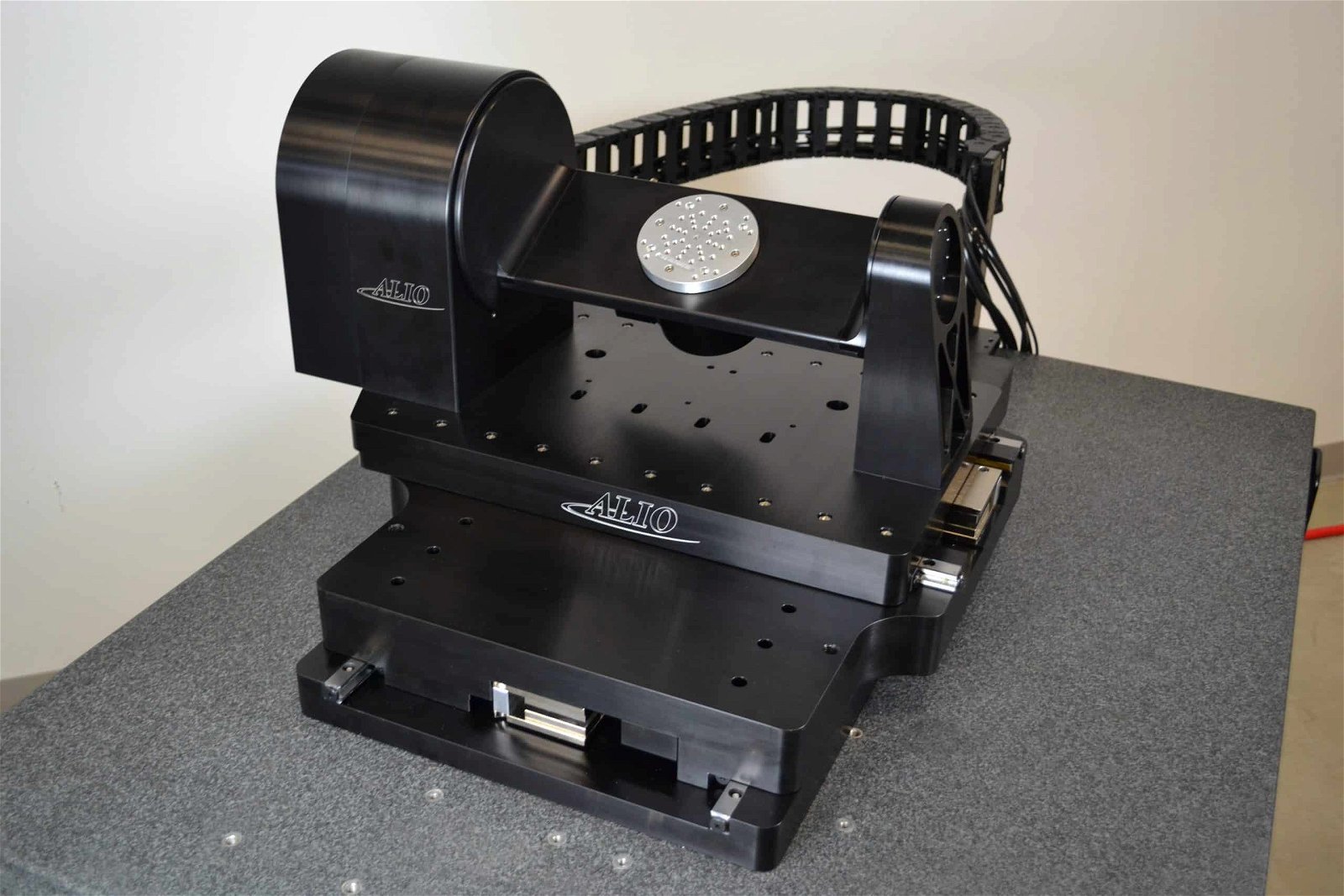
The SNH-series is a highly configurable gantry robot design based on ALIO’s proven standard stages that can be adapted according to customers’ load, throughput, precision, travel, and budget.
Customers may choose from XY travels from as little as 100mm or up to 1m plus and various powerful drive options allowing accelerations of up to 3.5G. With gantries being delivered on rigid base plates like granite, steel or aluminum frames allow superior precision with accuracy of +/- 1.5µm.
One key contributor to such high precision is our “Yaw Compliance” option — a virtual rotary axis allowing precise compensation for small angular misalignments that also may be used as an actual rotary axis for small intended angular motions.
Combining the gantry with optional degrees of freedom like z-axis, rotary axis, (Inverted) tripods or Hybrid Hexapods® or Gimbals makes this series to one of the most versatile and flexible high precision motion systems in the market.
You’ll likely find our gantries in industrial applications like laser machining or additive manufacturing / 3D printing, where an overhead motion is needed as samples can’t be moved or are extremely large.
An overview of “standard” configurations will show specifications:





ALIO’s patented 2-axis planar XY air bearing system has set the bar in the world of 6-D Nano Positioning®. As both axes use the same highly precise granite base as reference, advanced flatness of just a single micron over several hundreds of mm (or even meters) of travel ranges can be achieved.
Thanks to ALIO’s patented design and the proprietary 6-D Nano Precision test methods, this highly stiff family of planar xy air bearing motion systems delivers sub-micron accuracy, and a +/- 100nm bi-directional repeatability even in higher quantities for serial machine production. With 200 mm to 800mm standard versions, and possible customizations to over 3 meters of X and Y travel, this product family has no equal for True Nano® precision in any kind of measurement / metrology applications and in the semiconductor industry.
Powerful linear direct drives and air bearings make these motion systems perfectly suited to high precision, high throughput applications that require smooth continuous scanning or a fast step-and-settle process over very long distances.
For more information on the planar xy air bearing stages, and the numerous customization options available, contact ALIO or have a brief look at following data sheet:
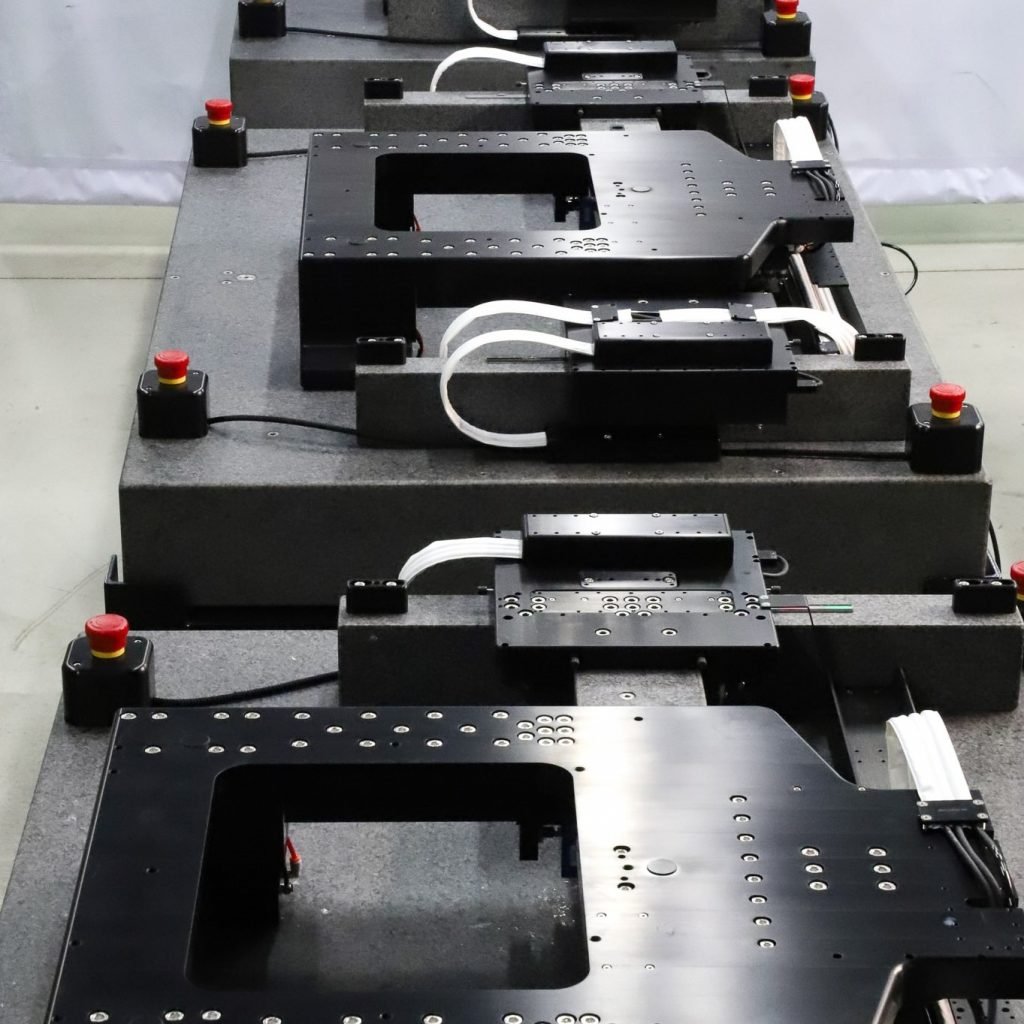
For many high-precision applications such as photonics, precision scanning in semiconductor or flat panel display manufacturing, or metrology, Linear Air Bearing stages (that float on a thin film of air) are a perfect solution.
Because the motion Is frictionless, no particles are formed, and the planar guideways they float upon are much more precise than mechanical bearings.
ALIO’s linear X Air Bearing stages are characterized by being very smooth and accurate, and provide extremely straight and flat motion. Out extremely high motion fidelity Motion Systems are based on a planar air bearing design driven by linear motors. Our Air bearing stages are used where ultra-precision is needed such in applications like wafer inspection, scribing, and flat panel inspection.
Check out some of our standard Linear X Air Bearing Stages:
Linear X Air Bearing Stages: AI-LM-(TRAVEL)00-AB
Linear X Air Bearing Stages: AI-LM-(TRAVEL)00-AB8
Box Rail Linear X Air Bearing Stages: AI-LM-(TRAVEL)00-AB-BR
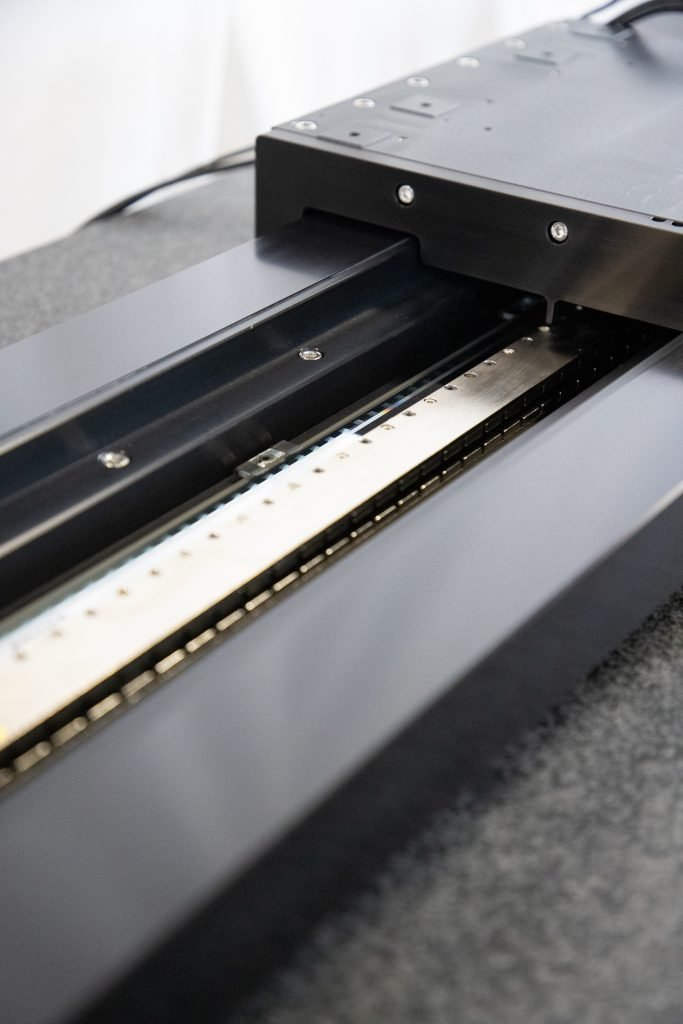
ALIO’s family of linear motor driven, vertical Z-lift stages with Air Bearing counterbalance are characterized by their low profile and extremely long travel ranges. Using high precision crossed roller bearings and linear encoders, the stages are equipped with a frictionless air bearing pneumatic cylinder. Similar to the GeoSymmetric series of stages, these long travel Z stages have counterbalance, motor, bearings, and encoder all placed on an approximate centerline of the stage. Payloads may be mounted directly to the face of the stage.
The Z-ABCB series — with its frictionless air bearing pneumatic cylinder counterbalance — can carry payloads of up to 25kg over 200mm or more.
Details:

NANO Z® patented Z-lift air bearing stages overcome the legacy design issues associated with z-wedges and other vertical stages. They use a novel combination of air-bearings plus two voice coil motors in a compact footprint with up to 50mm travel.
Using air bearings means negligible friction which enables unparalleled accuracy and repeatability down to low double-digit nanometers. Variable counterbalancing easily handles heavy weights like wafer chucks, while still achieving nano-level precision over the full travel range.
The Nano Z® design places vertical force in line with the payload, and this makes it possible to place the stage directly below the payload instead of beside it, avoiding inevitable cantilever inaccuracies and nearly eliminating pitch, yaw and roll.
Dimensions and specification can be found in following data sheet:
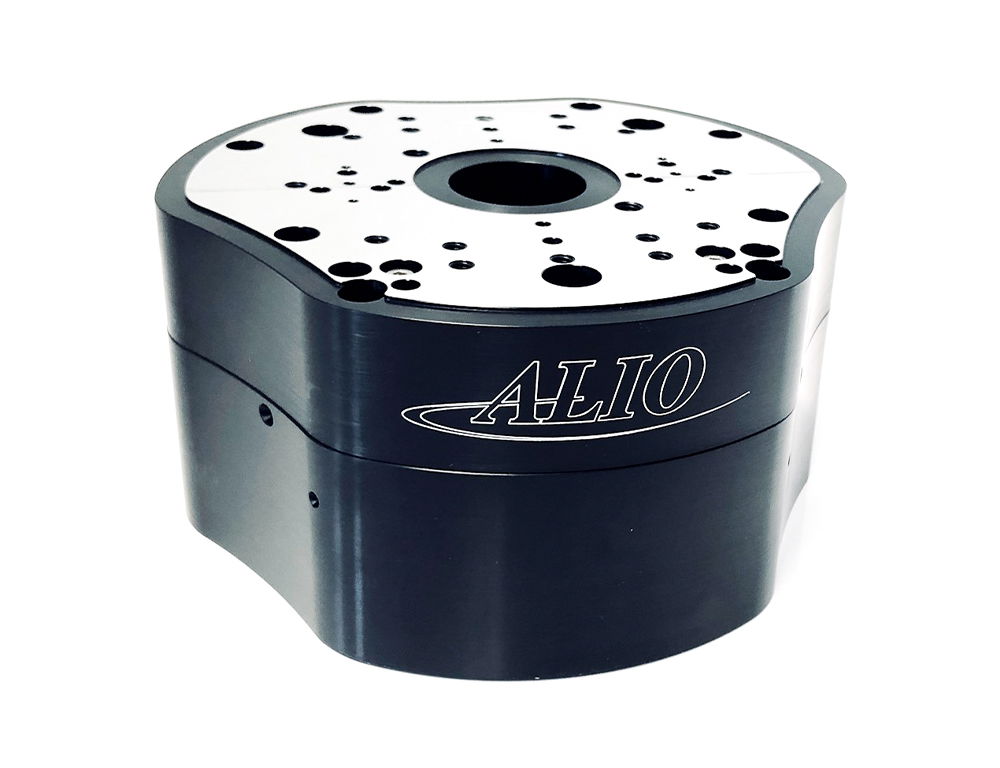
When the highest rotational precision is required, manufacturers can choose from ALIO’s line of air bearing rotary stages. Air bearings allow the stage to move without mechanical contact and therefore movement is frictionless and without wear. Errors like wobble, eccentricity, or runout can be minimized to get close to a perfect, smooth 360 degree movement even at high speeds or when the rotational stage is mounted vertically. Thanks to powerful torque motors, both constant continuous rotation as well as step-and-settle processes can be performed in an equally precise and reliable way.
It is no surprise that ALIO’s rotational air bearing stages can therefore be found in the most precise applications within the semiconductor, metrology, and photonics industries.
For detailed specifications please download the following spec sheets:

NANO Z® patented Z-lift air bearing stages overcome the legacy design issues associated with z-wedges and other vertical stages. They use a novel combination of air-bearings plus two voice coil motors in a compact footprint with up to 50mm travel.
Using air bearings means negligible friction which enables unparalleled accuracy and repeatability down to low double-digit nanometers. Variable counterbalancing easily handles heavy weights like wafer chucks, while still achieving nano-level precision over the full travel range.
The Nano Z® design places vertical force in line with the payload, and this makes it possible to place the stage directly below the payload instead of beside it, avoiding inevitable cantilever inaccuracies and nearly eliminating pitch, yaw and roll.
Dimensions and specification can be found in following data sheet:

ALIO’s GeoSymmetric™ Vertical Positioning Stages use voice coil or linear direct drives, high precision crossed roller bearings, and various counterbalance options within a unique and innovative design concept.
Unique geometric shapes provide mounting surfaces on multiple faces of the stage for flexible installation options. Being able to mount the payload directly to the face or top surface of the stage helps to eliminate weakness and resonant frequency issues associated with additional brackets.
The “Symmetric” part of the family’s name originates from the arrangement of the components used. The counterbalance, motor, bearings, and encoder are all placed on an approximate centerline of the stage, i.e. they are integrated in a way that their masses are symmetrically distributed over the stage.
This series of stages has been built for precision with application dependent counterbalances, and has been structurally designed to exceed application performance demands (with bidirectional repeatability down to +/-45nm, travels from 6 to 70mm, and load capacities of up to 30kg). Being 4x to 10x more precise than Z-wedge stages makes ALIO’s GeoSymmetric™ Vertical Positioning Stages great for any application within the semiconductor industry, microscopes for life and health science, or numerous metrology applications.
Explore our many options with a closer look at the relevant data sheets:
Pneumatic Counterbalanced Z: AI-(MOTOR)-(TRAVEL)00-(FORCE)-Z-CB
High-Force Pneumatic Counterbalanced Z: AI-(MOTOR)-(TRAVEL)00-(FORCE)N-Z-CB
Magnetic Spring Counterbalanced Z, Voice Coil: AI-(MOTOR)-(TRAVEL)00-(PAYLOAD)-Z-MCB-(ORIENTATION)
Mini Z with user-swappable Spring Counterbalanced Z: AI-(MOTOR)-(TRAVEL)00-Z-SCB

ALIO’s family of linear motor driven, vertical Z-lift stages are characterized by their low profile and extremely long travel ranges. Using high precision crossed roller bearings and linear encoders, the stages are equipped with magnetic spring counterbalances or a frictionless air bearing pneumatic cylinder. Similar to the GeoSymmetric series of stages, these long travel Z stages have counterbalance, motor, bearings, and encoder all placed on an approximate centerline of the stage. Payloads may be mounted directly to the face of the stage.
The Z-MCB versions with magnetic spring counterbalances allow travel between 25 and 170mm, while the Z-ABCB — with its frictionless air bearing pneumatic cylinder counterbalance — can carry payloads of up to 25kg over 200mm or more.
Details:
Magnetic Spring Counterbalanced Z, Linear Drive; AI-LM-(TRAVEL)00-Z-MCB-(MAX PAYLOAD)

A broad field of applications from industrial automation to large measurement or metrology tools demand enormous lift capabilities while still achieving nanometer precision. For such applications, ALIO offers vertical Z stages with precision ball screws driven by a frameless torque motor that is equipped with pneumatic release spring engage brakes that lift 20kg without additional counterbalance. For even higher loads, this series offers the so-called “pneumatic boost” option which uses a frictionless pneumatic counterbalance to boost the payload capability to 50kg.
Even with such high loads, these stages can achieve +/- 100 nm bi-directional repeatability over ranges of up to 50mm. This makes it the ideal stage for applications requiring high loads and long travel ranges without compromising precision.
More information on precision, accuracy and motion profile specifications:

When looking at most imaging applications, optimal focus of the image can only be achieved if the distance between the sample and the optics is adjustable. Typically, a Z-axis focusing stage would be used for such applications with either the sample or the optics being moved along the optical axis. The specifics of the application, the optics, and the sample will ultimately determine the range of motion required, with some examples where additional focus travel is needed being:
• For thick or non-planar samples such as tissue samples or cultured cells
• For non-parfocal objectives each of which have a different focus spacing
• Where there are multiple sample types such as microscope slides or microtiter plates
• When it is necessary to retract the optics during a load/unload operation
Some other advanced microscopy applications require that a series of images are acquired, each separated by a small increment along the Z-axis, such advanced focus control being needed to create 3D sample images.
For all such exacting applications, ALIO’s direct drive focus stage technology is up to the challenge:
Z Focusing Stage: AI-VC-600-SCB-ATRAK

ALIO Industries offers a series of linear motion systems that combine linear direct drives with dual recirculating ball rails, providing precision and flexibility to a wide range of applications. This system architecture allows customers to achieve micron-to-nanometer precision while overcoming budget constraints and exceeding the travel possible using crossed roller bearings.
The series includes nine standard stages with flexible travel ranges from 100mm to 700mm, and they can be used not only when mounted on a flat horizontal surface, but also when used on vertical surfaces or even inverted. The stages are designed with high-flex cabling, hard stops, high-resolution encoders, optical latching home index, and end-of-travel limits to ensure robust and precise motion.
For more information, take a closer look at the datasheet provided by ALIO Industries.

ALIO Industries offers two lines of “Slim” Micron 2 (µII) motion systems, featuring recirculating ball rail bearings and linear direct drives. These stages are available in compact or “naked” versions and are ideal for use in Cartesian Gantry systems.
With travel ranges of up to 1m and a slim profile of just 72mm width and 57mm height, these stages are an excellent choice when space is limited. Achieving a +/-0.5µm bi-directional repeatability, they offer excellent precision without compromising on size. ALIO’s proprietary design and manufacturing processes ensure superior flatness and straightness.
Check out the datasheets for more information:
Micron 2 Slim Rail Linear X: AI-LM-(TRAVEL)00-uII-S
Micron 2 Slim (Naked) Rail Linear X: AI-LM-(TRAVEL)00-uII-SN

These three series of products are designed for extreme applications. They can carry heavy, large objects, targets, and products and can be used over extra-long ranges. Equipped with dual recirculating bail rail bearings, driven by a linear direct drive, these robust stages can reach lengths of up to 2m on which with carrier plates up to 300mm wide and either 170mm, 270mm or even 306mm long.
It is therefore not surprising that all these stage can carry payloads of up to 100kg and achieve acceleration of 2.0 G -4.0 G.
What is perhaps more surprising, however, is that customers can still expect a bi-directional repeatability of less than +/-0.5µm and 1-digit micron and arc-sec in flatness, straightness, pitch, yaw and roll.
All details can be found on the datasheets:
Micron 2 Wide Dual Rail Linear X: AI-LM-(TRAVEL)00-uII-W

For certain applications, an electromagnetic linear direct drive might not be ideal. This is specifically true for applications that require the ability to hold position (literally no movement on power loss) even during a sudden or necessary power stop or loss. This is often critical when high payloads (but not only high payloads) are involved, or if a stage needs to be mounted other than horizontally.
ALIO has therefore extended its range of stages suitable for these kinds of challenges with further Micron 2 (µII) motion systems. Those stages known as the “SBS” and “XBS” series use a frameless torque motor that drives the carrier with a precision ball screw on dual recirculating ball rail bearings. For further strength, certain stages can be equipped with brake options contributing to the safety of the machines.
Even with this combination of drive and bearings, the stage will successfully accomplish applications requiring a bi-directional repeatability of only +/-1 µm. The ball screws anti-backlash nut ensures any backlash is avoided.
Further information concerning linear displacement accuracy, resolution, flatness, straightness or pitch, yaw, and roll can be found in the specific datasheet available for download:

ALIO’s Micron 2 Rotary Stages utilize frameless torque motors and angular contact, duplex pair bearings. These stages are designed to achieve maximum possible throughput without compromising on precision, regardless of whether the application requires a smooth, continuous movement or a fast step and settle process. Also allowing decent sized apertures, those rotational stages are used in a broad selection of applications and industries such as industrial manufacturing, photonics or semiconductor metrology.
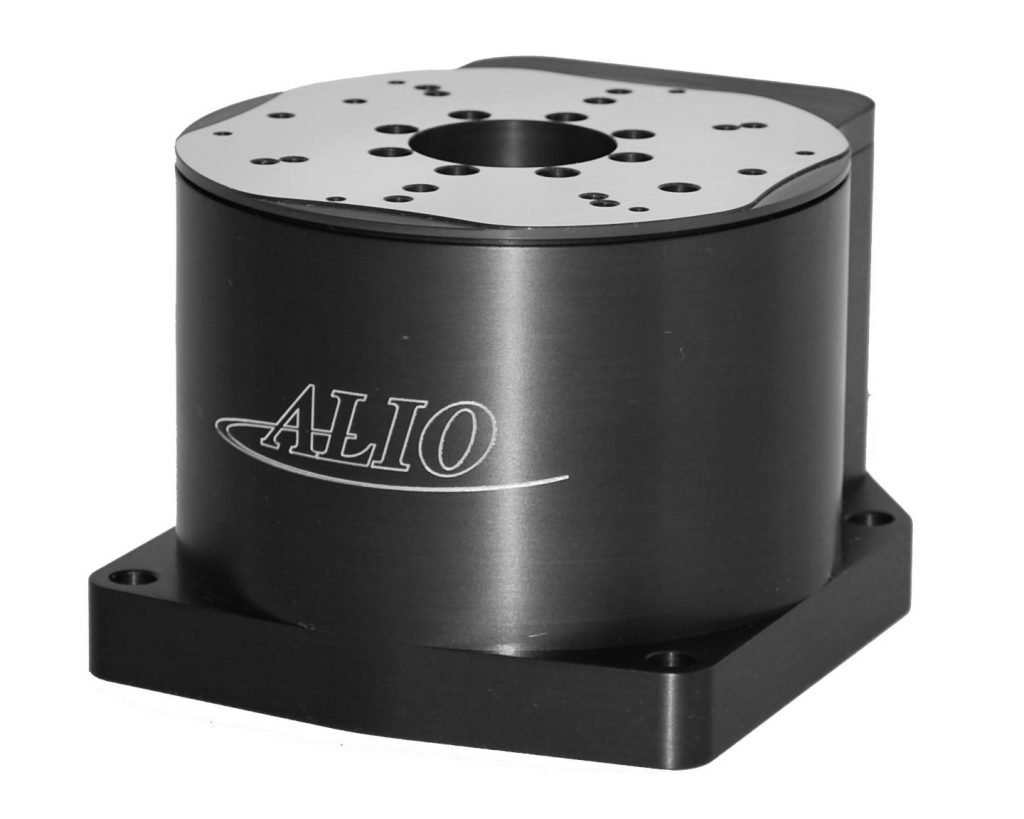
ALIO Industries offers a range of precision rotary stages that are designed to meet the most demanding applications. Our standard rotary stage family uses crossed roller bearings and frameless torque motors to provide extreme throughput, acceleration, and mass capabilities while maintaining nanometer-level precision. These rotary stages are also highly stiff and can handle offset loads with ease.
Our crossed roller bearing rotary stages have +/-0.2 arc-second repeatability and are rated at 13 to 20 microns of radial and axial run-out. Some models even offer run-outs below 5 microns. We also offer mechanical bearing rotary stages in different sizes to meet varying duty cycles, mass, and acceleration needs, ranging from 80 mm to 300 mm in diameter. For mounting a vacuum chuck, vacuum rotary union options are available on the inner diameter.
Explore ALIO’s range of crossed roller bearing and mechanical bearing rotary stages to find the perfect solution for your rotary motion system needs.
Need more details?

ALIO Industries offers mechanical bearing rotary stages with angular contact bearings to meet the requirements of applications that demand a compact and flat rotary stage with a decent aperture size. With torque motors, these stages enable a smooth continuous movement or a step-and-settle process over the full 360 degrees, without compromising precision or throughput. The stages are highly versatile and suitable for various industries and applications.
To know more about this family of stages, check out the spec sheet.
360 degree Angular Contact Bearing Stages: AI-TM-(DIAMETER)RA
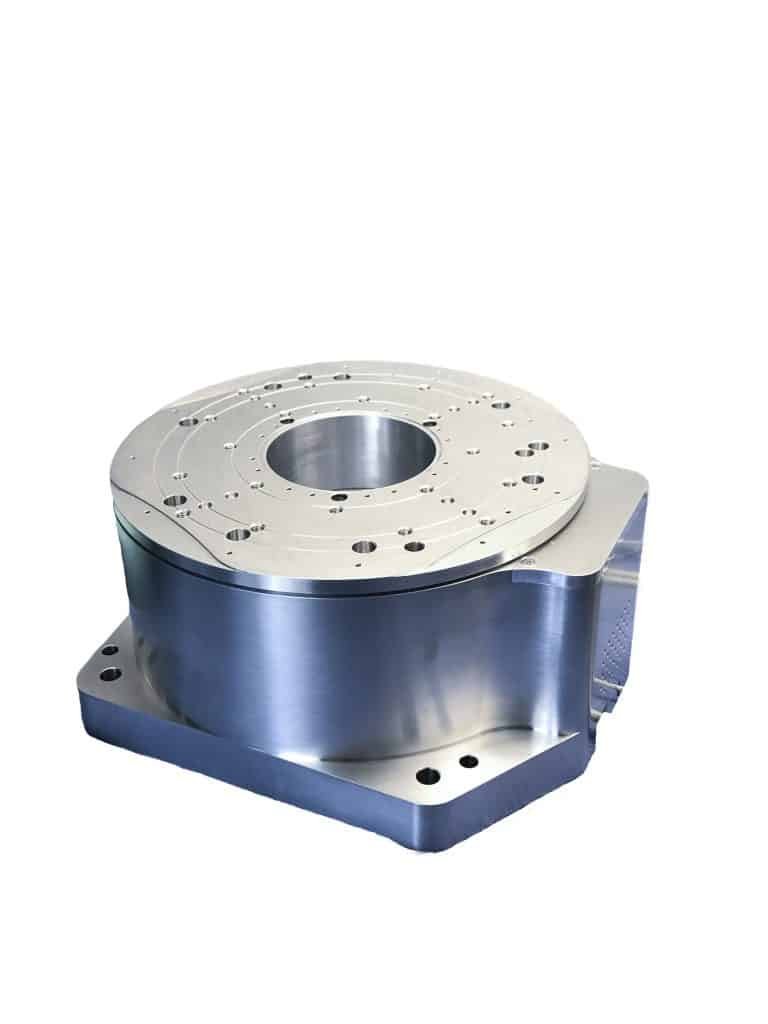
ALIO Industries offers a line of air bearing rotary stages for manufacturers that require the highest rotational precision. These stages move without mechanical contact, resulting in frictionless and wear-free movement. ALIO’s air bearing rotary stages can minimize errors such as wobble, eccentricity, or runout to achieve near-perfect, smooth 360-degree movement even at high speeds or when mounted vertically. Equipped with powerful torque motors, these stages can perform both constant continuous rotation and step-and-settle processes with equal precision and reliability.
It’s no wonder that ALIO’s air bearing rotary stages are commonly used in highly precise applications within the semiconductor, metrology, and photonics industries. For detailed specifications, download the following spec sheets:

ALIO Industries offers industry-leading torque ratings with its two-axis gimbal rotary systems, delivering high rotational speeds without sacrificing precision. The systems can be customized for each customer’s mass, with variable counterbalance, cable guidance, and cable and air feed-through capabilities. The dual-axis rotary systems allow for +/-110 and +/-170 degrees of rotation on the horizontal axis, while exhibiting angular travel +/-180 degrees for rotation about the vertical axis. An air purge is incorporated to protect against contamination and maximize lifespan.
ALIO’s 2-axis gimbal rotary systems have been utilized in a range of industries, including metrology, laser processing, and additive manufacturing. For more detailed specifications, please refer to the spec sheet.

ALIO Industries’ open-center rotary stages utilize tangential linear direct drives with angular contact bearings for up to +/-7.5 degrees of angular movement and an extreme aperture. These stages are ideal for high-precision applications, including the semiconductor, metrology, and life science industries. With rigid bearings and a powerful linear direct motor, they are designed to meet the high-throughput needs of the high-precision market.
Download our product spec sheet for more details.
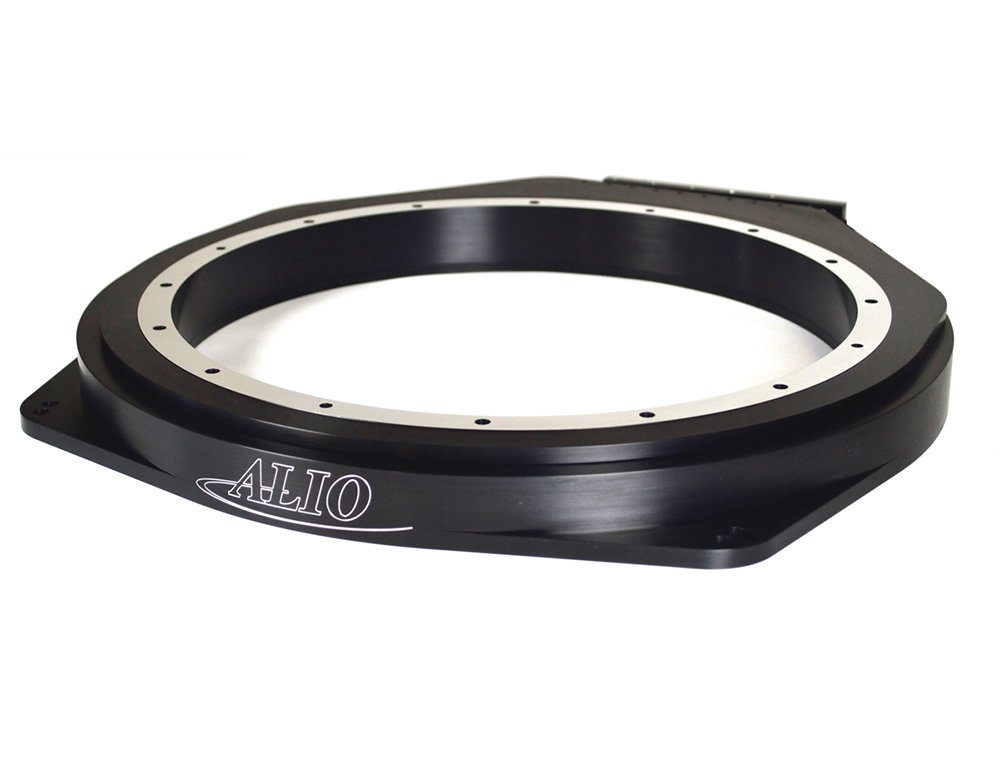
ALIO Industries’ linear X stages are the ideal choice for precision applications, as they are commonly used in the precision industry due to their reliability and performance. The family of stages offers a wide range of travel options from 30mm to 300mm by utilizing two types of linear direct drives: the “LM” and the “CM” series.
The “LM” series provides greater force, higher acceleration, greater speed, and supports payloads of up to 50kg, while the “CM” series offers a low-profile design for tools and applications with space constraints, without compromising precision. ALIO’s linear motion systems and linear X stages are the perfect choice for applications that require precision and reliability.
For more information please download and analyze the following datasheets:

ALIO Industries offers enclosed, monolithic XY stages that are suitable for ultra-precise applications. These stages feature direct linear drives and high-precision crossed roller bearings built into a compact 3-plate system. With nanometer straightness and flatness, as well as optimized orthogonality, the point precision is True Nano®. Standard travel ranges are from 30mm up to 400mm, and stages can be built for high vacuum or clean room applications if needed.
The bi-directional repeatability of these stages is only +/- 30nm, making them suitable for scanning applications requiring a smooth, continuous movement, or for fast step and settle processes when high output is required. The enclosed, monolithic XY stages are available in two series – the standard LM-series and the low-profile CM-series.
For more information, download the datasheets available on our website.

To download datasheets, look for:
ALIO Industries produces open-centered, monolithic XY stages with large apertures for accessibility from all sides. These stages use powerful direct linear drives and high-precision crossed roller bearings in a 3-plate system to achieve outstanding precision. With a bi-directional repeatability of just +/- 50nm, superior straightness and flatness, and optimized orthogonality, ALIO’s open-centered XY stages offer Nano Precision® with travel ranges of 30mm to 400mm. The stages are perfect for scanning applications requiring smooth, continuous movement and fast step and settle processes, and increase throughput substantially. They can be built for high vacuum or clean room applications. ALIO’s open-centered XY stages are available in standard LM-series or the more compact CM-Series. Download datasheets on our website.

Open-Centered Monolithic XY: AI-LM-(TRAVEL)00-(THRU)E-XY
Low-profile Open-Centered Monolithic XY: AI-CM-(TRAVEL)00E-(THRU)-XY
If you need a low-profile solution to avoid space constraints, require different travels in X and Y, and can’t compromise on performance and precision, there are hardly any off-the-shelf products on the market. ALIO’s asymmetrical, monolithic XY stages are unique in the market and can help solve this complex combination of motion requirements.
With linear direct drives, ultra-precise crossed roller bearings, and our 3-plate system, we guarantee highly precise and powerful motion, as well as perfect orthogonality of the X and Y axes in respect to each other.
“Asymmetrical” in this design concept refers to the two different travel ranges of these two stages that are usually achieved by mounting different linear X stages on top of each other.
For further information, contact us or download the following specification sheets:
Asymmetrical, Monolithic XY: AI-LM-(TRAVEL_X)x(TRAVEL_Y)-XY
Asymmetrical, Monolithic XY: AI-SLM-(TRAVEL_X)x(TRAVEL_Y)-XY
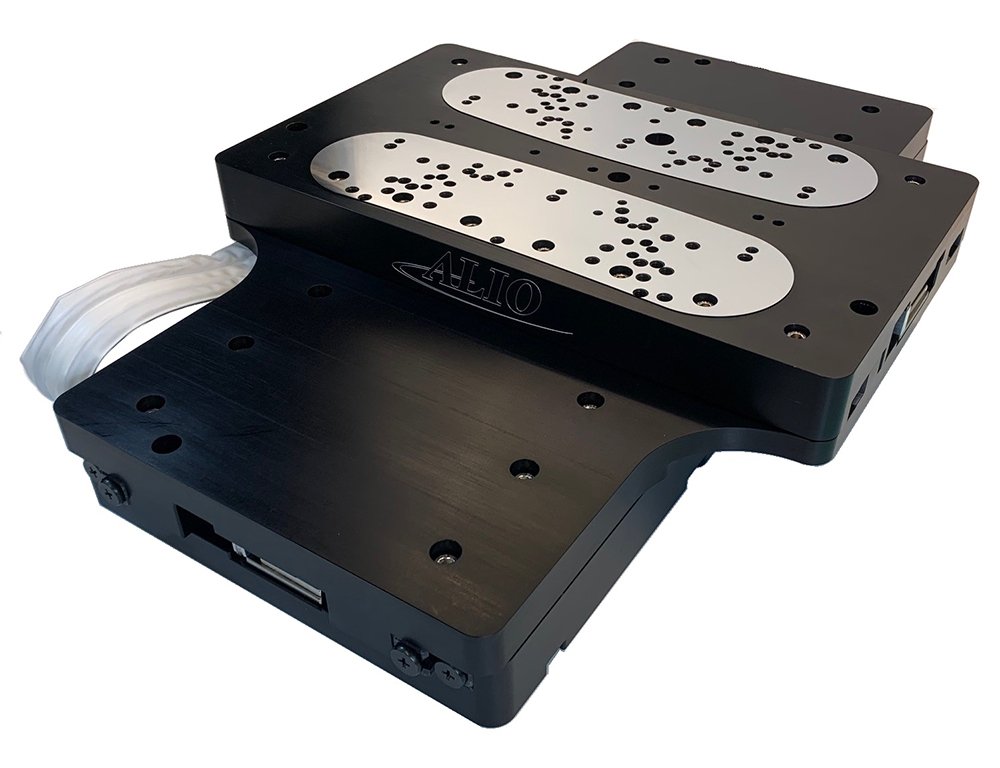
ALIO’s precision ball-screw driven X stages are perfect for applications that require precision despite electrical noise. These stages are driven by a torque motor that moves a precision ball screw with an anti-backlash nut, and they can be equipped with pneumatic or electric solenoid brakes if necessary.
Thanks to ALIO’s unique design and manufacturing principles, these stages achieve a bi-directional repeatability of only +/- 100nm, with straightness and flatness well below 5µm (and on request even 1µm can be maintained).
Off-the-shelf versions are available for travels of 30mm, 100mm, 150mm, and 200mm, and can be realized for ambient, high vacuum, and clean room conditions.
For more information on these stages, please refer to the following datasheet:
Linear X with Precision Ball Screw:_AI-VBS-(TRAVEL)00-(BRAKE OPTION)
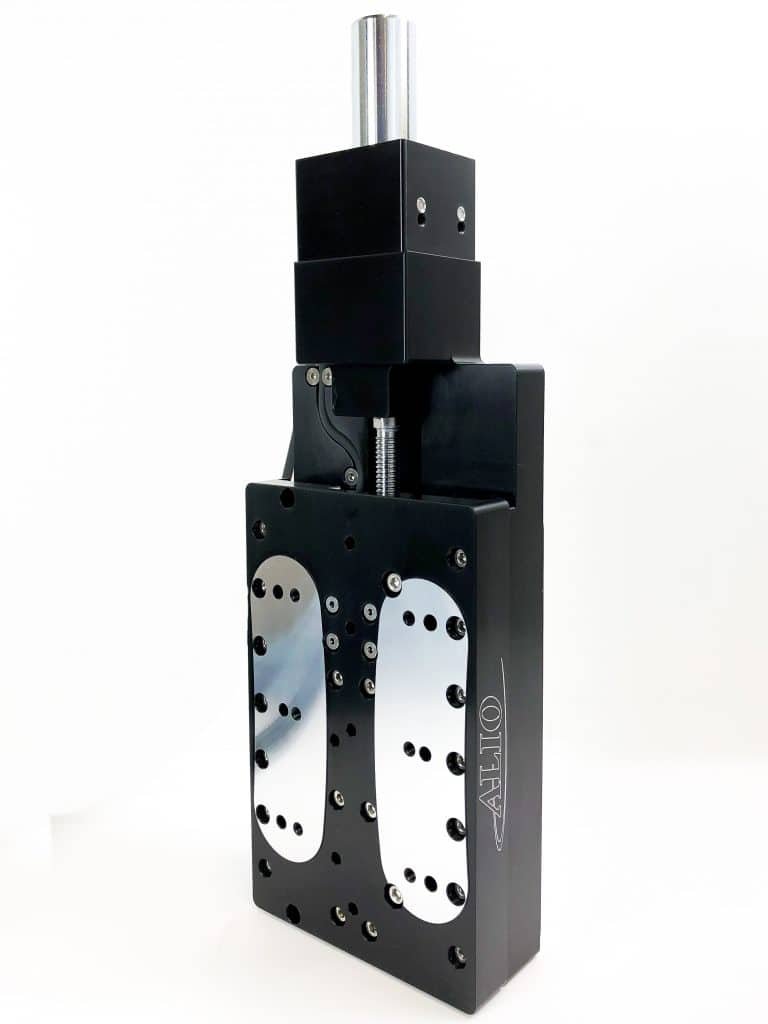
ALIO has introduced the Micron 2 (µII) motion systems family to compete in the micron-level motion control market. These systems are designed to offer low-cost, mid-precision, reliable, and long-travel stages. As with all ALIO’s products, the Micron 2 (µII) systems are designed with the company’s “quality first” standards, ensuring long-term reliable operation.
The Micron 2 (µII) recirculating ball rail bearing stages come in standard sizes of 100mm up to 2 meters, making them suitable for a wide variety of applications. This family of motion systems is robust and powerful, designed for use either as a stand-alone unit or as a top axis of an integrated solution.
For more details, visit the dedicated Micron 2 (µII) motion systems page.
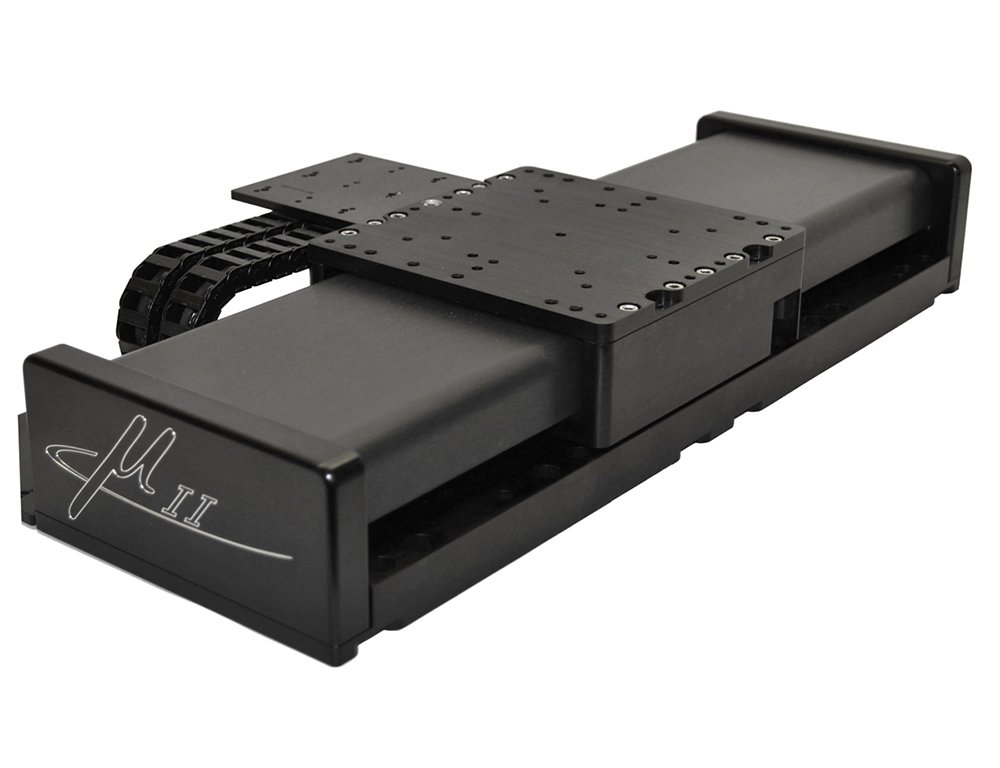
At ALIO Industries, we believe that traditional hexapods will soon become obsolete. That’s why we’ve developed the Hybrid Hexapod®, a patented and revolutionary approach to six-degree-of-freedom (6-DOF) positioning that delivers nanometer-level accuracy at any working point.
Our innovative modular design features a tripod with non-contact linear driven motors and linear encoders, offering any rotary- and Z-motion capabilities on a monolithic XY basis. Unlike traditional hexapods, the Hybrid Hexapod® boasts a unique stiffness, enabling us to avoid common problems associated with screw-driven Stewart platforms, such as pitch errors, backlash, and friction.
With our design, you can move in X or Y with just one axis, tip or tilt with just three legs of the tripod, and rotate around the Z-axis by adding a 360-degree rotary stage in the middle of the tripod. These features, along with many other specific details, make the Hybrid Hexapod® an ideal solution for any application requiring 6-DOF positioning with nanometer/arc-sec levels of incremental motion and repeatability.
If you’re looking for a unique design that can simplify your six-dimensional motion while drastically increasing your working cubic volume, turn to the Hybrid Hexapod® from ALIO Industries. To learn more about our standard configurations and what they can achieve, check out our comprehensive datasheet.
Standard Hybrid Hexapod: AI-HH-(XY TRAVEL)XY-(Z TRAVEL)Z-(R DIAMETER)R-(OPTION)
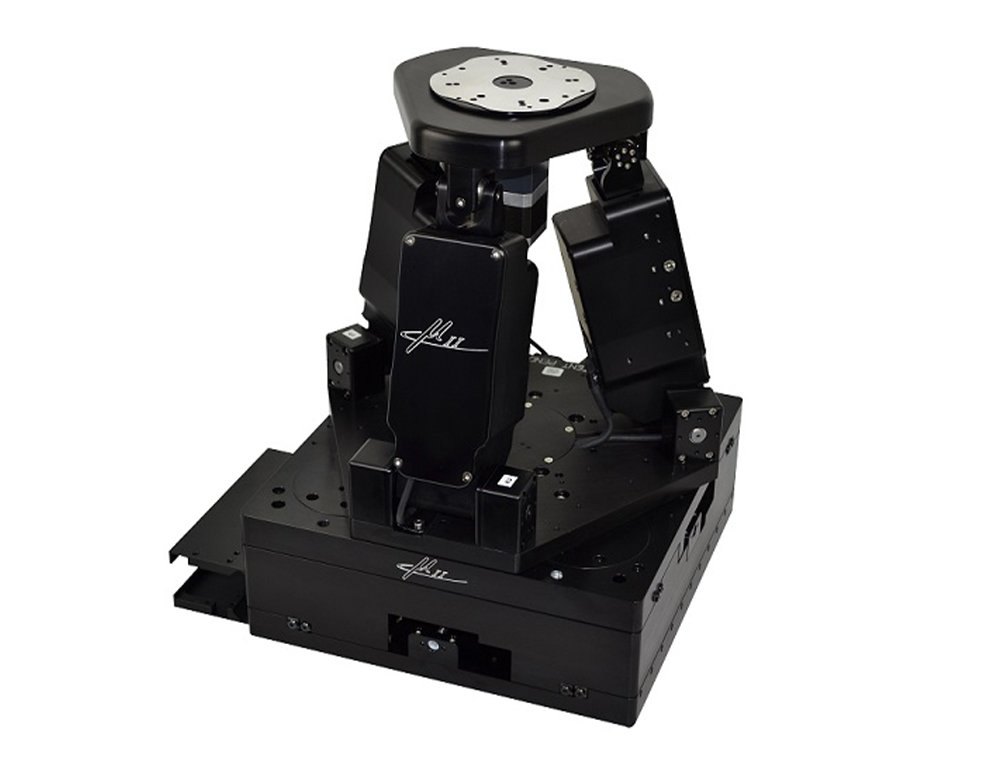
Looking for a compact yet high-performing solution for your six degrees of freedom (6-DOF) positioning needs? Look no further than the MINI Hybrid Hexapod® from ALIO Industries.
Despite its small size, the MINI Hybrid Hexapod® offers an impressive 54,000 mm2 working volume (60x60x15mm) and can be scaled to match your required working volume with options such as brakes, gear reduction, ball screw drive, and linear motor drive. This flexibility makes it an ideal solution for automated lens alignment or bonding processes, camera array modules, translational OIS, telescopic integrated lenses, and miniature camera products like cell phone cameras and drones.
When you need nanometer/arc-sec levels of incremental motion and repeatability, the MINI Hybrid Hexapod® delivers the performance you need with the compact size you want. To learn more about our detailed specifications, download our comprehensive datasheet today. Choose ALIO Industries for your 6-DOF positioning needs with one of our range of robotic hexapod solutions.
Find out more by downloading the detailed specifications:
Miniature Hybrid Hexapod: AI-HH-(XY TRAVEL)XY-(Z TRAVEL)Z-(R DIAMETER)RT-(OPTION)

The AngularesTM Hybrid Hexapod® from ALIO Industries offers the widest angular travel range of any 6-Degree-Of-Freedom (6-DOF) positioner on the market, with 60-degree tip/tilt travel. This new hexapod approach features precision crossed roller bearing guides, optical incremental or absolute encoder feedback on all axes, linear motor and/or servo ball screw drives, unlimited programmable tool center point locations, and zero backlash on all axes.
With unlimited XY travel, Z travel of 62 mm (expandable to 208 mm using other tripod models), and continuous 360 degree Theta-Z, the AngularesTM offers unmatched positioning performance. It delivers XYZ bidirectional repeatability of less than +/- 100nm, velocity up to 100 mm/second XY and Z, and less than 10 nanometers linear and 0.1 arc-seconds angular minimum incremental motion.
The AngularesTM is ideal for various applications such as aspheric and freeform optical metrology, silicon photonics packaging and probing, laser micro processing, wafer metrology, camera module alignment and assembly, and optical element and fiber alignment.
Download data sheets to learn more about the AngularesTM Hybrid Hexapod® from ALIO Industries.
AngularesTM – Extra large Tip/Tilt: AI-HH-30D-(XY TRAVEL)XY-(Z TRAVEL)Z-(R DIAMETER)R

ALIO’s modular and versatile Hybrid Hexapod® concept allows various adaptions and customization to align with your application requirements. These can range from applications with several dozens of kg load and high force requirements, to totally novel designs with large apertures. Some requirements have been so commonly requested that we decided to standardize them and make them available to all our customers. See specific details below:
High Torque Hybrid Hexapod: AI-HH-(XY TRAVEL)XY-(Z TRAVEL)Z-(R DIAMETER)RGR
High Load Hybrid Hexapod: AI-6D-(XY TRAVEL)XY-(R DIAMETER)R-(Z TRAVEL)Z-(OPTION)
Ball Screw Driven Hybrid Hexapod: AI-HH-BSD-(XY TRAVEL)XY-(Z TRAVEL)Z-(R DIAMETER)R-(OPTION)
Stepper-Motor based Hybrid Hexapod: AI-HH-ST14-(XY TRAVEL)XY-(Z TRAVEL)Z-(R DIAMETER)R-(OPTION)
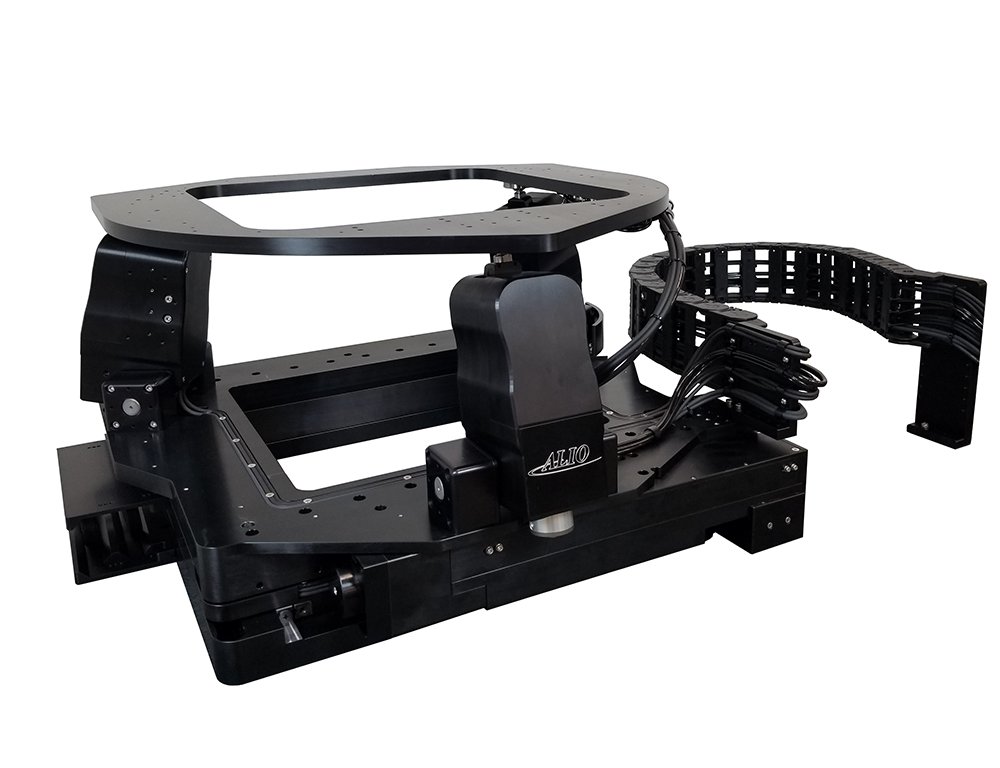
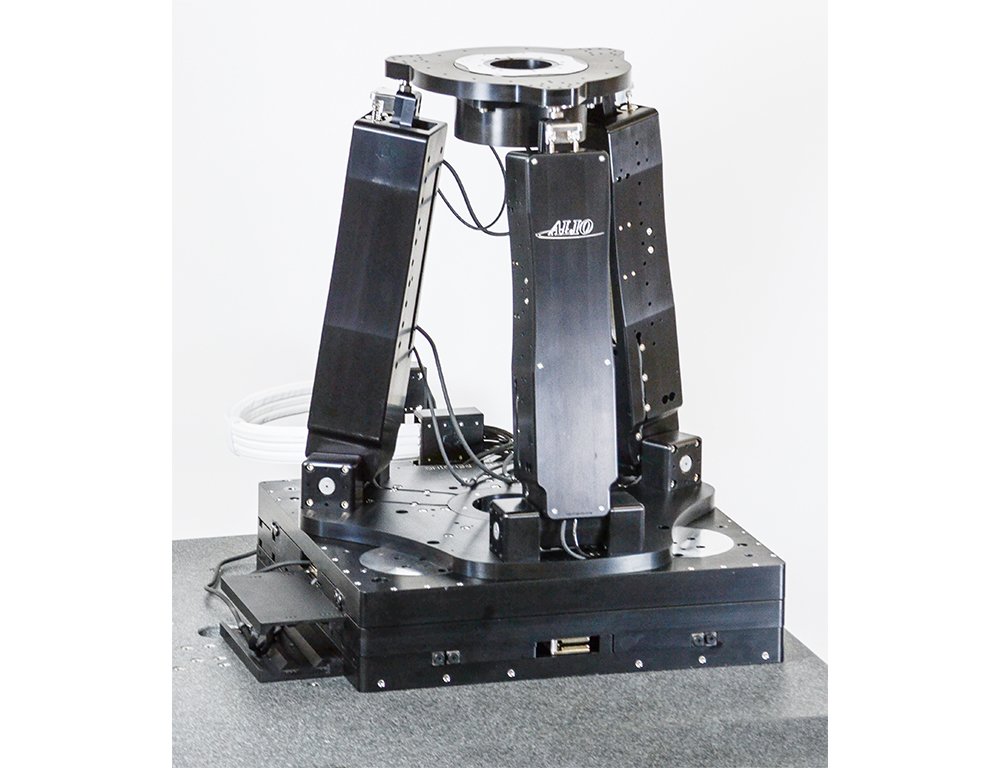
Welcome to WordPress. This is your first post. Edit or delete it, then start writing!
Leading nanometer-level motion control solutions innovator ALIO Industries, is heading an initiative to ensure that manufacturers seeking highly accurate motion control solutions do not end up investing in sub-optimal solutions — either due to a lack of understanding of the differences in available technologies, or by partnering with suppliers that do not have the pedigree to achieve the precision required.
Questions need to be asked that delve into motion control vendors’ capabilities and their values. Only by so doing will manufacturers avoid the wasted time and expense as they strive for greater and greater precision.
Bill Hennessey, CEO at ALIO says, “If your short-listed precision motion control technology provider is really credible, it will be able to show you a series of innovative solutions that redefine the motion control market. Here you should be looking for evidence of next-generation technologies, not variations of legacy traditional motion control technologies. This is like the difference between vendors selling hexapods and a company like ALIO Industries that sells the Hybrid Hexapod®, which overcomes process limitations in traditional hexapods, and exhibits orders-of-magnitude improvements in precision, path performance, speed, stiffness, and larger work envelope.”
“Pinning down motion control vendors over statements of precision is a minefield. Ultimately, claims on nanometer-level precision are meaningless unless this nanometer-level precision is achieved repeatably. Vendors that cannot achieve repeatable nanometer-level motion control often need to resort to at worst false, and at best illusory claims. So saying look for evidence of vendors that are trying to move the conversation along. ALIO Industries, for example, now talks in terms of Point Precision® referencing performance specifications to a point in space at the single digit micron or nanometer level. It is vital that you interrogate precision claims diligently before a making motion control technology purchase. It is also critical that ASTM and/or other internationally registered standards are followed by vendors, instead of methods developed to place a particular vendor’s products in a better light, and which provide flattering data calculations which give a false illusion of precision,” Hennessey continues.
Most vendors sell off-the-shelf solutions and leave their customers to align them with their specific applications. In a way, this demotes motion control to a necessary evil, a link in a process chain that is expensive and complicated. But when a vendor provides truly cutting edge nanometer-level accurate and repeatable motion control solutions, it elevates motion control from a necessary evil to an enabling technology. If a vendor provides the best-in-class, most accurate, and most repeatable motion control solutions on the market, they will be able to push the boundaries of what customers may see as possible, and will therefore promote the ability to innovate. Try and assess a short-listed vendor’s view of motion control. Do they see obstacles and problems, or opportunities and solutions?
Walter Silvesky, VP Sales at ALIO says, “Ideally your chosen motion control technology vendor should not sell products but instead solutions. The key is to be able to customize motion control solutions to specific customer applications. A vendor supplying nanometer-level motion control solutions should be able to prove its credentials and demonstrate that it has provided a significant number of best-in-class, efficient, and cost-effective motion control solutions for an array of different industry applications. Ask your chosen vendor for evidence!”
Beyond technological pre-eminence, a motion control technology provider should place an emphasis on being a strategic partner in product development. It is only by doing this that customers can be confident about achieving challenging motion control and manufacturing goals.
Vertical integration is another key to success. When working in a world where nanometer-levels of accuracy are the norm, it is vital that motion control products are manufactured in one facility. Ask a vendor whether they have design, machining, metrology, manufacturing, and assembly under one roof. The cross collaboration between product development teams is vital to the achievement of reliable and repeatable ultra-precise motion control solutions.
Silvesky concludes, “Also, drill into the experience and technical know-how of your short-listed vendor’s team. Especially when a customer’s demand is for nanometer-level motion control, it is important to make sure that a vendor has a dedicated focus which will translate into innovative and cutting-edge motion control solutions. Much of this is about the culture in a vendor company. Assess whether you detect a “can do” attitude and whether your vendor seems to nurture a collaborative environment. In essence the choice of a nanometer-level motion control solutions provider is based on a number of factors, and is a mix of not just technological competencies but also core values and what “makes a company tick”. Investment in an ultra-precise motion control solution is expensive, and customers need to be certain before nominating a motion control vendor that they will have a best-fit solution that is right first time.”
ALIO Industries provides optimal motion control solutions for its customers by constantly focussing on nanometer-level precision and repeatability. There is much debate about the validity of claims made in the area of motion control when it comes to extreme accuracy, and the differences between claims of nanometer-level precision and repeatability and its actual attainment are a hot topic today.
Ultimately erroneous claims lead to customer dissatisfaction and failure of often critical industrial applications, and it is because of this that ALIO Industries is at pains to prove its nanometer-level motion control credentials, and also to move the conversation on to facilitate the better understanding of how the motion control world needs to accommodate and understand true nano-precision.
To help in this endeavour, ALIO Industries has been busy redefining the language that the most accurate of motion control systems should use, and has backed this up by registering brand names that it alone can use to demonstrate the company’s unique status in the sector.
Bill Hennessey, CEO at ALIO Industries explains, “First off, we have registered the phrases True Nano Positioning® and True Nano®. Nano has become the new buzz word in the motion and manufacturing sectors in recent years. Most stage companies have recently started to claim “nano” as a marketing hook for their products. ALIO has focused on building nano precision stages for nearly 20 years and we felt it necessary to protect our long-term IP and commitment with trademarks. Companies offer nanometer-resolution or large nano errors with uni-directional planar numbers which are actually micron errors on true stage performance. Resolution means absolutely nothing in the True Nano® world.”
ALIO Industries has also registered the phrase 6-D Nano Precision®. ALIO designs, builds and tests stages in all 6 degrees of freedom, believing a nano precision stage most importantly must have sub-micron straightness and flatness as well. Some motion companies claim nano repeatability and accuracy (which are a planar numbers) knowing the customer application needs ultra-precise straightness and flatness to succeed. Customers’ assumptions of nano precision are mostly based on 2 D planar precision without focus on 6-D. ALIO wanted to define a term that represented the higher levels that its products could attain, and therefore set itself apart from companies that make unproven data sheet claims of accuracy.
Walter Silvesky, VP Sales continues, “Another area that we consistently drive the message is in the area of how accuracy should be validated in the nanometer-level world. So saying, we registered the phrases 6-D Point Precision® and Point Precision®. These trademarks are an extension of the “True” and “6-D” references to performance specifications to a point in space, not the planar methodology current standards use. ALIO’s focus on nano precision position of stages at a point in space is the basis of the new ASME standard for measuring motion systems that NIST is collaborating with. This new standard and ALIO’s long-term focus on nano precision motion systems plus our trademarks strongly position us for all future ultra-precision or nano precision motion systems. Point Precision® and 6-D Point Precision® both define bi-directional repeatability of all 6 degrees of freedom (linear, straightness, flatness, pitch, yaw and roll) to a single point of precision in space for a single motion stage. In ALIO’s case we push this singular stage approach even further with our monolithic XY stages which have combined 6-D point precision at the nanometer precision level of the both axes combined.”
ALIO Industries also owns the trademarks Nano Metrology® and Nano Z®. Nano Metrology® was registered in deference to the evolution and novel designs of metrology sensors which created a need for better stages to move the sample or sensor. ALIO introduced the novel idea of nanometer precision of straightness of travel to reduce the uncertainty of measurement, and has the ability to measure at the nanometer level of uncertainty which include motion and sensor combined error quotients.
The Nano Z® trademark was born out of work that ALIO undertook in the semiconductor industry on a planar XY air bearing and an air bearing Z stage for wafer manufacturing and metrology. The Z lift stage design was so novel that ALIO trademarked its name, and it reinforces the company’s ability to move in Z, vertical, or lift a part with nanometer precision.
Hennessey concludes, “With the recent trademarking of the now well-known and ground-breaking Hybrid Hexapod® which is two orders of magnitude more precise than legacy hexapods, ALIO Industries exhibits an ability to think ahead in its developments in the nanometer-level motion control sector. The company is consistently redefining the language, understanding of, and standardization of nanometer-level motion control solutions to ensure that OEMs attain the levels of accuracy required for project success.”
Leading nanometer-level motion control technology innovator — ALIO Industries — is continuing to advocate the examination of the impact of 6D repeatability testing and performance on single and multi-axis motion control systems. Advancements in manufacturing processes and metrology sensors along with the continuing demand from industry to create innovative technologies and products is driving a greater need for motion systems that are both highly accurate and repeatable at the nanometer level.
All motion systems operate in 3-dimensional space and have errors in 6 degrees of freedom (6-DOF). However, motion systems are often only characterized by performance data of a single or subset of these 6-DOF. This practice leaves several error sources unaccounted for in performance data and specifications. ALIO suggests that repeatability performance for metrology inspection and manufacturing systems must now be analyzed and specified using a “point repeatability” method that accounts for 6D spatial errors in order to provide true representation of nanometer-precision performance.
Traditional systems and test methods — plane repeatability. Many traditional stage and motion systems specify repeatability as a single number representing the variation in linear displacement along an axis of travel, i.e. plane repeatability. Historically, this practice was valid as the repeatability specifications were large enough that other error factors were only a small percentage of the total error and could be ignored.
The repeatability of the plane position along the axis is effectively measured over many cycles at a target position. The intersections of this plane with the axis is a point on the axis line and the collection of these points results in 1D repeatability performance.
This test method makes a critical assumption, namely that the plane only moves in one dimension and the axis is perfectly straight. At the nanometer-level, this assumption is not realistic.
6D nano precision — point repeatability. In nanometer-level precision systems, “other” errors that were previously ignored in less accurate systems often become equal to or greater contributors to the 6D repeatability performance. At the nanometer-level, the axis of travel should actually be shown as bending and twisting through three-dimensional space and thus plane visualization becomes meaningless as it will tip, tilt, and twist as the stage moves along the axis. The stage moves in 6D space, therefore neglecting these additional error sources can result in a misrepresentation of actual stage repeatability performance.
Each linear (or angular) direction the stage moves (or rotates) in results in a positional error in that direction. That motion, which must not be neglected when nanometer-precision is desired, will have an associated repeatability of that error motion. Each point on a stage mounting surface will move in 3D space as of a result of this error motion in 6 degrees of freedom. It is the point repeatability of an infinite number of points attached to a stage, that must be characterized by testing and specification data. Thus, each point repeatability will result in a spherical repeatability range.
Measuring 6D point repeatability. To accurately characterize repeatability, X, Y, and Z components must be measured in a systematic process to characterize the point repeatabilities of a stage along the entire axis. Additionally, a process must be implemented to test the influence of pitch, yaw, and roll errors of the axis and their influence on repeatability. In order to have a high confidence in integrated system performance the motion subsystems must be correctly characterized for 6D performance accounting for all error components of stage motion. Without this, claims of accuracy and repeabality are at best pointless, and at worst knowingly misleading.
6-D Laser LLC is an affiliate of leading nanometer-level motion control specialist ALIO Industries, its mission being the integration of ultrafast laser processing with precision multi-axis motion systems.
6D Laser’s central mission addresses limitations of existing laser processing systems which are largely due to sub-optimal positioning systems used by most system integrators. 6-D Laser tackles this problem by integrating ultra-fast laser material processing with the 6-D nanometer-level precision motion control solutions in which ALIO Industries specializes.
6D Laser vertically integrates all of the sub-systems required for precision laser micro-processing, and it does this by forming strategic partnerships with key component and subsystem suppliers that are required to achieve the goals of demanding precision applications.
In addition to its association with ALIO, 6-D Laser has also partnered with SCANLAB GmbH, which together with ACS Motion Control, has developed an unlimited field-of-view (UFOV) scanning solution for coordinate motion control of the galvo scanner and positioning stages called XLSCAN.
In the area of high-performance planar processing, 6D Laser’s Unlimited Field-of-View (UFV™) solution combines the precision galvo scanning of SCANLAB’s XLSCAN system with ALIO’s precision monolithic XY stages for superior UFV™ accuracy. As customers’ requirements of laser micro-processing applications become more demanding, the performance of legacy systems do not meet the specifications for accuracy, repeatability, and precision.
Conventional unlimited field of view systems that control a scan head and XY stage typically use the high-speed galvo scanners to compensate the slower stage’s following error. A tracking error is induced by the mass inertia and the design of each system’s servo control loop.
This means the real position of the laser spot lags the target position. Therefore, the real laser spot position is correct only after a certain amount of time – and the system momentarily oscillates. Because of this, any imperfections in the stage error mapping, or galvo field correction, will impact the overall precision due to the time lag in the servo loop cycle.
In practice, attempts are made to extrapolate the slower stage’s behavior using estimated values, but that approach only works reliably at slow speeds and for non-abrupt motions.
Especially at corners and sharp features with high acceleration or deceleration rates, this strategy can produce significant position errors.
The XL SCAN control solution used by 6D Laser applies intelligent filters to control the scan head and stages such that physical limitations of each system are taken into account prior to processing, in an integrated trajectory plan. The positions of both systems are coordinated with each other to sub-micron level precision within micro-second cycle time.
XLSCAN synchronizes the motion of the galvo scanhead and linear stages to increase the total field size without stitching or “tiling”. It has higher accuracy than competitive systems through intelligent trajectory planning. Its precision is only limited by the image field calibration and stage error mapping.
Automatic laser control can correct the spot distance relative to the velocity and the laser power across the scan field, and for increased throughput four scanheads can be controlled with a single XLSCAN controller.
In addition, the laser signal can be raised or attenuated in accordance with application requirements. This applies to straight as well as rounded laser markings, and multiple parameter changes and jumps for individual vectors are also possible.
Dr. Stephen R. Uhlhorn, CTO at 6-D Laser concludes, “Infinite Field of View (IFOV)processing systems offer considerable advantages over traditional field-stitching systems by combining the high-speed scanning of galvos with the large field sizes available with motion control stages. This increases processing speed while eliminating errors from field stitching. However, current systems are limited to processing 2D planar substrates. As manufacturing geometries continue to increase in complexity, the need to control angle of incidence (AOI) for non-planar substrates becomes crucial. 6-D Laser’s integrated IFOV laser processing system — built around ALIO’s 5-axis Laser Gimbal — solves this complex manufacturing problem.”
The patented Hybrid Hexapod® was developed by ALIO to address the critical weaknesses of conventional legacy hexapod designs, as well as the weaknesses of stacked serial stages, and to achieve nanometer-level accuracy, repeatability, and high-integrity flatness and straightness during motion. It utilizes a tripod parallel kinematics structure to deliver Z plane and tip/tilt motion, integrated with a monolithic serial kinematic structure for XY motion. A rotary stage integrated into the top of the tripod (or underneath it, depending on application needs) provides 360-degree continuous Theta Z rotation. In this hybrid design, individual axes can be customized to provide travel ranges from millimeters to over one meter, while maintaining nanometer-levels of precision.
However, Bill Hennessey, CEO of ALIO Industries doesn’t look pleased. “I think that maybe the use of the words precision and accuracy by companies working in the motion control sector should be banned. They are meaningless words unless qualified, and even when qualified, can still mean nothing. I see companies claiming, ‘high precision’, ‘best accuracy possible’, ‘ultra precision’. What do these phrases mean to an end-user? How useful are they? Are they just marketing speak, or do they have a currency in industry? Nothing, not at all, and no I’d say!! At ALIO we talk of nanometer-level repeatability, accuracy and precision which actually means something, and as such the use of our motion control solutions in industry grows exponentially.”
The source of Hennessey’s disquiet is that he has positioned ALIO Industries as the world’s only provider of true nanometer-level motion control solutions, and with the Hybrid Hexapod, for example, has developed a technology that exhibits such True Nano Precision® that existing industry validation standards are useless, and a set of new standards based on ALIO’s Point Precision® methodology is being developed by NIST.
“You see, when discussing precision and accuracy, when it comes to motion control there are too many variables that are not fully understood by customers, and which technology suppliers are fully aware of and swerve in their marketing and communications, using data that flatters to deceive, or deceives completely”, Hennessey continues.
“In many ways, the most accurate end of the motion control market is quite a confusing place to be, as the handful of extremely accurate motion systems suppliers tend to use non-consistent and often illusory ways of describing the levels of precision that they can attain. ALIO has always worked in the area of nanometer-level motion control, and as such has a unique perspective on what really works when looking for this level of precision. Because of this, and with the Hybrid Hexapod® very much front and center, we have focussed on educating the customer base to navigate alternative solutions, and give them the tools to interrogate solutions providers in such a way that they can secure a motion control technology suited to their specific applications.
The Hybrid Hexapod had been a game changer for enabling new and novel processes.”
ALIO Industries believes that any claim of precision or accuracy must be first meaningful, and second provable. When looking at motion control solutions such as the Hybrid Hexapod, this is vital, as in common with all hexapods it is a motion control technology that operates with 6 degrees of freedom (DOF), and operates in 3-dimensional space. Because of this the conversation needs to move toward volumetric accuracy.
Despite this, all 6-DOF motion control solutions suppliers are characterised by performance data of a single degree of freedom. This practice leaves error sources unaccounted for in several degrees of freedom, especially in the areas of flatness and straightness, which are critical precision needs at the nanometer-level. The traditional hexapod’s best flatness and straightness of travel is still no more precise than in the order of magnitude of tens of microns per axis.
Because hexapods have six independently controlled links joined together moving a common platform, the motion error of the platform will be a function of the errors of ALL links and joints. Hexapods are known to have optimum accuracy and repeatability when performing Z-axis moves, because all links perform the same motion at the same relative link angle. However, when any other X, Y, pitch, yaw or roll motion is commanded, accuracy and geometric path performance of the hexapod degrades substantially because all links are performing different motions.
It is generally accepted that hexapods have relatively good stiffness compared to serial stacked multi-axis systems. However, it is often only the hexapod’s “Z” (vertical) stiffness that is considered. Geometric design stiffness has a critical impact on and hexapod’s platform repeatability and rigidity. A lack of design stiffness relates directly to a weak XY plane stiffness with the conventional hexapod working platform. Moreover, this inherent design flaw of the conventional hexapod negatively affects XY axis performance, especially with thermal bonding or machining applications that require more force to be performed accurately within the XY plane.
Hennessey continues, “Traditional hexapod providers are aware of these issues, but instead of confronting them, mask the inefficiencies inherent in the system by throwing meaningless precision claims at the situation or not drawing attention to them at all. One for example makes accuracy claims that seem really good, but are in fact impossible to achieve on any 6-link architecture, and above all would be totally out of reach of any customer. The reason for this is that the precision specs that they quote only apply to single axis moves from the center / mid-stroke default position. Who would ever buy a 6 DOF hexapod to only use it one axis at a time at its center of travel? The accuracy as you move to different positions and angles has to degrade probably by multiples of 5x to 10x.”
The Hybrid Hexapod® represents a quantum step forward in motion control, and for the first time provides the ability to achieve repeatable nano-level precision, stimulating innovation and promoting manufacturing efficiency previously considered impossible. It is redefining the area of precision motion control, and the rule book is having to be rewritten to accommodate it and to position it correctly against industry alternatives.
The level of precision achievable with the Hybrid Hexapod renders the vague and illusory industry standard claims of micron and sub-micron precision redundant, and has forced industry to move towards the concept of Point Precision®.
Point Precision® includes all 6 DOF of errors of each axis in motion, guaranteeing the precision point in the full work envelop, and allows for a “precision number” to be quoted based on an exact point on the wall (as if you used a laser pointer) whereas today’s standard only gives the measurement to the wall as if using a flood light. As a signifier of accuracy and precision today, Point Precision® truly is a must for many applications from laser processing to metrology.
The World’s First and Only 6 Degree-of-Freedom Nano-Positioner with +/- 30 Degrees Tip and Tilt Travel
At the recent Photonics West show, San Francisco, CA, USA, ALIO Industries released the all new HH-30D Hybrid Hexapod® — the industry’s only 6-Degree-Of-Freedom (6-DOF) nano positioning device with +/-30 degrees tip and tilt travel.
The Hybrid Hexapod® was developed by ALIO Industries to address the inherent performance limitations of conventional hexapods. ALIO’s Patented 6-Degree-Of-Freedom (6-DOF) design seamlessly blends and takes advantage of the strengths of serial and parallel kinematic structures while avoiding their weaknesses.
The Hybrid Hexapod® offers far greater functional versatility, nanometer-level accuracy, repeatability, and superior 6-DOF trajectories than is possible with any traditional hexapod or stacked stage configuration. The unique design is comprised of a parallel kinematic tripod to deliver Z plane and tip/tilt motion. This tripod is integrated with a monolithic serial kinematic stage for XY planar motion. A rotary stage integrated into the top of the tripod (or beneath depending on application needs) provides 360-degree continuous yaw (Theta-Z) rotation. In this hybrid design, individual axes can be customized to provide XY travel ranges from millimeters to virtually unlimited ranges while maintaining nanometer-levels of precision. Novel forward and inverse controller kinematics provide an unlimited number of programmable tool center point (TCP) locations.
The HH-30D’s +/- 30 degree tip/tilt travel is by far the most angular travel range available from any 6-DOF positioner on the market, and offers the same unmatched positioning performance found in any of ALIO’s full-line of Hybrid Hexapod® systems. Such a large travel range is unprecedented, and it must also be appreciated that this angular range is the full conical motion of the device and NOT just the available angles from the primary pitch (Theta-Y) and roll (Theta-X) axes.
Furthermore — and as is the case on any Hybrid Hexapod® and completely the opposite of any legacy 6-legged Hexapod — this large angular range does not consume any notable XY travel when the TCP is set at the default 0,0,0 location (top center). Compare this with any alternative traditional hexapod design, and users of the ALIO solution have at least double the amount of tip and tilt range while still having the full XY and Theta-Z travel available.
The new HH-30D Tripod design leverages ALIO’s experience from the field proven Mini Hybrid Hexapod® by using precision ballscrews driven by frameless servo motors. What makes this travel possible is an all-new upper joint design that provides the exceptional travel range in an innovative self-nesting package which keeps the profile extremely low and stiffness very high. Future iterations with this innovative joint can easily incorporate ALIO’s linear motor driven / pneumatically counter balanced links.
The travel range of the tripod is 62mm, which for applications where only a few degrees of tip/tilt are needed would provide a significant amount of remaining pure vertical (Z) travel. Applications that would directly benefit from the large tip/tilt angle include freeform and aspheric optics metrology, taper angle control in laser micro processing, and additive manufacturing. ALIO has also recognized some precision assembly/packaging applications where large offset angles are needed to “reach” into or around complex spaces.
The HH-30D Tripod can be supplied with virtually any ALIO XY stage to provide a wide range of XY travel options – again, something that is not possible with a standard hexapod. While any XY stage can be used, the company has currently released models for three configurations including the 60mm XY Ballscrew Driven XY from the Mini Hybrid Hexapod®, the LM100XY Monolithic Stage, and the CM200XY Low Profile Monolithic Stage. The two latter configurations come with an umbilical cable management system.
The HH-30D with 60mm XY, 62mm Z and unlimited Theta Z starts at $44,900 (€40,000) with controller, which means the unit is comparably priced with industry alternatives but with features and performance they cannot match. The larger (LM) Linear Motor Driven version that was exhibited at the Photonics West show starts at $50,950 (with controller). With 100mm XY travel range andthe throughput available from linear motor drives this unit essentially has no meaningful competition.
ALIO Industries is synonymous with best-in-class nanometer-level motion control solutions, and is well known as the only motion control technology supplier that offers true nanometer-level accuracy and repeatability.
Back in 2001, ALIO started by creating solutions to meet demand from U.S. based technology providers and manufacturers for nano-precision robotics. From that day to this the company has consistently pushed the boundaries in the achievement of ultimate precision in motion control.
It is within this context that ALIO Industries has just announced another innovative nanomater-level precision positioning solution, its new Asymmetric XY stages.
ALIO CEO Bill Hennesey picks up the story. “Over many years, ALIO has been developing precision positioning solutions for applications that do not require identical travel lengths on both the X and the Y axes. All the company’s XY solutions are standard monolithic ones, as regardless of the requirement for X and Y travel lengths to be different, the alternative — stacked stages — will always compromise performance.”
“Take a look at what some alternative suppliers do. Frequently they will offer an XY stack comprised of a single axis crossed roller stage which results in poor static and especially poor dynamic performance related to tuning challenges. In these stacked configurations, the lack of lower axis torsional stiffness and the bending moments of the upper axis greatly limit the dynamic responsiveness of the stage. It’s kind of like trying to find stable footing on a diving board that is sitting on a tightrope!”
Before the recent launch of its Asymmetric XY stages, when confronted with the need to work with applications that required the accommodation of X and Y axis travel that were not the same, ALIO would sometimes limit travel on the upper axis of its monolith XY stages. This would save on the overall moving footprint, but the square body of the stage would still be larger and heavier than it would need to be based on the required travel for the application.
Hennessey continues, “ALIO’s Asymmetric stages provide a solution with identical performance, lower moving mass, and a smaller static and dynamic footprint compared to their square-body designed, monolithic-series counterparts. They also offer a lower working height than traditional XY stacks and without the tuning limitations of stacked assemblies. They provide customers with the exact X and Y travel ranges needed for their applications without the cost of excess travel that is not required and will never be used.”
Three Standard versions with asymmetric body designs / travel lengths are now available with customized versions offered for OEM Programs.
The company offers an array of best-in-class precision motion control solutions which it sees as enabling technologies, used by its customers to make products previously deemed impossible. By working with ALIO, customers are able to manufacture innovative, bleeding-edge products that ensure leadership positions in their respective industries. The recently introduced Asymmetric stages fit well within the overall stable of ALIO’s nanometer-level motion control solutions, and removes some limitations that manufacturers have had to put up with when they require different X and Y axes travel.
Market-leading nanometer-level motion control solutions provider, ALIO Industries, caused some waves at the SPIE Photonics West event held in San Francisco at the beginning of February with a display of innovative and unique products.
ALIO showcased several industry-unique precision positioning products and high throughput scanning solutions for laser micro-processing, this year exhibiting alongside recently launched affiliate company 6D Laser LLC.
ALIO is renowned throughout industry for the development of its patented Hybrid Hexapod® and its True Nano® XY positioning stages.
The Hybrid Hexapod® was developed by ALIO to address the critical weaknesses of conventional legacy hexapod designs, as well as the weaknesses of stacked serial stages, and to achieve nanometer -level accuracy, repeatability, and high-integrity flatness and straightness during motion. It utilizes a tripod parallel kinematics structure to deliver Z plane and tip/tilt motion, integrated with a monolithic serial kinematic structure for XY motion. A rotary stage integrated into the top of the tripod (or underneath it depending on application needs) provides 360-degree continuous yaw rotation. In this hybrid design, individual axes can be customized to provide travel ranges from millimeters to over one meter, while maintaining nanometer-levels of precision.
At Photonics West, ALIO Industries showed live demonstrations of the world’s first and only Hybrid Hexapod® with +/- 30 degrees tip and tilt travel — the new HH-30 Hybrid Hexapod® — which offers more than an order-of-magnitude better precision than alternative hexapod technologies, more travel range in all degrees-of-freedom (DOF) , and significantly higher velocity. The new HH-30 and the world’s most precise compact 6 DOF positioner, the “Mini” Hybrid Hexapod® were front and center at the show, and ALIO was encouraged to see that attendees were increasingly well-informed and recognized that when looking for repeatable nanometer-level precision, ALIO’s solutions are unique.
ALIO’s True Nano® XY positioning stages exhibit unequalled 6-D Nano Precision®. With nanometer-level straightness and flatness, users can be certain that point precision is True Nano®. ALIO’s XY stage family comes with enclosed- or open-center versions from 50-450 mm travel, and standard axis bi-directional repeatability is less than 40 nanometers with optional 10 nanometers bi-directional repeatability for demanding metrology or manufacturing requirements. ALIO uniquely provides its True Nano® XY Stages with NIST traceable data guarnteeing nano precision, not just the marketing data sheet optimism typical with alternative technologies.
At Photonics West, ALIO showcased its new Asymmetric-SeriesTM True Nano® XY positioning stages which represent another unique offering in the industry. When travel ranges for the X and Y axes are not the same, rather than relying on performance-compromising stacked configurations, ALIO’s space-optimizing Asymmetric-Series stages exhibit the same extremely rigid and stable structures that are at the heart of the company’s popular monolithic XY series.
Perhaps one of the key developments from ALIO at Photonics West were technology solutions for precision laser micro-processing, launched under affiliate company 6-D Laser.
6-D Laser has as its central mission to address the limitations of existing laser processing systems which are largely due to sub-optimal positioning systems used by systems integrators. The company tackles this problem by integrating ultra-fast laser material processing with the 6-D nanometer-level precision motion control solutions provided by ALIO Industries through the Hybrid Hexapod®.
6-D Laser has vertically integrated all of the sub-systems required for precision laser micro-processing, and has done this by forming strategic partnerships with key component and subsystem suppliers that are required to achieve the goals of demanding precision applications, including Amplitude Laser, SCANLAB, and ACS Motion Control.
Introducing an integrated ultrafast laser micromachining system that combines the positioning capabilities of the Hybrid Hexapod®, with high-speed optical scanning leads to a system that can process hard, transparent materials with wide-range taper angle control for the creation of high aspect ratio features in thick substrates, without limitations on the feature or field size.
At Photonics West 6D Laser demonstrations included its Polygon Scanner System, and its Unlimited Field-of-View (FOV) Micromachining System. In respect of the Polygon Scanner Systems, 6D Laser has partnered with Next Scan Technology to provide fully integrated planar laser processing systems that combine ALIO’s precision motion stages with high-throughput polygon scanners. For its Unlimited FOV Micromachining System 6D Laser has partnered with SCANLAB to provide fully integrated XLSCAN systems that combine ALIO’s precision motion stages with ACS’s motion control systems.
Laser micro processing has driven innovation and manufacturing efficiency in various industry sectors. 6-D Laser’s micro-processing solutions win through as they can make ultra-precise micro features, are agnostic to which material is being processed, and are highly repeatable. As such, they are now seen as the go-to solutions compared with traditional non-laser driven micro-processing technologies in the consumer electronics, semi-conductor, medical device, solar cell, and optical sectors.
6-D Laser LLC was formed in 2018 as an affiliate of leading nanometer-level motion control specialist ALIO Industries, with the mission of integrating ultrafast laser processing with precision multi-axis motion systems. 6-D Laser offers Hybrid Hexapod-based laser micromachining systems for wide-range taper angle control, 5-Axis Laser Gimbal-based systems for laser processing 3D substrates, and unlimited field of view scanning solutions for laser processing large-format substrates.
Coming out of stealth mode and coinciding with its official launch in 2020, 6-D Laser has launched its website (www.6dlaser.com), and has also announced that the company will be showcasing its radical new approach to laser micro processing at the SPIE Photonics West event, booth 2149, 4-6 February in San Francisco, CA.
6D Laser’s central mission addresses limitations of existing laser processing systems which are largely due to sub-optimal positioning systems used by most system integrators. 6-D Laser tackles this problem by integrating ultra-fast laser material processing with the 6-D nanometer-level precision motion control solutions in which ALIO Industries specializes.
At the heart of 6-D Laser’s integrated ultrafast laser micromachining system is ALIO Industries’ Hybrid Hexapod®, which takes a different approach to traditional 6 Degree of Freedom (6-DOF) positioning devices, and exhibits much higher performance at extremely competitive prices. Rather than 6 independent legs (and 12 connection joints) ALIO’s approach combines a precision XY monolithic stage, tripod, and continuous rotation theta-Z axis to provide superior overall performance.
The combination of serial and parallel kinematics at the heart of ALIO’s 6-D Nano Precision® is characterized by orders-of-magnitude improvements (when compared to traditional hexapods) in precision, path performance, speed, and stiffness. The Hybrid Hexapod® also has a larger work envelope than traditional hexapods with virtually unlimited XY travel and fully programmable tool center point locations. The Hybrid Hexapod® has less than 100 nm Point Precision® repeatability, in 3-dimensional space.
6D Laser vertically integrates all of the sub-systems required for precision laser micro-processing, and it does this by forming strategic partnerships with key component and subsystem suppliers that are required to achieve the goals of demanding precision applications. In addition to its association with ALIO, 6-D Laser has also partnered with SCANLAB GmbH, which together with ACS Motion Control, has developed an unlimited field-of-view (UFOV) scanning solution for coordinate motion control of the galvo scanner and positioning stages called XLSCAN. 6-D Laser has also partnered with NextScanTechnology to provide high-throughput scanning systems that take advantage of the high rep-rates in currently available in ultrafast lasers, and Amplitude Laser, a key supplier of ultrafast laser systems for industrial applications.
Dr. Stephen R. Uhlhorn, CTO at 6-D Laser says, “Introducing an integrated ultrafast laser micromachining system that combines the positioning capabilities of the Hybrid Hexapod®, with high-speed optical scanning leads to a system that can process hard, transparent materials with wide-range taper angle control for the creation of high aspect ratio features in thick substrates, without limitations on the feature or field size.”
Ultrafast laser ablative processes, which remove material in a layer-by-layer process, result in machined features that have a significant side wall taper. For example, a desired cylindrical hole will have a conical profile. Taper formation is difficult to avoid in laser micromachining processes that are creating deep features (> 100 microns). Precision scanheads can create features with near-zero angle side walls, but they are limited to small angles of incidence (AOI) and small field sizes by the optics in the beamline.
Uhlhorn continues, “6-D Laser’s micromachining system controls the AOI and resulting wall taper angle through the Hybrid Hexapod® motion system, and the programmable tool center point allows for the control of the AOI over the entire galvo scan field, enabling the processing of large features.”
At Photonics West, 6-D Laser will be demonstrating a large format, 2D unlimited field of view (UFOV) scanning solution and a high-throughput polygon scanning system. Key members of the team would be delighted to discuss the specifics of your particular applications.
ALIO Industries has spent 2019 working with numerous customers from across industry that are exploiting the ability to innovate through the use of true nanometer-level motion control solutions.
2019 has been a pivotal year for established nanometer-level motion control solution provider ALIO Industries. Throughout the year, news and coverage of ALIO’s Hybrid Hexapod® has reached every corner of industry globally, and the momentum that has been gained has been exciting as ALIO has helped existing and new customers reach new levels of precision in motion control.
Bill Hennessey says, “In many ways, the ultra-precise end of the motion control market is quite a confusing place to be, as the handful of extremely precise motion control suppliers tend to use non-consistent and often illusory ways of describing the levels of precision that they can attain. ALIO has always worked in the area of nanometer-level motion control, and as such has a unique perspective on what really works when looking for this level of precision. Because of this, during 2019, and with the Hybrid Hexapod® very much front and center, we have focussed on educating the customer base to navigate alternative solutions, and give them the tools to interrogate solutions providers in such a way that they can secure a motion control technology suited to their specific applications.”
In the area of hexapods, this has required ALIO Industries to identify where the usefulness of conventional hexapods expires, as it is here that the Hybrid Hexapod® finds its unique niche.
Hexapods are motion control technologies that operate with 6 degrees of freedom (DOF), and the standard hexapods that abound on the market today satisfactorily service applications where micron motion tolerances are required, but as the demand for nanometer requirements expands, standard hexapods struggle somewhat.
This is because there are performance limitations inherent in all “conventional” hexapod designs. They operate within 3-dimensional space, and have errors in all 6 DOF. However, hexapod motion systems have typically only been characterized by performance data of a single degree of freedom. This practice leaves error sources unaccounted for in several degrees of freedom, especially in the areas of flatness and straightness, which are critical precision needs at the nanometer-level. The hexapod’s best flatness and straightness of travel is still no more precise than in the order of magnitude of tens of microns per axis.
Because hexapods have six independently controlled links joined together moving a common platform, the motion error of the platform will be a function of the errors of ALL links and joints. Hexapods are known to have optimum accuracy and repeatability when performing Z-axis moves, because all links perform the same motion at the same relative link angle. However, when any other X, Y, pitch, yaw or roll motion is commanded, accuracy and geometric path performance of the hexapod degrades substantially because all links are performing different motions. In the case of legacy hexapods built with non-precision joints and motion controllers that are not capable of forward and inverse kinematics equations, the source of error is even more pronounced.
Furthermore, it is generally accepted that hexapods have relatively good stiffness compared to serial stacked multi-axis systems. However, it is often only the hexapod’s “Z” (vertical) stiffness that is considered. Geometric design stiffness has a critical impact on and hexapod’s platform repeatability and rigidity. A lack of design stiffness relates directly to a weak XY plane stiffness with the conventional hexapod working platform. Moreover, this inherent design flaw of the conventional hexapod negatively affects XY axis performance, especially with thermal bonding or machining applications that require more force to be performed accurately within the XY plane.
The Hybrid Hexapod® was developed by ALIO to address the critical weaknesses of conventional legacy hexapod designs, as well as the weaknesses of stacked serial stages, and to achieve nanometer -level accuracy, repeatability, and high-integrity flatness and straightness during motion. It utilizes a tripod parallel kinematics structure to deliver Z plane and tip/tilt motion, integrated with a monolithic serial kinematic structure for XY motion. A rotary stage integrated into the top of the tripod (or underneath it depending on application needs) provides 360-degree continuous yaw rotation. In this hybrid design, individual axes can be customized to provide travel ranges from millimeters to over one meter, while maintaining nanometer-levels of precision.
Hennessey continues, “Engineers working at the cutting edge of what is possible must be stimulated to ask more as they see that this technology reaches places others cannot, has the potential to promote innovations, and can optimise efficiency and cost-effectiveness in manufacture. The Hybrid Hexapod® is orders of magnitude more precise than traditional hexapods, being 100 x stiffer, 30 x faster, and with 10x the usable work envelope of industry standard options.”
ALIO is always eager to discuss how the Hybrid Hexapod® can be used to benefit customer applications, and the company will work to customize specific solutions for particular customer applications.
As the demand for more and more exacting motion control increases across numerous industry sectors, it is vital that before investing, customers are informed enough to make sure that they select the right solution for their specific application.
The motion control sector is characterized by an array of vendors in many ways saying the same things, sometimes in subtly different ways. But statements of competence often flatter to deceive, a bald statement about accuracy, for example, obscuring enormous differences between the capabilities of vendors in terms of repeatability, and motion control solutions being fit for purpose.
Starting with the premise that if a good motion control solution is expensive, how much more expensive is a bad one (with all this implies in terms of time delays and costs of re-investment in a suitable motion control solution) in this piece, we attempt to arm manufacturers with the questions that they need to ask their short-listed motion control technology providers to ensure that the motion control solution option chosen is right first time and up to the job.
Questions need to be asked that delve into motion control vendors’ capabilities and their values.
Customer Focus. Ideally your chosen motion control technology vendor should sell solutions to customers not just products. The key is to be able to customize motion control solutions to specific customer applications. When working in the area of nanometer-level motion control, your chosen vendor should have extensive experience working in the nanometer world. The vendor should also have a demonstrable passion about — and absolute focus on — precision. A vendor supplying nanometer-level motion control solutions should be able to prove its credentials and demonstrate that it has provided a significant number of best-in-class, efficient, and cost-effective motion control solutions for an array of different industry applications. Ask your chosen vendor for evidence. All claims made should be able to be substantiated and this will prove whether your short-listed vendor is equipped to operate at the nanometer-level of accuracy or just the micron level.
What is Motion Control? This may seem like an odd question to ask a motion control technology provider, but it does actually get to the heart of the difference between vendors. Most vendors sell off-the-shelf solutions and leave their customers to align them with their specific applications. In a way, this demotes motion control to a necessary evil, a link in a process chain that is expensive and complicated. But when your vendor provides truly cutting edge nanometer-level accurate and repeatable motion control solutions, it elevates motion control from a necessary evil to an enabling technology. If a vendor provides the best-in-class, most accurate, and most repeatable motion control solutions on the market, they will be able to push the boundaries of what customers may see as possible, and will therefore promote the ability to manufacture innovative, bleeding-edge products that stimulate competitiveness. Try and assess your short-listed vendor’s view of motion control. Do they see obstacles and problems, or opportunities and solutions?
Partnership. Your chosen vendor should place an emphasis on being your strategic partner in product development. It is only by doing this that you can be confident about achieving your challenging motion control and manufacturing goals. Key is early stage engagement with you chosen vendor, and a feeling that they want to truly become embedded in the development of your end-use products and allied motion control solutions. Once again, the difference is between a vendor that sells off-the-shelf solutions (which is not that concerned about your product development process), and one that is dedicated to providing you with customized solutions (which will necessarily want to help you navigate the inherently complicated area of nanometer-level motion control solutions optimized to specific applications). You want to feel that if you don’t engage fully with your chosen vendor that you will compromise quality of outcomes, speed of outcomes, and cost of outcomes. Also, check out the warranty that your vendor is willing to extend. This is a sure-fire way of understanding the level or confidence they have in their own solutions.
Vertical Integration. When working in a world where nanometer-levels of accuracy are the norm, it is vital that motion control products are manufactured in one facility. Ask your vendor whether they have design, machining, metrology, manufacturing, and assembly under one roof. The cross collaboration between product development teams is vital to the achievement of reliable and repeatable ultra-precise motion control solutions, and vertical integration is disproportionately important as the demands for accuracy move from micron-level to nanometer-level precision.
Team. Drill into the experience and technical know-how of your short-listed vendor’s team. Especially when your demand is for nanometer-level motion control, you need to make sure that your vendor has a dedicated focus which will translate into innovative and cutting-edge motion control solutions. Much of this is about the culture you will see in a vendor company. Assess whether you detect a “can do” attitude and whether your vendor seems to nurture a collaborative environment. But above all see if you can feel a passion running through your vendor’s team. If the passion is there, honesty and integrity will often follow, and with that will come trust. And it is ultimately trust that you need to bottom out when choosing a vendor. You need to trust that the motion control solution that you buy fits your requirements, and is not just another unit shifted by the vendor to hit a sales target regardless of ultimate customer satisfaction.
Solutions. If your short-listed precision motion control technology provider is really credible, it will be able to show you a series of innovative solutions that redefine the motion control market. Here you should be looking for evidence of next-generation “blue ocean” technologies, not variations of legacy traditional motion control technologies. This is like the difference between vendors selling hexapods and a company like ALIO Industries that sells the Hybrid Hexapod®, which overcomes process limitations in traditional hexapods, and exhibits orders-of-magnitude improvements in precision, path performance, speed, stiffness, and larger work envelope. Nanaometer-level repeatable motion control is achieved by pushing the envelope, not tweaking years-old technologies to squeeze out ever decreasing increases in accuracy. Check out your vendor’s portfolio of products, the customized solutions they have provided, and the level of innovation that is evident in creating new solutions.
Interrogate precision claims. Pinning down motion control vendors over statements of precision is a minefield. Ultimately, claims on nanometer-level precision is meaningless unless this nanometer-level precision is achieved repeatably. Vendors that cannot achieve repeatable nanometer-level motion control often need to resort to at worst false, and at best illusory claims that muddy the waters. Some vendors even go as far as to publish “typical specifications” and “guaranteed specifications”, typical specifications showing what “could” be possible in a motion control solution, which is greater precision that can actually be guaranteed. In other words, they show what they would like to be able to do, and then demonstrate that what they actually can do is much worse. This takes lack of clarity to a whole new level, and is extremely confusing for customers. Again, look for evidence of vendors that are trying to move this conversation along. ALIO Industries, for example, now talks in terms of Point Precision® referencing performance specifications to a point in space at the single digit micron or nanometer level, and is working with NIST to move on from the planar methodology that current motion control standards use. It is vital that you interrogate precision claims diligently before a making motion control technology purchase. It is also critical that ASTM and/or other internationally registered standards are followed by vendors, instead of methods developed to flatter a particular vendor’s products and which provide flattering data calculations which give a false illusion of precision.
In essence the choice of a nanometer-level motion control solutions provider is based on a number of factors, and is a mix of not just technological competencies but also core values and what “makes a company tick”. Investment in an ultra-precise motion control solution is expensive, and customers need to be certain before nominating a motion control vendor that they will have a best-fit solution that is right first time.
For nearly 20 years, ALIO Industries has been working at the bleeding-edge of nanometer-level motion control. The company has set the standard for ultra-precise and repeatable motion control solutions, including the Hybrid Hexapod® which has less than 100 nm 3-Dimensional 6 axis Point Precision® repeatability, making it an essential technology for mission critical applications in the laser processing, optical inspection, photonics, semiconductor, metrology, and medical device sectors, and indeed all micro-machining projects.
However, it is the company’s ability to truly customize its core motion control solutions that sets it apart from alternative solution providers, offering significant value added by exactly matching OEM customers’ needs as well as pushing the envelope for new world nano-precision applications. ALIO’s on-going focus on exceeding OEM requirements helps its customers become leaders in their respective industry sectors.
Customers approach ALIO for unique applications due to the company’s long track record of successfully delivering complex prototypes that meet or exceed specifications the first time.
The company’s unwavering focus on honesty and integrity help customers understand the complex nature of precision applications. ALIO informs the customer of what they need to know and not just what they want to hear.
CUSTOMIZED SOLUTIONS FOR SPECIFIC APPLICATIONS WITH VIDEO
Laser Gimbal® Five-Axis Positioning Workstation. ALIO’s Laser Gimbal® Five Axis Positioning Workstation is the world’s only positioning system with 5-D vector path laser triggering. The system provides a novel solution for engineers and manufacturers that are using additive and subtractive laser processing techniques on cutting-edge materials to produce a variety of next generation products. (See video of workstation in action: VIDEO).
Additive Manufacturing – Phone Antenna Direct Printing. ALIO is capable of programmable path and contour control using its novel forward and inverse kinematic algorithms. This Hybrid Hexapod® operates at 100mm/sec 3D path velocity and is capable of micron-level path accuracy. In this Hybrid Hexapod® system the nozzle proximity is kept to within 5 microns of surface and was designed for a 24/7 production environment. (See video of ALIO smart phone antenna printing: VIDEO).
Optical Camera Module Assembly/Test. ALIO’s MINI Hybrid Hexapod® is ideal for automated lens alignment/bonding to CCD arrays. It has been helpful in building camera array modules, translational OIS, telescopic integrated lenses for miniature cameras used in every day products like cell phone cameras and drones. Any application requiring 6- degrees of freedom positioning with nanometer/arc-sec levels of incremental motion and repeatability is a good fit for this product where product sensor resolution improvements are driving the need for higher precision. (See video of ALIO Mini Hybrid Hexapod in action: VIDEO).
Sensor Metrology. ALIO has experience providing systems to many of the world’s largest metrology companies for their internal measurement systems. The company can provide solutions for even the most precise targets. (See video of ALIO Nano precision 6-Axis Nano Metrology® System: VIDEO).
Hybrid Hexapod® For Wafer Metrology. ALIO has supplied a 5-axis, open frame Hybrid Hexapod® design for wafer metrology. It’s precision comes from precision crossed-roller bearings, and integrated frameless DC servo motors driving ballscrews. It has a cubic travel range of 350mm “X” x 350mm “Y” x 75mm “Z” and tip/tilt travel ± 2 degrees. ALIO was able to provide ± 0.1 micron bidirectional XYZ repeatability. (See video of ALIO’s Hybrid Hexapod® Large Open Center 5-Axis Platform in action: VIDEO).
Wafer Metrology Low-Profile XY-Theta With Large Open Aperture. ALIO’s vacuum expertise and broad selection of stages allowed the opportunity to couple four HV (10-7 Torr) stages to provide a nano-precision® solution. This R-XY-Z stack once again uses a pure linear based Z solution vs. the legacy Z-wedge design. (See video of ALIO’s semiconductor metrology XYR 300 mm open center system in action: VIDEO).
Application: Fiber/Optical Assembly (Private Label). ALIO’s metrology grade XY stage is the foundation for an exceptional three-axis alignment platform. ALIO’s unique design of the Z axis provides a completely linear based vertical solution with near air bearing performance. The Z stage with a high force linear motor, linear encoder, linear high-precision crossed roller bearings and integrated linear air counterbalance exceeds any mechanical based vertical axis on the market as well as some air bearing options. One major advantage to this unique solution allows for the customer’s payload to be mounted directly on the top of the stage in-line with the motor, encoder, bearings, and counterbalance thus minimizing overhanging brackets and greatly reducing potential Abbé errors. ALIO’s linear Z axis is 5 times order of magnitude more precise than old school z-wedge solutions.
Application: Nano Metrology. ALIO has taken its industry-leading, near air-bearing performance open center metrology stages, to the next level. This crossed roller bearing 300mm XY Nano Metrology® stage is DC Servo linear motor driven with 300mm open center, has unmatched motion performance with 3-Sigma, 6-D (linear, straightness, flatness, pitch, yaw and roll) and bi-directional repeatability of less than +/- 250nm. In other words, the volumetric bi-directional repeatability of any XY point is within a sphere of 500nm or less.
6-D Laser, LLC (a member of ALIO Industries’ motion control and micromachining family of companies) has developed an integrated ultrafast laser micromachining system that combines high-speed galvo scanning with the novel positioning capabilities of ALIO’s Hybrid Hexapod®.
ALIO’s Hybrid Hexapod® takes a different approach to traditional 6 Degree of Freedom (6-DOF) positioning devices, and exhibits much higher performance at extremely competitive prices. Rather than 6 independent legs (and 12 connection joints) ALIO’s approach combines a precision XY monolithic stage, tripod, and continuous rotation theta-Z axis to provide superior overall performance.
The combination of serial and parallel kinematics at the heart of ALIO’s 6-D Nano Precision® is characterized by orders-of-magnitude improvements (when compared to traditional hexapods) in precision, path performance, speed, and stiffness The Hybrid Hexapod® also has a larger work envelope than traditional hexapods with virtually unlimited XY travel and fully programmable tool center point locations. The Hybrid Hexapod® has less than 100 nm Point Precision® repeatability, in 3-dimensional space.
Introducing an integrated ultrafast laser micromachining system that combines the positioning capabilities of the Hybrid Hexapod®, with high-speed optical scanning leads to a system that can process hard, transparent materials with wide-range taper angle control for the creation of high aspect ratio features in thick substrates, without limitations on the feature or field size.
Ultrafast laser ablative processes, which remove material in a layer-by-layer process, result in machined features that have a significant side wall taper. For example, a desired cylindrical hole will have a conical profile. Taper formation is difficult to avoid in laser micromachining processes that are creating deep features (> 100 microns). Precision scanheads can create features with near-zero angle side walls, however, they are limited to small angles of incidence (AOI) and small field sizes by the optics in the beamline. 6-D Laser’s micromachining system controls the AOI and resulting wall taper angle through the Hybrid Hexapod® motion system, and the programmable tool center point allows for the control of the AOI over the entire galvo scan field, enabling the processing of large features.
ALIO Industries is synonymous with accuracy and innovation in ultra-precision motion control solutions. The company is driven by a peerless team of exceptional engineers that have an obsessive focus on nanometer-level motion control, customer success, and pushing the boundaries of what is perceived as possible.
It is all about heritage and focus. ALIO has an 18-year history working at the vanguard of nano precision motion control, something that no other motion control supplier can claim.
Back in 2001, ALIO began by creating “a better way” (ALIO is Latin for “a better way”) to meet demand from U.S. based technology providers and manufacturers for nano-precision robotics. The company started life building the piezo hexapod, a product with unrivalled precision that the industry said was impossible to build. From that day to this ALIO has consistently pushed the boundaries in the achievement of precision in motion control.
Nanometer-Level Precision
The company offers a high-end boutique-like service, offering bespoke motion control solutions rather than off the shelf products, with a strong emphasis on responsiveness to its customers. As a company, ALIO has always been focussed on nano precision, and as such the company has a reputation, a knowledge base, and a level of stability that cannot be matched when ultra precise and reliable motion control is demanded.
From 2001 onwards, ALIO has developed an expansive product line, including Hexapod robotic systems, air bearing systems, linear and rotary nano-precision systems (with both mechanical and air bearings guides), and systems bespoke for atmospheric, clean room, and ultra-high vacuum environments. All ALIO’s motion control products are characterized by TRUE NANO Positioning®.
Today, the evolution of the company has led to the launch of the patented Hybrid Hexapod®, which is a game changer for 5 and 6 axis motion performance. The Hybrid Hexapod® is orders of magnitude more precise than traditional hexapods. It is 100 times stiffer, 30 times faster, has unrivalled path precision, and exhibits 10 times the usable work envelope for the same XYZ travels of a hexapod. There are absolutely no performance, precision, or quality advantages of choosing a traditional hexapod versus a Hybrid Hexapod®, and it is therefore the cost-competitive solution for ANY 6-D motion and precision needs.
Another key product that ALIO has developed after years of evolution of its True Nano® single axis stages, is the monolithic XY stage product family with extreme 6-D Nano Precision®. The ALIO monolithic XY stages, (with enclosed center and open center), outperform all alternative XY motion solutions, with Point Precision® motion performance and unrivalled stiffness.
ALIO’s linear stages, patented Nano Z® lift, mechanical Z lift, and rotary stage lines were designed to excel at nanometer precision motion performance. The company’s superior accuracy and quality is backed by the motion control industry’s ONLY 3-year warranty.
When Microns Matter
ALIO also offers its newly introduced µII (micro II) product line, to compete in the lower cost, lower precision micron (µm) world. Demands for low cost, mid-precision, reliable long travel stages influenced ALIO’s decision to introduce the µII product line. As with all ALIO products, this line was designed using ALIO’s uncompromising standards of “quality first” thus providing the customer with long term reliable operation.
The easily configurable µII product line stages can be used as a single axis, stacked in XY orientations, or complete gantry operation. ALIO’s control platforms are easily set up to handle the complex motion requirements for rigid gantry motion.
The µII recirculating ball rail bearing stage line comes standard in sizes of 100mm up to 1 meter thus providing the end user a solution suitable for many applications.
ALIO sees best-in-class precision motion control solutions as enabling technologies, used by its customers to make products previously deemed impossible. By working with ALIO, customers are able to manufacture innovative, bleeding-edge products that ensure leadership positions in their respective industries.
.
To get a clear view of what can be achieved through the use of ultra-precise motion control solutions, contact ALIO today.
ALIO Industries is synonymous with best-in-class nanometer-level motion control solutions, and is well known as the only motion control technology supplier that offers true nanometer-level accuracy and repeatability.
Exemplifying the company’s grip on the ultra-precise motion control sector, ALIO Industries recently introduced its market-leading Hybrid Hexapod® technology, which out performs any other hexapod solution available to industry. The Hybrid Hexapod® is a game-changer in the field of motion control, and stimulates innovation as an enabler of next-generation manufacturing processes.
However, with upwards of 20 years working in the area of nanometer-level motion control, ALIO Industries has also developed TRUE NANO® precision rotary stages to meet and exceed today’s demand for high precision rotary motion. ALIO’s line of rotary stages continues to expand as the company works with each customer on a one-to-one basis to provide customized motion control solutions, not off-the-shelf mass motion control products.
Mechanical Rotary Stages
ALIO’s mechanical bearing rotary stages have been designed with crossed roller bearings for improved stiffness for offset loads and rotational precision. Integrated with servo torque frameless motors, these stages can handle applications where the mass and acceleration needs are extreme, while still maintaining nanometer-level precision performance.
ALIO’s focus on materials and machining is absolute in the manufacture of its rotary product line, just as it is with its linear products, ensuring the bearings and metal are located in ultra-machined parallel surfaces as shown by the machined lands on all stages.
Standard ALIO rotary stages have 0.2 arc-second repeatability using ALIO supplied motion controllers. Standard mechanical crossed roller bearings are rated at 13 to 20 microns of radial and axial run-out, with optional run-outs of certain models below 5 microns.
The mechanical bearing rotary stage family has multiple motor sizes to meet duty cycles as well as mass and acceleration needs from 80 mm to 300 mm in diameter. Vacuum rotary union options are available on the inner diameter for mounting a vacuum chuck.
Low Angle Mechanical Rotary Stages
ALIO has also designed mechanical bearing rotary stages with angular contact bearings representing the most compact design on the market. Integrated with servo ironless motors, these stages best fit metrology applications where small angular adjustment is needed with nanometer-level precision performance.
Air Bearing Rotational Stages
When ultra-tight run-out precision motion is needed, manufacturers can choose from ALIO’s continually growing line of air bearing rotary stages. Whether it is exceptional stiffness or cost-effective motion that is the priority, ALIO Industries can offer a variety of options to meet the needs of today’s nano-precision applications.
Dual Axis Rotary Systems
ALIO’s two-axis systems are designed around the customers’ mass with variable counterbalance, cable guidance, and cable and air feed-through capabilities. With hard-stops allowing for ± 110 and ± 170 degrees of rotation for nearly unlimited part access on the horizontal axis, ALIO’s dual axis rotary systems exhibit angular travel ± 180 for the rotation about the vertical axis.
Two-Axis Gimbal
Incorporating ALIO’s industry-leading torque ratings, the company’s two-axis gimbal rotary systems are capable of high rotational speeds while maintaining the stand-out precision levels expected from ALIO Industries’ systems. Metrology, laser processing, additive manufacturing, and many other industry sectors have benefited from these ALIO products., and air purge is incorporated for contaminant protection and longer life. Internal cable and air line routing provide an extremely clean finished product.
AZ-EL Rotary Assembly
ALIO Industry’s AZ-EL rotary assembly systems also incorporate the company’s exceptional torque-ratings and are capable of high rotational speeds while maintaining the precision levels synonymous with any ALIO motion control systems. As with the two-axis gimbal system, the AZ-EL rotary assembly systems are used in metrology, laser processing, additive manufacturing, and numerous other industry applications.
Any company interested in ALIO’s nanometer-level motion control solutions are advised to contact the company, and discuss the ways in which bespoke solutions can be designed to precisely fit with specific application requirements.
Industry is driven today by the quest for the smaller parts and components often with sub-micron features, and more accurate, reliable, and repeatable manufacturing processes.
Crucial to many exacting applications requiring nanometer-level accuracy and repeatability are best-in-class motion control solutions.
ALIO is proud to have published this White Paper through the industry leading publication Laser Focus World.https://www.laserfocusworld.com/home/whitepaper/14…
This White Paper reviews the top-end motion control solution available for a broad range of industry applications in terms of accuracy and repeatability (the Hybrid Hexapod®). It also reviews what customers requiring nanometer-level motion control solutions should demand of and look for in their chosen supplier, and analyzes in depth a new methodology which for the first time allows levels of validation of precision hitherto impossible.
This new methodology — Point Precision® — shines a light on the deficiencies inherent in traditional standards for motion control, and also highlights the confusion that some motion control solution suppliers cause by stating resolution credentials that have absolutely nothing to do with precision.
ALIO Industries continues to provide the most accurate and repeatable motion control solutions available for industry through a complete focus on nanometer-precision and a vertically-integrated approach to innovation.
For the last 18 years, ALIO industries has been recognized as the only manufacturer of nano-precision motion control solutions. For its entire history, the company’s focus has always been on nanometer precision and repeatability which is demanded more and more by exacting applications across numerous industry sectors today.
ALIO’s complete focus on nanometer-precision is unique in the motion control sector, which is well populated with alternative technologies that provide micron and on occasion sub-micron accuracy, but which struggle with nanometer-level precision and above all nanometer-level repeatability.
HYBRID HEXAPOD® As a new addition to its range of nanomater-precision motion control solutions, ALIO recently introduced its Hybrid Hexapod®, which due to the combination of serial and parallel kinematic 6-D Nano Precision® stages renders traditional hexapod kinematics obsolete. The Hybrid Hexapod® exhibits orders-of-magnitude improvements in precision, path performance, speed, stiffness and a larger work envelope with virtually unlimited XY travel, and fully programmable tool-center point locations.
ALIO’s Hybrid Hexapod® has less than 100 nm 3-Dimensional 6 axis Point Precision® repeatability, making it an essential technology for mission critical applications in the laser processing, optical inspection, photonics, semiconductor, metrology, and medical device sectors, and indeed all micro-machining projects. It, and the other nanometer-level motion control solutions produced by ALIO are a product of the unique attributes of the company as it focuses on best-in-class solutions.
VERTICAL INTEGRATION The ability to be able to claim ownership of the nano-precision motion control space demands that ALIO approaches its manufacturing objectives in a unique way. An obsessive focus on nanometer-level accuracy and repeatability requires a dedicated team with an absolute focus and drive to deliver ground-breaking, high-quality motion control solutions for its customers.
ALIO can draw on 18 years complete focus on nano precision, and exhibits a complete focus on specific customer demands, the manufacture of customised solutions for specific client applications, the forging of a partnership relationship with its customers, and totally transparent collaboration from project inception to completion.
ALIO offers a high-end boutique-like service, with a strong emphasis on responsiveness to its customers, this responsiveness and the ability to produce best-in-class nanometer-precision motion control solutions being driven to a large extent by the fact that the company is totally vertically integrated, unlike many alternative motion control suppliers. To achieve the precision and quality that its customers demand, all ALIO’s motion control products are manufactured in its facilities in Arvada, CO, USA, and all under one roof.
ALIO’s designers are all experienced in the field of nanometer-precision and manufacturing, and while all other motion control suppliers are still working in microns, for 18 years ALIO has only designed and created motion control solutions with “nano” in mind. Success — in other words — is built on the fact that the company understands Design for Nano Manufacturing (DfNM), something unique in the motion control sector. ALIO has one of the most advanced machine shops in the world, using state-of-the-art technologies in controlled environments to ensure optimised motion control products are manufactured.
The company’s in-house metrology department uses best-in-class measurement tools to allow ALIO to prove complete adherence to design intent. In a world where nanometers are the focus, precise measurement and validation is key to successful motion control solutions, and so ALIO has 100% part verification which is unique in the motion control industry. Motion control suppliers continually maintain that good motion control solutions can overcome issues with poor kinematics, structure, and bearings, but ALIO proves that this is not the case.
Today, the company is working with NIST to develop new standards for motion control, pushing the concept of Point Precision® (referencing performance specifications to a point in space, not the planar methodology current standards use).
Point Precision® is seen today as is the gold standard when customers need to assess the real precision of motion control solutions, and its use reinforces ALIO’s claim to be the only motion control supplier that can provide repeatable nanometer levels of precision. With design, machining, metrology, manufacturing, and assembly teams all working together in one facility, ALIO nurtures cross-company collaboration every day. This allows the company to be flexible and nimble as it works with customers to provide the ultimate in high quality ultra-precise solutions such as the game-changing Hybrid Hexapod®.
Industry is driven today by the quest for the smaller parts and components often with sub-micron features, and more accurate, reliable, and repeatable manufacturing processes. Crucial to many exacting applications requiring nanometer-level accuracy and repeatability are best-in-class motion control solutions. This article will look at the top-end solution in terms of accuracy and repeatability, and the applications that benefit from a motion control solution that has achieved quantum-sized improvements in the precision achievable across numerous applications.
Walter Silvesky, Vice President of Sales, ALIO Industries
Discussion of the most precise motion control solutions inevitably leads to a focus on the numerous hexapod options that are available to industry today. However, it is easy for manufacturers to be confused as to the real accuracy and repeatability of these motion control systems through a mixture of supplier hyperbole, and also in truth, a standardization and regulation environment that is not geared up to truly and effectively differentiate between precise, very precise, ultra-precise, and nanometer precise alternatives.
Precision is by its very nature a vague term, it means one thing to one person, one to another, and the lack of “precision” when using the word “precision” allows for at the best unhelpful, and at the worst deceptive claims to be made by motion control solution providers.
This article is written from the perspective that precision means nanometer precision, an accuracy measurement that is only relevant in industrial applications if it is 100% repeatable, not something that can be achieved 20% of the time. It is in the production of nanometer precision and highly repeatable motion control solutions that ALIO has existed since its inception nearly 20 years ago, making it unique in the motion control sector.
The Ultimate in Nanometer-Precise Motion Control
The latest addition to the range of ALIO Industries’ motion control solutions is the patented Hybrid Hexapod®. Traditional hexapod users face numerous restrictions in travel range, speed, and precision – factors that must be optimal to improve production processes and achieve the levels of efficiency and precision demanded by industry today. With the next generation of motion control devices exemplified by the Hybrid Hexapod®, manufacturers can achieve sub-micron and nano-levels of precision and increased accuracy.
Traditional hexapod structures are based purely on parallel motion. A Hybrid Hexapod® achieves its movement through the combination of both parallel and serial kinematic structures. Rather than using six legs to create motion, it uses a traditional X-Y stage, a tripod, and a rotation stage to provide 6 degrees of freedom (6DOF) in the device. The tripod’s parallel kinematic structure delivers Z-plane and tip/tilt motion, which is integrated with a monolithic serial kinematic structure for X- and Y- motion.
This combination removes previous application limitations and positioning errors synonymous with traditional hexapods. With the Hybrid Hexapod®, the precision of serial kinematics combined with the flexibility and compactness of a parallel kinematic device allows users to have all of the strengths of a 6DOF hexapod with none of its critical weaknesses. This key differentiator of the Hybrid Hexapod® opens the door for using a 6DOF positioner in a wide range of applications not previously considered possible. The Hybrid Hexapod® is therefore a true blue ocean technology, allowing manufacturers to achieve the impossible and stimulating innovation at every level.
The levels of precision and repeatability that characterize the Hybrid Hexapod® are such that existing standards for verifying precision accuracy and repeatability are not adequate. These inadequate existing standards give some motion control solution suppliers the latitude to claim nanometer accuracy, as they were basically designed for a 2D world.
ALIO Industries is working with NIST to improve this situation and give manufacturers confidence in the accuracy and repeatability claims being made. The company is doing this through the development of the measurement standard known as Point Precision®. Point Precision® gives a precision value that considers all 6 possible sources of error, or in other words a true 3D representation. The current standards can only represent precision one dimension at a time and make assumptions in linear repeatability and accuracy that the motion of a stage is straight and flat with all datapoints falling along an ideal line and ignoring the other five possible error sources. The current standards can measure the pitch, yaw, roll, straightness and flatness but without any consolidation of these error sources it is impossible for a user to get a result from the data where each of these error values is integrated which is where the significance of the Point Precision® becomes obvious.
Applications of the Hybrid Hexapod®
Using Point Precision® to “prove” the absolute precision, accuracy and reliability attainable through use of the Hybrid Hexapod®, opens up a vast array of applications for which it is now seen as the “go-to” motion control solution.
The umbrella under which all these applications sit is a requirement for nanometer-level control repeatably, with many of the applications involved rendered unfit for purpose if such motion control cannot be achieved. Here we will touch upon some of the key areas where manufacturers are using the Hybrid Hexapod®.
In general terms, aerospace users often incorporate the Hybrid Hexapod® in metrology systems. In precision optical elements, the tool can characterize, test, or measure optical components, and optical subassemblies. In precision assembly applications such as in the joining of optical image stabilization (OIS) modules to ultra-high resolution CCD arrays the Hybrid Hexapod® can serve as the motion device that manipulates the OIS module in 6DOF space in the alignment and bonding process. The high accuracy of the Hybrid Hexapod® decreases assembly time as the OIS can be properly placed into a package without any time-consuming post alignment measurements and re-alignment steps.
Active alignment of 4k lenses. 4K lenses require extraordinarily advanced material technologies, highly sophisticated manufacturing techniques, and precision assembly practices. Tolerance concerns in all degrees of freedom are paramount. Often the manufacturing techniques used to make the lenses result in positional inaccuracies, and this is where active alignment comes into the picture. The lens and sensor are aligned while projecting multiple targets through the lens and onto the sensor while the sensor is imaging. The active alignment machine continually monitors the modulation transfer function (MTF) at each of the target images until all MTF values are within acceptable limits. When all MTF values are sound, pre-applied adhesive is partially cured using UV, with complete thermal cure performed later. This allows the sensor to be aligned extremely accurately to the appropriate lens image plane. The absolute precision and repeatability of the Hybrid Hexapod® makes it ideally suited for control in such precision-oriented applications.
Fiber optic alignment. One of the most challenging tasks in photonics assembly is the positioning and alignment of optical fibers and components. Nanometer accuracy, exceptional resolution and extremely high stability are required when coupling laser light with the core of an optical fiber. Manufacturers of such items as lasers, amplifiers, connectors, filters, receivers, switches and other fiber optic components and modules need to minimize the amount of signal loss that occurs across the component-to-component or component-to-fiber junction. If alignment of the optical fiber and component is off just slightly, the product will be rendered useless. With packaging accounting for upwards of 50% of the cost of optical components, that’s something manufacturers simply can’t afford, and because of this, the Hybrid Hexapod® is routinely used to provide nanometer-level motion control for fiber optic alignment applications.
Metrology of optics and other complex shapes. Throughout the world, various types of metrology applications share a common need for increased precision. Markets such as life science, semiconductor, and electronics manufacturing rely on metrology instrumentation to ensure their process is completed correctly. The need for precision is further underscored when you realize the samples/products can be extremely small (i.e. human cell) as well as highly sensitive (i.e. touch-screen electronics). Having high precision, motion technology is key to ensure the application will be completed successfully, and hence the common use of the Hybrid Hexapod® to achieve such levels of required accuracy and repeatability in metrology applications.
Laser ablation processes. Laser ablation works by focusing a laser onto a substrate to remove material that is on its surface. The amount that is removed depends on the intensity, pulse length, and wavelength of the laser, as well as the material itself. Laser ablation has many benefits over more traditional methods which are often costly multi-step processes that are by their very nature time-consuming and inflexible. Laser ablation is a much more efficient, reliable and cost-effective method. Precision laser ablative processes require control of a combination of a number of motion characteristics, and the repeatable nanometer accuracy of the Hybrid Hexapod® coupled with the ability to give customers confidence of motion control in 3D through the use of Point Precision is key. Customers typically use the Hybrid Hexapod® for the laser ablation of silicon and glass.
Optics beamline assembly. In accelerator physics, a beamline refers to the trajectory of the beam of accelerated particles, including the overall construction of the path segment (guide tubes, diagnostic devices) along a specific path of an accelerator facility. This part is either the line in a linear accelerator along which a beam of particles travels, or the path leading from particle generator to the experimental end-station (as in synchrotron light sources, cyclotrons, or spallation sources). Beamlines usually end in experimental stations that utilize particle beams or synchrotron light obtained from a synchrotron, or neutrons from a spallation source or research reactor. Beamlines are used in experiments in particle physics, materials science, chemistry, and molecular biology, but can also be used for irradiation tests or to produce isotopes. Hybrid Hexapods® are used in such applications where the need for nanometer precision is a must.
Semiconductor inspection and manufacturing. Nanometer positioning and stability is a must in semi-conductor applications , with motion control solutions often needing to be able to operate in clean-room or vacuum manufacturing environments. Nanometer motion control is required from the get go in any semi-conductor application, even being used to perform a number of necessary processes on the base raw material for all semi-conductor wafers (silicon) onto which integrated circuits are embedded. Silicon for semi-conductor applications must be free of any defects , and must then be modified, patterned, and coated to provide the complex final chips. All this requires hugely accurate and repeatable motion control, and with the demand always being for better, smaller, and stronger products year on year, it is obvious why the Hybrid Hexapod® is used in the semi-conductor industry to ensure exacting motion control requirements.
Smart phone and small part assembly. For a product to be assembled successfully, it’s essential to move the right parts, to the right place, in the right orientation, at the right time. Motion control technology makes that happen. Populating circuit boards for smart phones and tablets, for example, places special demands when it comes to accuracy and speed, and demands the use of nanometer precision motion control solutions such as the Hybrid Hexapod®.
Precision CNC machining. The key advantage of using the Hybrid Hexapod® for any precision CNC machining operation is that it depends on mathematical algorithms not the mechanical relationship between components for accuracy and repeatability. The Hybrid Hexapod® allows CNC spindles to be driven almost in freeform fashion, allowing the manufacture of parts with geometric complexity impossible on conventional machining equipment. Tools can be directed in any plane required and with a huge reduction in the need to move the actual part being machined. With the hexapod, the tool never needs to leave the part being machined which also promotes better surface finish. The Hybrid Hexapod® is the most rigid and accurate hexapod on the market today, and while standard hexapods claim accuracy in the micron area, the Hybrid Hexapod® boasts nanometer repeatable precision for precision CNC machining applications.
MEMS assembly. Sophisticated motion control technologies such as the Hybrid Hexapod® enable MEMs manufacturers to make devices previously deemed impossible. Motion control and assembly issues are a barrier to MEMS development, and are overcome by the Hybrid Hexapod®. With its 6DOF, the Hybrid Hexapod® is able to perform important manufacturing and testing operations in MEMs fabrication, and is a spur to innovation and new MEMs product development.
Summary
The ability to control motion with nanometer repeatability elevates motion control to an enabling technology that stimulates innovation and new product development. ALIO exists in this environment and, through nanometer performing solutions such as the Hybrid Hexapod®, is finding uses at the cutting edge of numerous applications across various industry sectors.
Often, the technical descriptions of “how” technologies allow greater and greater precision in motion control and tighter and tighter tolerance attainments are pretty impenetrable. Interesting on a level, but rarely passing the “so what” test when it comes to understanding the possibilities that exist for embracing sometimes expensive technology options when viewed through the prism of the upside for business and the enhancement of the bottom line.
For some, the subject of motion control may seem a little dry, a little chewy! Often, the technical descriptions of “how” technologies allow greater and greater precision in motion control and tighter and tighter tolerance attainments are pretty impenetrable.
Interesting on a level, but rarely passing the “so what” test when it comes to understanding the possibilities that exist for embracing sometimes expensive technology options when viewed through the prism of the upside for business and the enhancement of the bottom line. In this article, we will take a completely different perspective.

We will suggest to you that the ONLY reason that you should invest in an ultra-precision motion control technology solution is if there is a real and understandable business case for doing so. We will also attempt to clear the fog. Fog? Well yes! Many technology providers make claims.
Let’s face it, it is simple to say that a motion control technology can do something that it cannot. Many companies offer solutions at entry-level price points suggesting premium-priced functionality, others simply tell untruths or half-truths that flatter to deceive.
“All well and good — classic lines of competitive engagement” you may say. But when working at the cutting edge of ultra-precision engineering, where manufacturers are constantly pushing the envelope and innovating, false claims and counter claims are at best confusing, but at worst lead to disappointment and disillusionment.
Manufacturers miss out on real opportunities because they have sub-optimal experiences with inappropriately positioned technological solutions.
This is good for no-one! It is within this context that this article will focus not just on general motion control issues, but also why one newly introduced motion control option in particular — the Hybrid Hexapod® technology — is disruptive and unique in its ability to open up motion control accuracy that to this point has been impossible to achieve.
Motion Control in Ultra-Precision Engineering When discussing micro manufacturing, precision engineering, and ultra-precision engineering, we are in a relatively undefined environment. What is precision for one company will not be precision for another, and in many instances technologies that are “good enough” when it comes to accuracy and attainment of tolerances are perfectly well suited for many applications.
As they say, you don’t always need a Rolls Royce to get to the shops! But when looking at the area of ultra-precision engineering, we are all working at the bleeding edge of what is possible, where not just microns matter, but sub-micron and nanometer tolerances are an everyday requirement.
This is a world where repeatable reliable precision and motion control not just desirable, it is vital. When looking at motion control in precision and ultra-precision engineering, there are a plethora of alternative technologies, and also an array of options that provide a range of accuracy parameters suitable for different applications.
Let’s start by taking a 6-mile high view of the area of precision motion control options. The burgeoning field of precision motion control is driven by industry demand for technologies that will improve production processes.
The emphasis from across industry is for smarter, smaller, and faster precision motion control and positioning equipment, and demand is especially high in areas like laser micro machining, micro assembly automation, optical inspection, semiconductor metrology, and photonics components test and alignment applications.
We are working at the cutting edge here. For example, finer and faster control of motion is at the heart of super-resolution microscopies and the latest photonics and materials developments.
Like never before, design engineers and motion control engineers from across a host of industry sectors have at their fingertips motion control options that not only achieve what their applications require, but in many instances advance innovation by enabling processes that were previously impossible.
This article will have at its core focus hexapod technologies. In the last 20-25 years, there has been more and more interest in hexapods to cater for the increased demand for micron, and sub-micron level precision in multi-axis motion applications.
Hexapod motion control technology exists at the ultra-precision end of motion control, and it has been the best-in-class motion control solution for exacting industrial applications.
The Hybrid Hexapod® sits at the very top of this ultra-precise tree when it comes to repeatable ultra-precision motion control, and this article will describe why the Hybrid Hexapod® is unique and opens up new levels of innovation and manufacturing efficiency previously considered impossible.
But before looking at the opportunities this unique technology opens up, lets back up a little, and briefly overview a few of the array of alternative motion control solutions that exist today. The General Motion Control Environment In the area of motion control, one-size certainly does not fit all.
As just mentioned, hexapods in general and the Hybrid Hexapod® technology in particular exists where precision means ultra-precision, and such accuracy is not always required. In a three dimensional space, an object can rotate about or translate along and on three axes.
Thus, the object is said to have six degrees of freedom (3 rotational and 3 transitional) More “entry-level” motion control technologies for less exacting applications include precision linear actuators, linear translation stages, and rotation stages, all of which exhibit only one degree of freedom. Hexapod are characterised by 6 degrees of freedom (6DOF) which as we shall see make them appropriate for extremely exacting applications. Precision Linear Actuators.

Many with even a passing interest in motion control will be aware of precision linear actuators — positioning devices that produce motion in one degree of freedom, and usually don’t include a guiding system for the payload.
Typically electrically driven units are the most accurate, and some drive technologies such as electro-mechanical, piezoelectric, and linear motor acuators are capable of producing linear motion.
Such precision linear actuators are designed to deliver high performance in situations that require continuous duty operation, and are often to be found in applications such as value control in vehicle applications and the process and packaging industry, pressing and clamping, edge-guide control, backstop adjust, loading and unloading, and drilling, welding, gluing or thermoforming.
Linear Stages. A linear stage or “translation stage” builds on the principles of a linear actuator, but adds a work piece or platform for fixing an application load, or for stacking extra stages to form a multi-axis configuration.

The stage’s workpiece is a precision component with a linear bearing for guidance. Linear stages consist of a platform that moves relative to a base. The platform and base are joined by some form of guide that restricts motion of the platform to only one dimension.
A variety of different styles of guides are used, each with benefits and drawbacks making each guide type more appropriate for some applications than for others.
Roller guides, for example, are inexpensive, but are relatively low accuracy, have a relatively short life span and can be found in optics lab stages and drawer slides. Flexures, however, are a different kettle of fish, have excellent accuracy, there is no backlash, and they last pretty much forever, and are extensively used in optic fiber alignment applications.
Rotation Stages. Rotary stages again only exhibit one degree of freedom, and comprise of a platform that rotates relative to a base. The base and platform are joined by bearings that restrict motion of the platform to rotation about a single axis.
Precision motorized rotation stages are frequently used in bio-medical applications, or for semiconductor inspection, assessment of fiber-optical alignment, or X-ray crystallography. Air-bearing rotation stages — generally used for the highest precision and smoothness of motion/velocity — deliver ultra-low runout and wobble, as well as very high resolution and repeatability.
Hexapods and Six Degrees of Freedom For many manufacturers, any of the above mentioned one degree of freedom motion control technologies will afford the required level of precision. In addition there are adaptations of motion control technologies that offer 2 degrees of freedom, 3 degrees of freedom etc… that may also suit applications where micron and and sub-micron accuracy may not be critical.
However, increasingly, industry is demanding greater and greater precision and nanometer accuracy, and when this is the case, such solutions are entirely inappropriate. Enter stage left hexapod motion control solutions.
With hexapod Robots, we are talking motion control technologies that operate with 6DOF, and have characteristics that make them appropriate for the most exacting of industrial applications where micron accuracy is an everyday requirement.
First off, let’s nail what we mean by 6DOF.In it is most simplified definition, 6DOF refers to the specific number of axes that a rigid body is able to move in three dimensional space. It can move up and down, forward and backwards, and left and right (translation), and it can rotate in order to face a different axis (pitch, yaw, and roll).
Hexapod robots are six-legged “parallel-kinematic mechanism” (PKM) motion systems.Most often, they consist of two platforms — a fixed base platform and a second movable platform — which are connected and supported by six independent legs that expand and contract in parallel.
By coordinating the motion of the six legs, the movable platform (and whatever is mounted on it) can move in any direction relative to the base platform. Here we have a compact technology that allows absolute freedom of movement in 3D space.
For manufacturers operating in areas where they demand micron tolerances the hexapod motion control solution has been revolutionary, and today it is used extensively throughout a range of sectors, most notable optics and medical.
But in the world of precision engineering, the quest for better and better and more and more accurate technology solutions is inexorable, and whereas the standard hexapods that abound on the market today satisfactorily service applications where micron motion tolerances are required, as the demand for nanometer requirements expands, standard hexapods cannot keep up.
This is where a new advance has just been made building on the hexapod platform, the Hybrid Hexapod® now unique among all motion control technologies in that it caters for ultra-precision sub-micron applications.
The Trouble with Conventional Hexapod Technology As with any newly introduced disruptive technology, the starting point for ALIO Industries (creator of the Hybrid Hexapod®) was to listen to and respond to customer demand.
ALIO — along with a number of highly skilled and reputable companies in this space — has a long pedigree in the supply of standard “micron” tolerance hexapods. But increasingly, industry began to articulate concerns about the limitations of hexapods for their more exacting applications.
OK, so now here comes the technical bit, but we will keep it simple. There are performance limitations inherent in all “conventional” hexapod designs. All hexapod motion systems operate within three-dimensional space, and have errors in all six degrees of freedom.
However, hexapod motion systems have typically only been characterized by performance data of a single degree of freedom.This practice leaves error sources unaccounted for in several degrees of freedom, especially in the areas of flatness and straightness, which are critical precision needs at the nanometer level.
The hexapod’s best flatness and straightness of travel is still no more precise than in the order of magnitude of tens of microns per axis.
Because hexapods have six independently controlled links joined together moving a common platform, the motion error of the platform will be a function of the errors of ALL links and joints.
Hexapods are known to have optimum accuracy and repeatability when performing Z-axis moves, because all links perform the same motion at the same relative link angle.
However, when any other X, Y, pitch, yaw or roll motion is commanded, accuracy and geometric path performance of the hexapod degrades substantially because all links are performing different motions.
In the case of legacy hexapods built with non-precision joints and motion controllers that are not capable of forward and inverse kinematics equations, the source of error is even more pronounced.
Furthermore, it is generally accepted that hexapods have relatively good stiffness compared to serial stacked multi-axis systems. However, it is often only the hexapod’s “Z” (vertical) stiffness that is considered.
Geometric design stiffness has a critical impact on and hexapod’s platform repeatability and rigidity. A lack of design stiffness relates directly to a weak XY plane stiffness with the conventional hexapod working platform.
Moreover, this inherent design flaw of the conventional hexapod negatively affects XY axis performance, especially with thermal bonding or machining applications that require more force to be performed accurately within the XY plane.
While there are compensation methods to reduce error sources in conventional 6-link hexapods, they do not improve performance at the single-digit micron or nanometer level.
Motion systems’ straightness and repeatability performance must be analyzed and specified using a “point precision” methodology that accounts for ALL 6-D spatial errors in order to provide a true representation of nanometer precision, or what we can call “True Nano” precision.
The Hybrid Hexapod® The Hybrid Hexapod® was developed to address the critical weaknesses of conventional legacy hexapod designs as outlined above, as well as the weaknesses of stacked serial stages, and to achieve nanometer accuracy, repeatability, and high-integrity flatness and straightness during motion.
The name Hybrid Hexapod® is indicative of a 6DOF function motion positioning system constructed of a hybrid serial and parallel kinematic structure, rather than a six-link pure parallel kinematic design structure seen in traditional hexapods. It utilizes a tripod parallel kinematics structure to deliver Z plane and tip/tilt motion, integrated with a monolithic serial kinematic structure for XY motion.
A rotary stage integrated into the top of the tripod (or underneath it depending on application needs) provides 360-degree continuous yaw rotation.In this hybrid design, individual axes can be customized to provide travel ranges from millimeters to over one meter, while maintaining nanometer levels of precision.
We started this article by saying that all information provided had to pass the “so-what” test, while at the same time elevating the value of ultra-precision motion control systems from a necessary evil to a truly disruptive enabling technology.
As an engineer working at the cutting edge of what is possible, you must be stimulated to ask more as you see that this technology reaches places others cannot, has the potential to promote innovations, and will optimise your efficiency and cost-effectiveness in manufacture. At this stage, motion control articles typically disappear into pages of equations and descriptions of mathematical models that “prove” the working of the technology and how it measures up to alternatives.
Instead, we will round things up by summarising what the Hybrid Hexapod® opens up for you, answer your “so what” questions, and hopefully whet your appetite to ask more. (At some point you may well need a purely technical discussion, and we are fully equipped to oblige, but for now, let’s detail the opportunities that are now open to you.) Stimulating Innovation Let’s make one thing clear from the get go.
Conventional hexapods are a great technology, but as is the case in all industry sectors, things move on, and pioneers in ultra-precision engineering are continually adding to the palette of technology options available to engineers. If you are happy with micron accuracy a traditional hexapod may serve you well.
But the Hybrid Hexapod® provides orders of magnitude improvements in precision, path performance, speed, stiffness, and larger work envelope with virtually unlimited XY travel, and fully programmable tool center point locations at the same price point as normal hexapods.
So saying, while it achieves less than 100 nm 3-dimensional 6 axis point precision repeatability, (making it an essential technology for sub-micron mission critical applications in the laser processing, optical inspection, photonics, semiconductor, metrology, and medical device sectors — and indeed all micro-machining projects) it also arguably provides an obvious alternative to a conventional hexapod for micron tolerance applications.
Returning to our motoring analogy earlier in this article, you may not always need a Rolls Royce to go to the shops, but if you can go in a Rolls Royce to pick up the burger buns for the same price as a going on a push bike, why wouldn’t you? As an engineer, the Hybrid Hexapod® is now forcing you as a professional working in the ultra-precision engineering space to look outside the box, raise your eyes to new horizons, recognise that there is now a new generation of ultra-precision motion control technology that allows you to achieve engineering goals you considered were previously impossible.
The precision and ultra-precision engineering world has a history of such quantum changes, technologies in the area of plastic molding now allowing the manufacture of dust-speck sized components, metrology options allowing the measurement of previously impossible geometries and details, and new machining technologies achieving the manufacture of seemingly impossibly precise and complex parts and components.
The Hybrid Hexapod® adds advances in motion control to that list. Engineers and manufacturers now need to look at their applications and achievement of tolerance parameters through the following prism, and innovate and create without restriction.
You can now use a motion control technology that due to the use of high-dynamic non-contact linear motors can achieve velocities from microns per second to hundreds of millimetres per second; 1-2 orders of magnitude better bi-directional repeatability when compared with conventional hexapods; nanometer level step sizes; no backlash; no hysteresis; smoother, straighter, flatter motion; and a mean time between failures of over 80,000 hours! In the world of 6DOF nanotechnology applications, the Hybrid Hexapod® technology allows for the provision of documented proof of performance over all six degrees of freedom of a body in motion at the nanometer level of precision.
As such it is unique, and this is the first time that this has been possible. We now see leading blue-chip OEMs working on nanometer applications in the optical, semiconductor, manufacturing, metrology, laser processing and micro-machining sectors, and achieving successes previously unattainable.
There are times when technological advancements are such that they necessitate a root and branch change in the language and nature of discussion associated with them.
When electricity became available in every home, it would have been somewhat perverse if we had all continued to talk in terms of our preferred candles rather than the relative luminescence and longevity of various forms of light bulb. Likewise, when the car began to emerge, and eventually replaced the horse and cart as the most efficient form of transportation, the discussion logically switched from the best hay to feed the horse to the merits of different forms of internal combustion.
Without stretching this analogy to breaking point, there is a similar shift in the area of motion control. A new technology has emerged that pushes the boundaries of what is deemed possible in terms of precision to such an extent that the language surrounding the technology has to change, and the nature of the conversation needs to shift in order to differentiate this new technology from standard industry alternatives.
The technology in question is the Hybrid HexapodTM from ALIO Industries, Arvada, CO, USA. We are in blue ocean territory here. In the last 20-25 years, there has been more and more interest in hexapods to cater for the increased demand for micron, and sub-micron level precision in multi-axis motion applications.
Hexapod motion control technology exists at the ultra-precision end of motion control, and it has been the best-in-class motion control solution for exacting industrial applications for a couple of decades.
The burgeoning area of more and more precise motion control is driven by industry demand for technologies that will improve production processes. The emphasis from across industry is for smarter, smaller, and faster precision motion control and positioning equipment, and demand is especially high in areas like laser micro machining, micro assembly automation, optical inspection, semiconductor metrology, and photonics components test and alignment applications.
The Hybrid HexapodTM represents a quantum step forward in motion control, and for the first time provides the ability to achieve repeatable nano-level accuracy, stimulating innovation and promoting manufacturing efficiency previously considered impossible. It is redefining the area of precision motion control, and the rule book is having to be rewritten to accommodate it and to position it correctly against industry alternatives. One key area for focus is how motion control process suppliers describe the level of precision achievable. Standard industry vernacular talks in terms of micron and sub-micron precision, but ALIO is now working with NIST to move to a new and more effective methodology of measuring and quantifying motion systems by introducing the concept of Point PrecisionTM.
What Does Precision Mean? Really Mean? The very nature of the word precision is vague. Readers will be used to hearing descriptions using phrases such as “precise” and “ultra-precise”. Also, you will be used to reading claims of achievable “resolution”. But what does resolution really mean and what does it tell you? In the area of motion control the focus should and must be on much more exacting criteria, by which we mean repeatability and accuracy.
Precision is actually synonymous with repeatability and accuracy, but too often suppliers hide deficiencies in these areas behind meaningless phrases such as precision, high accuracy, high precision, or ultra-precision When looking at the Hybrid HexapodTM, “precision” means 10 nanometers or less — repeatably! For standard Hexapods claims of precision are best condition, unidirectional one axis numbers, which don’t factor all six-axis error quotients or the backlash, which is the total error of all motion in a Hexapod due to the compression and tension of each leg for every move.Claims made for conventional hexapods may be designed to look like a similar duck to claims made by real nanometer accurate motion control solutions, but from the perspective of Point PrecisionTM they do not quack in nanometers but tens of microns.
Unless the word precision is accompanied by such quantifiable and definite statements in terms of what is achievable, it is truly meaningless. While still vague, micron, sub-micron, and nano precision is better. It at east gives an illusion to the level of precision that is being claimed.
Point PrecisionTM — The New Gold Standard The language used can be seen to be deficient, it is not being refined enough and evolving quickly enough to help differentiate available motion control solutions. So saying, ALIO Industries has introduced the concept of Point PrecisionTM which has now been adopted by NIST as the future standard methodology of measuring and quantifying motion systems.
Point PrecisionTM includes all 6 degrees of freedom of errors of each axis in motion, guaranteeing the precision point in the full work envelop. (As an example, the ALIO patented Hybrid HexapodTM has a 3D point precision of less than 100 nm repeatability anywhere in its full work zone. With that information a customer with, for example, a demanding metrology application can be extremely confident in their uncertainty measurement error quotient.)
Point PrecisionTM allows for a “precision number” to be quoted based on an exact point on the wall (as if you used a laser pointer) whereas today’s standard only gives the measurement to the wall as if using a flood light. As a signifier of accuracy and precision today, Point PrecisionTM truly is a must for many applications from laser processing to metrology.
We exist in a world where alternative suppliers are unable to match the precision of ALIO’s motion control solutions. The key is not just an ability to be nano precise, but to be nano precise repeatably. For some suppliers this is impossible, and so we see either false claims or illusory claims often hidden behind the veneer of meaningless phrases such as ultra-precise and high resolution.
Some even go as far as to publish “Typical Specifications” and “Guaranteed Specifications”. Typical specifications show what “could” be possible in a motion control solution, and allude to much greater precision than the guaranteed specifications, which is what the supplier will — obviously — “guarantee”. In other words, they show what they would like to be able to do repeatably, and then show that what they can actually do which is less good. They aspire to be better than they are. It may indeed be fair to say that they aspire to be as precise as ALIO. Unclear claims and false claims help no-one, especially the customer who often ends up with sub-optimal results.
This is why ALIO has moved the conversation along, and in terms of specifications we have changed the language and now routinely talk about Point PrecisionTM, referencing performance specifications to a point in space, not the planar methodology current standards use.
This is the basis of the new NIST standard for measuring motion systems mentioned above. While there are compensation methods to reduce error sources in conventional 6-link hexapods, they do not improve performance at the single-digit micron or nanometer level.Motion systems’ straightness and repeatability performance must be analyzed and specified using a “point precision” methodology that accounts for ALL 6-D spatial errors in order to provide a true representation of nanometer precision, or what ALIO call “True Nano” TM precision.
Point PrecisionTM is the gold standard when customers need to assess the REAL precision of alternative motion control solutions, and reinforces ALIO’s claim to be the ONLY motion control supplier that can provide repeatable nano levels of precision in motion control. Summary There are numerous companies working in the area of micro and nano manufacturing that exist because of a passion to lead and to provide industry with solutions that stimulate innovation and advance the chances of achieving success in ever more exacting precision engineering applications. By their very nature, they push the boundaries, and strive to provide technology solutions that facilitate greater and greater precision, which is consistently demanded across industry.
However, at the same time, there are numerous companies that follow, and attempt to compete with sub-optimal solutions, either making false claims of competence, or using language that is vague, and does not shine a light in a meaningful way on the levels of precision that can be achieved. It is the customer base that suffers from such lack of clarity and obfuscation. ALIO has adopted a new approach to address the lack of clarity that exists specifically in the area of motion control solutions. The company is independently acknowledged as the only supplier that can manufacture repeatable nano-level accurate motion control solutions, and through a process of education and redefining the language used to explain its technologies, ALIO will give industry the tools and understanding to differentiate between the alternative levels of accuracy and repeatability that exist in the market today.
The creation with NIST of the Point PrecisionTM as the future standard methodology of measuring and quantifying motion systems, ALIO is exemplifying the uniqueness of its motion control solutions in the area of nanometer precision, and as would be expected of a company at the bleeding edge of innovation in 6-D Nano PrecisionTM motion control, is leading and changing the conversation.
Claims made for conventional hexapods may be designed to look like a similar duck to claims made by real nanometer accurate motion control solutions, but from the perspective of Point PrecisionTM they do not quack in nanometers but tens of microns. Unless the word precision is accompanied by such quantifiable and definite statements in terms of what is achievable, it is truly meaningless. While still vague, micron, sub-micron, and nano precision is better. It at east gives an illusion to the level of precision that is being claimed.
Point PrecisionTM — The New Gold Standard The language used can be seen to be deficient, it is not being refined enough and evolving quickly enough to help differentiate available motion control solutions. So saying, ALIO Industries has introduced the concept of Point PrecisionTM which has now been adopted by NIST as the future standard methodology of measuring and quantifying motion systems.
Point PrecisionTM includes all 6 degrees of freedom of errors of each axis in motion, guaranteeing the precision point in the full work envelop. (As an example, the ALIO patented Hybrid HexapodTM has a 3D point precision of less than 100 nm repeatability anywhere in its full work zone. With that information a customer with, for example, a demanding metrology application can be extremely confident in their uncertainty measurement error quotient.) Point PrecisionTM allows for a “precision number” to be quoted based on an exact point on the wall (as if you used a laser pointer) whereas today’s standard only gives the measurement to the wall as if using a flood light. As a signifier of accuracy and precision today, Point PrecisionTM truly is a must for many applications from laser processing to metrology.
We exist in a world where alternative suppliers are unable to match the precision of ALIO’s motion control solutions. The key is not just an ability to be nano precise, but to be nano precise repeatably. For some suppliers this is impossible, and so we see either false claims or illusory claims often hidden behind the veneer of meaningless phrases such as ultra-precise and high resolution. Some even go as far as to publish “Typical Specifications” and “Guaranteed Specifications”. Typical specifications show what “could” be possible in a motion control solution, and allude to much greater precision than the guaranteed specifications, which is what the supplier will — obviously — “guarantee”. In other words, they show what they would like to be able to do repeatably, and then show that what they can actually do which is less good. They aspire to be better than they are. It may indeed be fair to say that they aspire to be as precise as ALIO. Unclear claims and false claims help no-one, especially the customer who often ends up with sub-optimal results.
This is why ALIO has moved the conversation along, and in terms of specifications we have changed the language and now routinely talk about Point PrecisionTM, referencing performance specifications to a point in space, not the planar methodology current standards use. This is the basis of the new NIST standard for measuring motion systems mentioned above. While there are compensation methods to reduce error sources in conventional 6-link hexapods, they do not improve performance at the single-digit micron or nanometer level.Motion systems’ straightness and repeatability performance must be analyzed and specified using a “point precision” methodology that accounts for ALL 6-D spatial errors in order to provide a true representation of nanometer precision, or what ALIO call “True Nano” TM precision.
Point PrecisionTM is the gold standard when customers need to assess the REAL precision of alternative motion control solutions, and reinforces ALIO’s claim to be the ONLY motion control supplier that can provide repeatable nano levels of precision in motion control. Summary There are numerous companies working in the area of micro and nano manufacturing that exist because of a passion to lead and to provide industry with solutions that stimulate innovation and advance the chances of achieving success in ever more exacting precision engineering applications. By their very nature, they push the boundaries, and strive to provide technology solutions that facilitate greater and greater precision, which is consistently demanded across industry.
However, at the same time, there are numerous companies that follow, and attempt to compete with sub-optimal solutions, either making false claims of competence, or using language that is vague, and does not shine a light in a meaningful way on the levels of precision that can be achieved. It is the customer base that suffers from such lack of clarity and obfuscation. ALIO has adopted a new approach to address the lack of clarity that exists specifically in the area of motion control solutions. The company is independently acknowledged as the only supplier that can manufacture repeatable nano-level accurate motion control solutions, and through a process of education and redefining the language used to explain its technologies, ALIO will give industry the tools and understanding to differentiate between the alternative levels of accuracy and repeatability that exist in the market today.
The creation with NIST of the Point PrecisionTM as the future standard methodology of measuring and quantifying motion systems, ALIO is exemplifying the uniqueness of its motion control solutions in the area of nanometer precision, and as would be expected of a company at the bleeding edge of innovation in 6-D Nano PrecisionTM motion control, is leading and changing the conversation.
When electricity became available in every home, it would have been somewhat perverse if we had all continued to talk in terms of our preferred candles rather than the relative luminescence and longevity of various forms of light bulb. Likewise, when the car began to emerge, and eventually replaced the horse and cart as the most efficient form of transportation, the discussion logically switched from the best hay to feed the horse to the merits of different forms of internal combustion.
Without stretching this analogy to breaking point, there is a similar shift in the area of motion control. A new technology has emerged that pushes the boundaries of what is deemed possible in terms of precision to such an extent that the language surrounding the technology has to change, and the nature of the conversation needs to shift in order to differentiate this new technology from standard industry alternatives. The technology in question is the Hybrid HexapodTM from ALIO Industries, Arvada, CO, USA. We are in blue ocean territory here. In the last 20-25 years, there has been more and more interest in hexapods to cater for the increased demand for micron, and sub-micron level precision in multi-axis motion applications. Hexapod motion control technology exists at the ultra-precision end of motion control, and it has been the best-in-class motion control solution for exacting industrial applications for a couple of decades.
The burgeoning area of more and more precise motion control is driven by industry demand for technologies that will improve production processes. The emphasis from across industry is for smarter, smaller, and faster precision motion control and positioning equipment, and demand is especially high in areas like laser micro machining, micro assembly automation, optical inspection, semiconductor metrology, and photonics components test and alignment applications.
The Hybrid HexapodTM represents a quantum step forward in motion control, and for the first time provides the ability to achieve repeatable nano-level accuracy, stimulating innovation and promoting manufacturing efficiency previously considered impossible. It is redefining the area of precision motion control, and the rule book is having to be rewritten to accommodate it and to position it correctly against industry alternatives. One key area for focus is how motion control process suppliers describe the level of precision achievable. Standard industry vernacular talks in terms of micron and sub-micron precision, but ALIO is now working with NIST to move to a new and more effective methodology of measuring and quantifying motion systems by introducing the concept of Point PrecisionTM.
What Does Precision Mean? Really Mean? The very nature of the word precision is vague. Readers will be used to hearing descriptions using phrases such as “precise” and “ultra-precise”. Also, you will be used to reading claims of achievable “resolution”. But what does resolution really mean and what does it tell you? In the area of motion control the focus should and must be on much more exacting criteria, by which we mean repeatability and accuracy. Precision is actually synonymous with repeatability and accuracy, but too often suppliers hide deficiencies in these areas behind meaningless phrases such as precision, high accuracy, high precision, or ultra-precision When looking at the Hybrid HexapodTM,
“precision” means 10 nanometers or less — repeatably! For standard Hexapods claims of precision are best condition, unidirectional one axis numbers, which don’t factor all six-axis error quotients or the backlash, which is the total error of all motion in a Hexapod due to the compression and tension of each leg for every move.Claims made for conventional hexapods may be designed to look like a similar duck to claims made by real nanometer accurate motion control solutions, but from the perspective of Point PrecisionTM they do not quack in nanometers but tens of microns. Unless the word precision is accompanied by such quantifiable and definite statements in terms of what is achievable, it is truly meaningless. While still vague, micron, sub-micron, and nano precision is better. It at east gives an illusion to the level of precision that is being claimed.
Point PrecisionTM — The New Gold Standard The language used can be seen to be deficient, it is not being refined enough and evolving quickly enough to help differentiate available motion control solutions. So saying, ALIO Industries has introduced the concept of Point PrecisionTM which has now been adopted by NIST as the future standard methodology of measuring and quantifying motion systems.
Point PrecisionTM includes all 6 degrees of freedom of errors of each axis in motion, guaranteeing the precision point in the full work envelop. (As an example, the ALIO patented Hybrid HexapodTM has a 3D point precision of less than 100 nm repeatability anywhere in its full work zone. With that information a customer with, for example, a demanding metrology application can be extremely confident in their uncertainty measurement error quotient.)
Point PrecisionTM allows for a “precision number” to be quoted based on an exact point on the wall (as if you used a laser pointer) whereas today’s standard only gives the measurement to the wall as if using a flood light. As a signifier of accuracy and precision today, Point PrecisionTM truly is a must for many applications from laser processing to metrology. We exist in a world where alternative suppliers are unable to match the precision of ALIO’s motion control solutions. The key is not just an ability to be nano precise, but to be nano precise repeatably. For some suppliers this is impossible, and so we see either false claims or illusory claims often hidden behind the veneer of meaningless phrases such as ultra-precise and high resolution.
Some even go as far as to publish “Typical Specifications” and “Guaranteed Specifications”. Typical specifications show what “could” be possible in a motion control solution, and allude to much greater precision than the guaranteed specifications, which is what the supplier will — obviously — “guarantee”. In other words, they show what they would like to be able to do repeatably, and then show that what they can actually do which is less good. They aspire to be better than they are. It may indeed be fair to say that they aspire to be as precise as ALIO. Unclear claims and false claims help no-one, especially the customer who often ends up with sub-optimal results.
This is why ALIO has moved the conversation along, and in terms of specifications we have changed the language and now routinely talk about Point PrecisionTM, referencing performance specifications to a point in space, not the planar methodology current standards use. This is the basis of the new NIST standard for measuring motion systems mentioned above. While there are compensation methods to reduce error sources in conventional 6-link hexapods, they do not improve performance at the single-digit micron or nanometer level.Motion systems’ straightness and repeatability performance must be analyzed and specified using a “point precision” methodology that accounts for ALL 6-D spatial errors in order to provide a true representation of nanometer precision, or what ALIO call “True Nano” TM precision.
Point PrecisionTM is the gold standard when customers need to assess the REAL precision of alternative motion control solutions, and reinforces ALIO’s claim to be the ONLY motion control supplier that can provide repeatable nano levels of precision in motion control. Summary There are numerous companies working in the area of micro and nano manufacturing that exist because of a passion to lead and to provide industry with solutions that stimulate innovation and advance the chances of achieving success in ever more exacting precision engineering applications. By their very nature, they push the boundaries, and strive to provide technology solutions that facilitate greater and greater precision, which is consistently demanded across industry.
However, at the same time, there are numerous companies that follow, and attempt to compete with sub-optimal solutions, either making false claims of competence, or using language that is vague, and does not shine a light in a meaningful way on the levels of precision that can be achieved. It is the customer base that suffers from such lack of clarity and obfuscation. ALIO has adopted a new approach to address the lack of clarity that exists specifically in the area of motion control solutions. The company is independently acknowledged as the only supplier that can manufacture repeatable nano-level accurate motion control solutions, and through a process of education and redefining the language used to explain its technologies, ALIO will give industry the tools and understanding to differentiate between the alternative levels of accuracy and repeatability that exist in the market today.
The creation with NIST of the Point PrecisionTM as the future standard methodology of measuring and quantifying motion systems, ALIO is exemplifying the uniqueness of its motion control solutions in the area of nanometer precision, and as would be expected of a company at the bleeding edge of innovation in 6-D Nano PrecisionTM motion control, is leading and changing the conversation.
In response to the demand from industry for more and more versatile and accurate motion control systems, market-leader ALIO Industries has just received a US patent on the next generation Hybrid Hexapod® technology which out performs any other Hexapod solution in the market. The Hybrid Hexapod® is a game-changer in the field of motion control, and will stimulate innovation as an enabler of next-generation manufacturing processes.
Hexapods have a long history in motion control applications, but in recent years traditional 6 Degree of Freedom (6-DOF) positioning devices have been found wanting when confronted with the industry demand for higher accuracy, improved repeatability, and better geometric performance. Simply speaking, hexapods are devices where six links or actuators (that extend and retract) join a stationary bottom plate with a top plate that performs coordinated motion in 6-DOF.
A sample, fixture, sensor, or any device can be mounted on the top plate and can be manipulated to be in any location and orientation in the available range of travel In complex applications where high precision, 6-DOF motion is required, a hexapod is the go-to solution due to its compact size and the fact that it is more reliable than serial stacked stages with their inherent stack-up of errors, alignment difficulties, and cable management issues.
With the exponential demand across industry for sub-micron levels of miniaturization and the requirements for process applications motion systems that move from micro to nano levels of precision, traditional hexapods cannot achieve the desired results.
This is due to performance limitations inherent in traditional hexapod designs that require the accurate coordination of the movement of all six axes to accomplish a motion profile, even if the requirement is only for a simple single-axis motion. In addition, despite the fact that the general perception is that hexapods exhibit good stiffness compared to serial stacked multi-axis systems, this is really only in the vertical “z” axis, with weaknesses in the “xy” plane.
ALIO’s Hybrid Hexapod® takes a different approach to traditional 6 Degree of Freedom (6-DOF) positioning devices, and exhibits much higher performance at extremely competitive prices.Rather than 6 independent legs (and 12 connection joints) ALIO’s approach combines a precision XY monolithic stage, tripod, and continuous rotation theta-Z axis to provide superior overall performance.
The combination of serial and parallel kinematics at the heart of ALIO’s 6-D Nano Precision® stages renders traditional hexapod kinematics obsolete, with orders-of-magnitude improvements in precision, path performance, speed, stiffness and a larger work envelope with virtually unlimited XY travel, and fully programmable tool center point locations.
ALIO’s Hybrid Hexapod® has less than 100 nm 3-Dimensional 6 axis Point Precision® repeatability, making it an essentialtechnology for mission critical applications in the laser processing, optical inspection, photonics, semiconductor, metrology, and medical device sectors, and indeed all micro-machining projects.
A major photonics customer recently commented; “We demanded an NDA to ensure ALIO does not even mention our company since the ALIO Hybrid Hexapod® is a game changer in our industry”. With multiple Hybrid Hexapods in service, the high expectations of this customer have been exceeded.
As the world’s ONLY motion control system supplier that can boast true nanometer level accuracy and repeatability, ALIO Industries presents its new corporate video, now featuring on the home page of the company’s newly created website. ALIO is synonymous with passion in motion control solutions!
Every member of the ALIO team is characterised by dedication and integrity. We are defined by our customers’ success, dedicated to the provision of optimized solutions within budget and on time. We focus ONLY on customer satisfaction, integrity meaning that every project we work on is characterized by an honest, pragmatic and collaborative working relationship with you. By doing this we add real and tangible value to your business. We are proud to release our new corporate video which we think shows our culture and capabilities.
We focus ONLY on customer satisfaction, integrity meaning that every project we work on is characterized by an honest, pragmatic and collaborative working relationship with you. By doing this we add real and tangible value to your business. We are proud to release our new corporate video which we think shows our culture and capabilities.
Extreme precision is our absolute focus. ALIO has existed at the cutting-edge of precision motion control for its entire 18-year history, so we own the space that other suppliers are trying to migrate to from the micron world of precision. We live and breath nanometer-level precision, it is ALL we know. In our world-class facilities, our exceptional team consistently manufacture ultra-precise motion control solutions that exceed customer expectations.
At ALIO, we nurture the fundamental meaning of partnership. Results are always better when knowledge is openly shared throughout a team, and this also allows us be creative and find practical motion control solutions for any application. We think our new corporate video exactly describes our position at the cutting edge of nanometer-level motion control.